

MARQUEE BEYOND THE
How leisure, luxury, and local flavour are driving tourism’s next wave.
Lobbies Hotel’s theatrical stage.
Drinks India’s evolving cocktail culture.
Boutique Heritage Village Manesar.
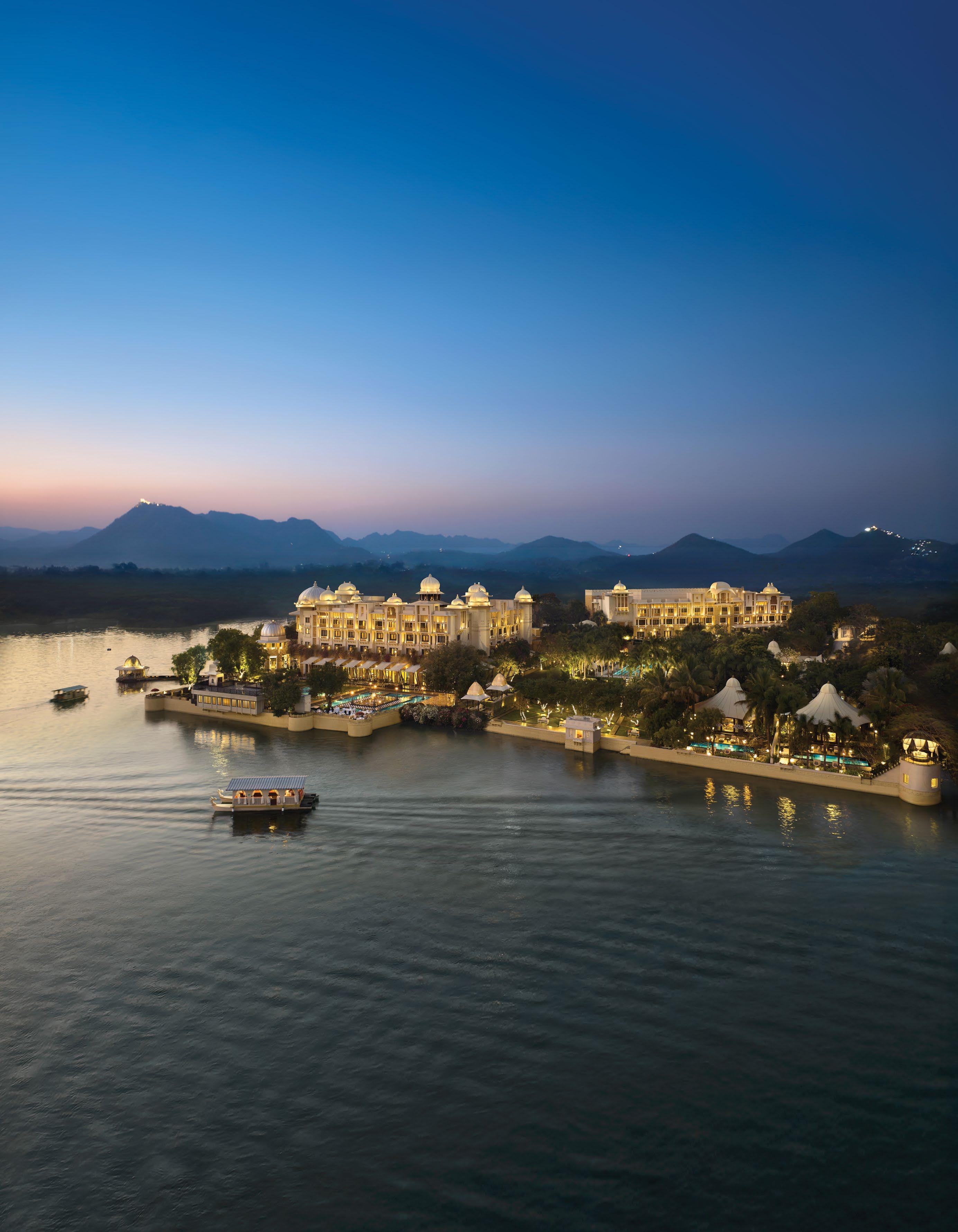







Taj Lake Palace, Udaipur

FOUNDER'S NOTE
THE ART OF PAUSE
There’s a rhythm to the world we rarely listen to anymore.
The rhythm of stillness between seasons, of breath between words, of silence between one journey and the next. Somewhere between the last rain and the first chill of winter, October arrives softly — not as an event, but as an invitation. To pause. To breathe. To slow down.
In an industry that thrives on motion — constant travel, new openings, endless reinvention — the idea of slowing down feels almost radical. Yet that is where true luxury begins. Because hospitality, at its essence, isn’t about offering more. It’s about creating space — for rest, reflection, and reconnection.
We often talk about luxury in terms of experience — design, detail, craftsmanship, and curation. But what if the rarest luxury of our time is the pause itself? The ability to step away from the noise, to be fully present, to rediscover the texture of time. As the world accelerates — powered by technology, trends, and perpetual novelty — the most forward-thinking hotels, resorts, and travel brands are rediscovering the value of slowness.
In design, this philosophy translates into spaces that calm the nervous system — rooms that hold you instead of overwhelming you. In wellness, it’s the idea that true rejuvenation comes not from indulgence, but from the quiet return to one’s own rhythm. In leadership, it’s the wisdom to understand that reflection is not inaction, but an essential part of clarity and creativity.
The best in hospitality today are not chasing speed; they are crafting meaning. They are learning that the guest experience is not built on constant stimulation, but on emotional intelligence — on the quiet luxury of feeling seen, safe, and still.
Perhaps this is why the most resonant destinations today are not the loudest or the most visible. They are the ones that give travellers something rare — a sense of time stretching gently, unhurriedly. A pause that allows them to remember themselves.
Across the world, this quiet shift is taking shape. Hotels are learning to design not just for aesthetics but
for emotion — rooms that exhale calm, courtyards that invite silence, rituals that make time feel generous again. The best experiences no longer shout for attention; they whisper it. They remind us that hospitality, at its most soulful, is about how we make people feel when everything else falls away.
The art of pause is not the absence of progress — it’s the mastery of rhythm.
The way a designer lets light breathe through space.
The way a chef allows an ingredient its full moment.
The way a host senses when to step back, letting solitude speak.
October carries that energy beautifully. It’s a month suspended between endings and beginnings — a moment of equilibrium before the rush of celebration. The air turns lighter, the light turns warmer, and the world seems to take a breath before everything comes alive again.
In hospitality, we often chase motion — new ideas, new stories, new beginnings. But reflection has its own quiet power. The pause gives creativity room to breathe and reminds us why we build, design, and serve.
Some of the most visionary brands today are embracing this stillness — slowing the tempo, deepening their narrative, creating experiences that honour emotion over excess. They understand that modern travellers are not chasing novelty; they are seeking meaning.
As Diwali nears, we find ourselves surrounded by the poetry of light — not just in celebration, but in renewal. It is the reminder that illumination often begins in silence, that brilliance is born in stillness, and that the most beautiful things in life — like light itself — need darkness to glow.
So, as we enter this luminous month, may we all find our own moments of pause — in quiet mornings, in warm hospitality, in the spaces that hold us with grace. Because the art of pause is, ultimately, the art of presence.
And presence, as ever, is the purest form of light — and the finest expression of luxury.

May this Diwali bring you light, stillness, and time to simply be.
GURMEET KAUR SACHDEV gurmeetsachdev@soulinkkworldwidemedia.com
THE NEW INDIA OF TRAVEL, HOTELS, AND COCKTAILS
From Wayanad’s lush forests to Puri’s sun-streaked beaches, from Gangtok’s icy Himalayan heights to Sindhudurg’s tranquil coast, India’s travel and hospitality map is expanding beyond traditional routes. What was once a linear itinerary—metros for business, Goa, the Himalayas, the Golden Triangle, and Rajasthan for leisure, Haridwar and Vaishno Devi for religious travel— is now a circuitous journey across beaches, hills, industrial towns, and tea estates. SOH’s October cover story explores these emerging destinations, uncovering what draws travellers and how hoteliers are setting themselves apart.
Tired of Picante, which has seemingly taken over bars? India’s bar scene is transforming. Fluorescent, sugary drinks are giving way to spirit-forward, narrative-driven cocktails. Our drink feature delves into how storytelling is shaping India’s cocktail culture, with bartenders acting as both alchemists and narrators, crafting curated experiences that linger far beyond the glass.
Much like bars, hotel lobbies are evolving into immersive theatres of identity and experience. From the grandeur of the Taj Mahal Palace and The LaLit Mumbai to modern hubs featuring layered spatial experiences, sabering ceremonies, vibrant art, and afternoon teas, lobbies now blend art, culture, and commerce. Our article explores this transformation in new-age hotel spaces.
Elsewhere in the edition, discover the rising trend of microcations, meet the people behind the seamless running of hotels, and follow Satish Gogineni, the first Indian to ski solo to the South Pole.
Dive into this edition and experience how India’s hospitality and leisure landscapes are reinventing themselves—one story, one destination, one cocktail at a time.
Warm regards,
DEEPALI NANDWANI, EDITOR, SOH
Founder and Publisher Gurmeet Sachdev
Editorial
Editor Deepali Nandwani
Managing Editor Rupali Sebastian
Contributing Editor Suman Tarafdar
Digital Editor Rachna Virdi
Contributing Writer Chandreyi Bandyopadhyay
Creative
Creative Director Tanvi Shah
Team Shiv Soni
Contributing Artist
Illustrator: Govinda Sao
Business Head
Vipin Yadav Delhi, +91 99998 85515 vipin@soulinkkworldwidemedia.com
Sales Manager Deepa Rao Mumbai, +91 9136 000369 sales@soulinkkworldwidemedia.com
Head of Events and Alliances Karishma Shah karishma@soulinkkworldwidemedia.com
Office Manager Deepak Rao
Accounts Head Amey Acharekar
For queries: editorial@soulinkkworldwidemedia.com sales@soulinkkworldwidemedia.com info@soulinkkworldwidemedia.com
Printed and Published by Gurmeet Sachdev on behalf of Soulinkk World-Wide Media LLP. Registered office: 1/2, Old Anand Nagar, Nehru Road, Santacruz East, Mumbai, Maharashtra - 400055. Printed at Silverpoint Press Pvt. Ltd., A-403, TTC Industrial Area, Near Anthony Motors, Mahape, Navi Mumbai – 400709. Editor: Deepali Nandwani. All rights reserved worldwide. Reproducing in any manner without prior written permission prohibited. SOH takes no responsibility for unsolicited photographs or material all photographs, unless otherwise indicated, are used for illustrative purposes only. Unsolicited manuscripts will not be returned unless accompanied by a postage pre-paid envelope. All disputes are subject to the exclusive jurisdiction of competent courts and forums in Mumbai only. Copyright Soulinkk World-Wide Media LLP.
Introducing the era of interactive

cooking
CHEFTOP-X™ – The new hi-tech combi oven that speaks the chefs' language. Literally.

Unox India Pvt. Ltd. Unit No.10, 15th Floor, Tower 2, AIPL Business Club, Sector 62, Gurugram 122002 +91 124 4239367


Discover more about CHEFTOP-X™


OCTOBER ISSUE

40 Where India’s Next Travel Stories Are Unfolding From lesser-known valleys to spiritual towns and secondary cities, new destinations are drawing travellers and hospitality brands through immersive, culturally rooted, and wellness-driven experiences.


12
Edge of Endurance Satish Gogineni is India’s first solo South Pole skier.


104
Brief but Beautiful Short getaways offer ease, escape, and emotional recharge.

18
Flavour Meets Story At Radisson Goregaon, Goma drives culinaryled success.

70
The New Welcome Hotel lobbies become immersive stages for brand and belonging.

64
Grace and Getaways
Malaika Arora merges style, strength, and soulful travel.

24
Soulful Goan Sanctuary
Solene Moira blends slow luxury with global flavours.
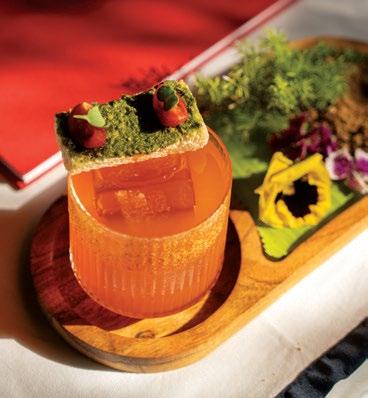
84
Spirit Notes India’s cocktail bars blend flavour, flair, narrative and craft.
32
Legacy in Bloom Heritage Village Manesar blends history, hospitality, and renewal.



As Satish Gogineni stood staring at the shifting white horizon of the South Pole—a featureless expanse of snow and ice, miles thick, stretching endlessly—he felt both humility and determination. "On a snowswept plateau or scaling a peak, you constantly realise nature is far more powerful than you. You can’t fight it; you have to respect it, adapt to it. But along with respect, you need grit. Moments will come when everything in your body and mind wants to quit,” he says.
DIARIES OF A SOLO ADVENTURER


DEEPALI NANDWANI
From scaling Mt. Everest to skiing solo across the South Pole, Satish Gogineni pushes the very edge of human endurance.

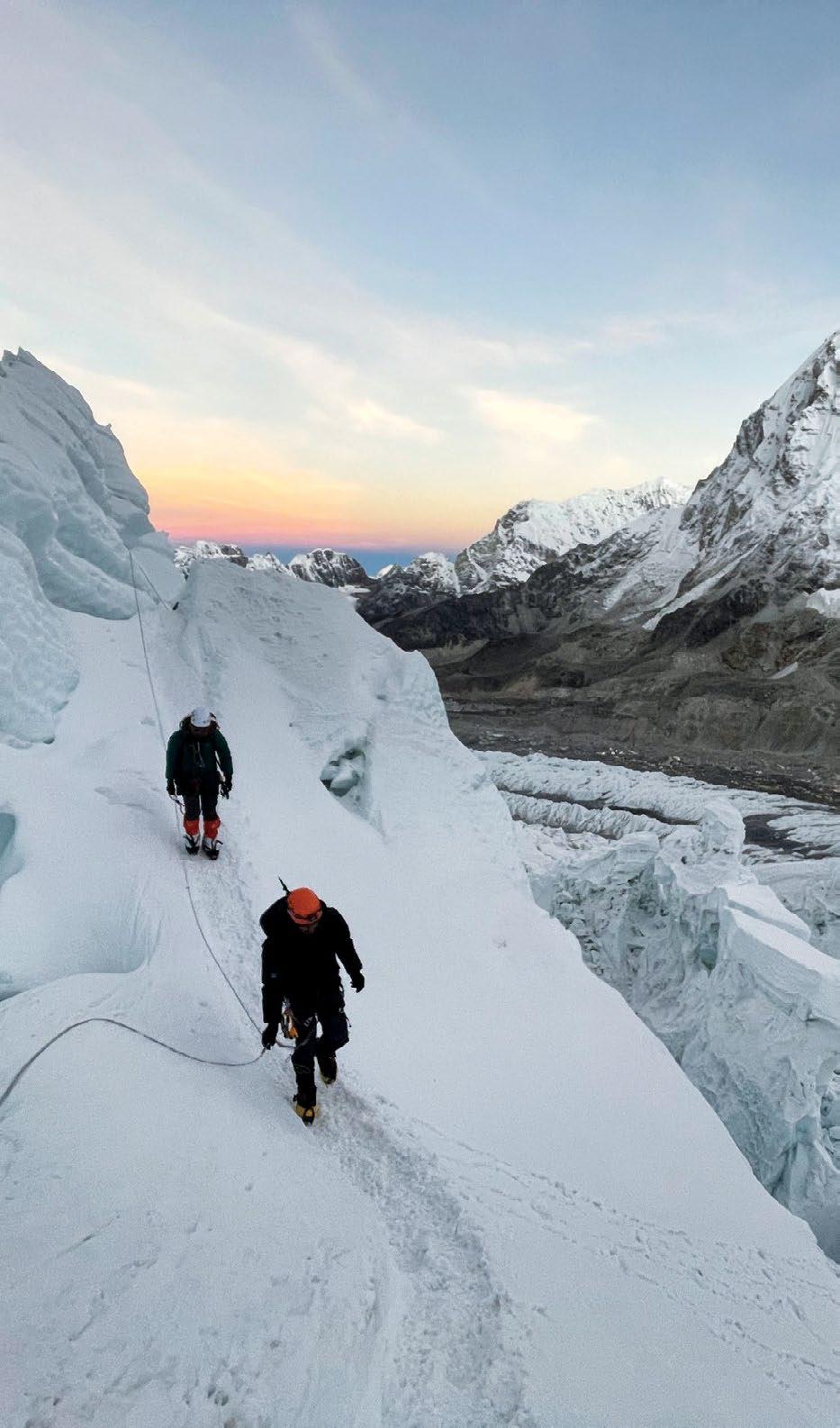
In January 2025, the Hyderabadborn adventurer became the first Indian to ski solo and unsupported to the South Pole. He completed a gruelling 1,133 km across Antarctica in 51 days. A highaltitude mountaineer, endurance athlete, polar explorer, and fulltime adventurer, Gogineni is also the fastest Indian to summit Mt. Everest and Mt. Lhotse in under 19 hours. He is the second Indian to ski across Greenland’s ice sheet. Next on his agenda is a 2026 Antarctica expedition, which he describes as "harder, longer, and
far more complex than anything I’ve ever done before."
His life as an adventurer began in his 30s in California. “It began with simple curiosity—hiking turned into summits, and summits turned into something deeper.
Climbing Mount Whitney was the turning point. After that, I sought bigger challenges, trained seriously, and learned what it really means to move in the mountains. That climb showed me how much endurance is mental. It wasn’t sudden—it was a slow pull towards my purpose,” he says.



ABOVE: Gogineni’s first polar exposure came after years of mountaineering.
ABOVE RIGHT AND RIGHT: The real summit is what the mountains reveal about a person, says the adventurer.
FROM RIGHT:

What we don’t understand about mountains
Many view mountains as obstacles to be conquered. “They’re not obstacles; they’re teachers. The real summit isn’t the peak—it’s what the mountain reveals about you. Mountains strip away ego, expose fear, and demand patience. Sometimes the hardest lessons come when you have to turn back.”
Exploring the polar regions
Gogineni’s first polar exposure came after years of mountaineering. “I wanted a new frontier—colder, purer, more isolating. The poles held a mystery. I trained in Baffin Island and Greenland, learning to use polar skis and techniques for cold survival. When ALE (Antarctica Logistics Expedition) offered the chance, I had to try it.”
His solo South Pole expedition, Project Spandana, pushed the edges of isolation and resilience.

“It was more than adventure; it was carrying my mother’s and cousin’s memories, turning loss into something that could help others. Physically, I trained hard—dragging sleds, endurance work, cold prep. Mentally, I practiced solitude, stripped distractions, built comfort with silence, because many hours
would be spent alone with just my thoughts.”
On the journey, he faced storms, whiteouts, treacherous terrain, fatigue, cold, and hunger. “Some days, progress felt impossible. What pulled me through was remembering why I was there. I broke the big goal into small


CLOCKWISE
Gogineni is the first Indian to ski solo and unsupported to the South Pole; moving in the mountains tests mental endurance; mountains strip away ego, says the adventurer.



THIS PAGE: On a solo trip, such as Gogineni's South Pole expedition, the adventurer had to face storms, a treacherous terrain, fatigue, cold, and hunger.
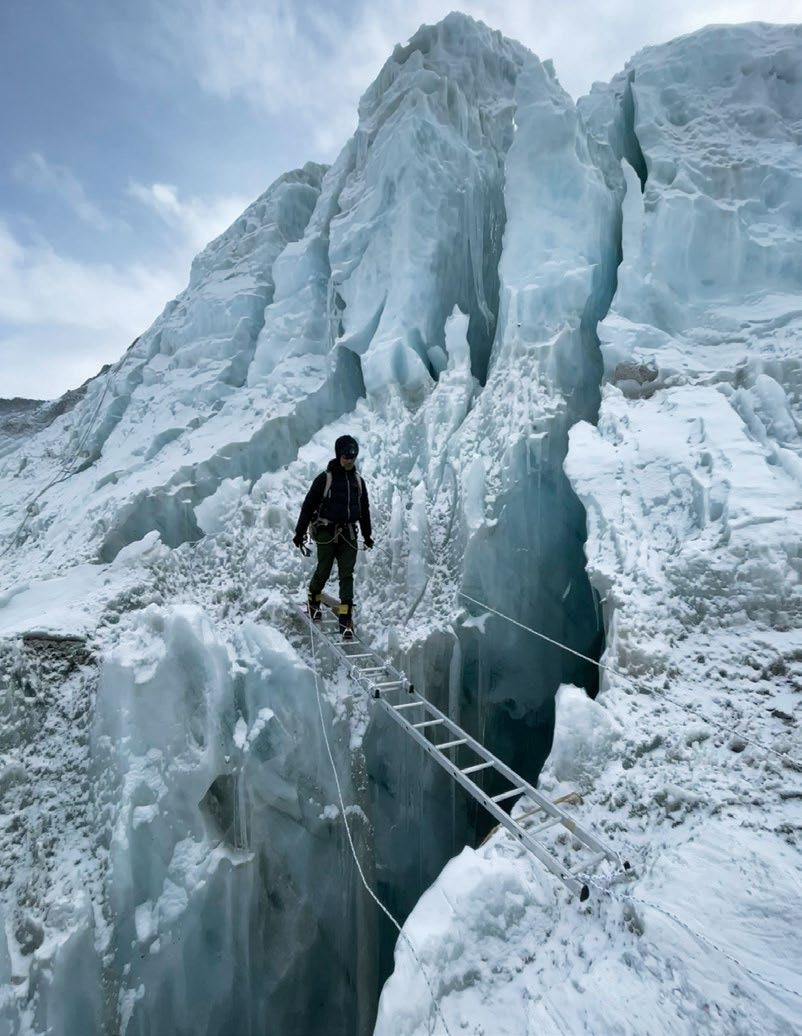
wins: make camp, melt snow, stay warm, keep moving.”
A typical day: wake at 6am, melt snow, eat a calorie-dense breakfast, break camp by 8am, then ski for one hour, rest for ten minutes— repeat until 9pm. “Each hour felt

the same—just white horizon, wind, and skis.”
What solitude teaches
“You find more strength within you than you imagine. Stripped of distractions, you confront fear, doubt, and vulnerability— but also patience, clarity, and calm. Solitude became a mirror: I saw grief, perseverance, and a sense of peace I didn’t know I could hold.”
What we don’t know about the South Pole
It isn’t just a point on the map.
“Being there is surreal—extreme yet still. The geographic marker moves yearly because the ice sheet shifts. There’s no wildlife, no trees, no noise—just pure silence and -30°C winds. Even your breath sounds loud. And standing at the bottom of the earth doesn’t feel like conquering—it feels like being allowed in.”
The vastness and silence of Antarctica were overwhelming. “It was a stillness that forces you inward. It felt like standing inside a marshmallow, coming face-to-face with yourself. Peaceful, haunting, unforgettable.”






























At Radisson Mumbai Goregaon, food and beverage revenue now outpaces rooms. At the heart of this success is Goma, where heritage, seasonal ingredients, and thoughtful storytelling turn every dish into an experience.

GOMA’S PAN-ASIAN
DEEPALI NANDWANI
CLOCKWISE FROM FAR LEFT: Veteran of Pan-Asian cuisine, Chef Sadiq Khan curates the menu at Goma; the bar echoes the philosophy of the food; modern materials join hands with Asian influences in the restaurant's interiors.

Ingredients are selected for purity and authenticity, not experimentation.
BELOW: A chandelier, striking and resplendent, anchors the restaurant spatially.

How many hotels can boast F&B revenues that outstrip those from rooms, even by a fraction? Radisson Mumbai Goregaon does—its F&B formats account for 60% of revenue, against 40% from rooms. At the heart of this success is Goma, a pan-Asian restaurant offering a cross-section of the region’s cuisines.
In Japanese, Goma means sesame seeds, a staple in sushi, salads, and dressings. “We make a lot of salads with sesame dressings,” says head chef Sadiq Khan.
The genesis
Goma’s concept took shape in late 2021. “Most good pan-Asian and Japanese restaurants were in South Mumbai or, at best, Bandra. For those living between Bandra and Dahisar, dining at one meant driving all the way to BKC,” says Ajoy Balkrishna, Vice President –Hospitality, Balwa Group.
To fill this gap, the group brought in Chef Sadiq Khan, four decades in pan-Asian cuisine, working at Wasabi at The Taj Mahal Palace, Mumbai, and Golden

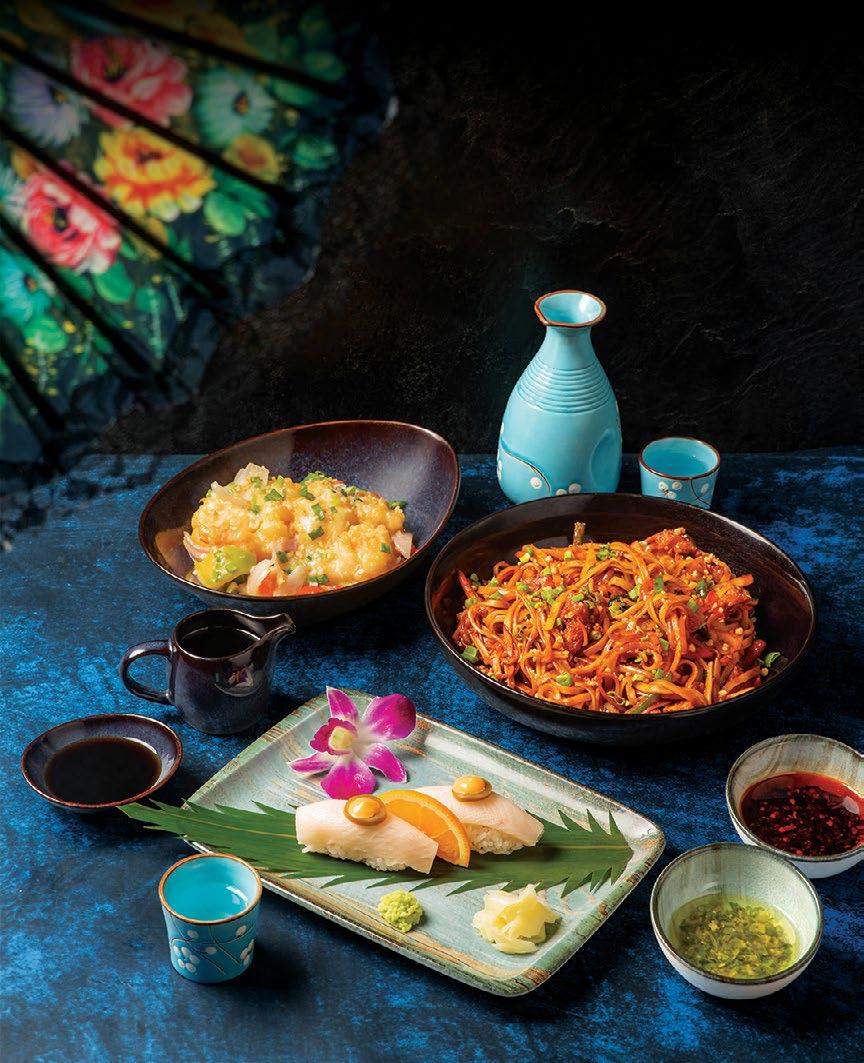
Dragon. He started a three-month consulting project for Goma and continues three years later, curating the menu and guiding the kitchen.
The interiors
Designed by Grey Matters Studio, the space features a bold, artistic chandelier as a spatial highlight. Warm ambient lighting, accent lights over the sushi bar and grill, and a play of light and shadows create luxury and spaciousness. Modern materials—polished wood, glass, metal—blend with Asian influences: minimalist Japanese lines, earthy Thai textures, and Chinese motifs. The sesameinspired palette emphasises neutral tones and understated elegance, complemented by carefully tuned music.
Food and its heritage
Quality sourcing is central: imported fish and local produce are chosen for purity, not experimentation. The bar mirrors this ethos—cocktails
ABOVE LEFT TO RIGHT:
and mocktails use loose-leaf teas and a farm-to-glass approach. “Nothing is synthetic; syrups and concoctions are freshly prepared daily. The bar complements the food in philosophy and flavour,” says Balkrishna. Menus evolve seasonally while classics remain— sushi, Pol Salad, Lupi Rice, and signature dishes such as blanched spinach with sesame sauce.
The tasting experience
Blanched Spinach with Sesame Seeds, from Japan’s Shikoku island, is lightly seasoned and dressed with roasted sesame, rice vinegar, and a hint of evaporated milk. “It’s an Indian-Asian adaptation balancing sour, spicy, and sweet,” says Chef
Sadiq. Seasonality guides the menu, and every dish reflects Japan’s layered culinary influences. “Even tempura came from the Portuguese; the Japanese adapted it with coldwater batter for crisp exteriors and tender interiors,” he explains.
Tom Kha Soup tells another story. “Though Thailand claims it, Tom Kha originated in Laos,” says the chef. At Goma, lemongrass, chili, coconut milk, and vinegar balance tang and sweetness. Vegetarian fare makes up half the menu, with sushi and dim sums as bestsellers. Avocado rolls, cucumber-cream cheese, and tofu-wrapped sushi appeal to those avoiding seaweed. Thai curries and soups also resonate locally.
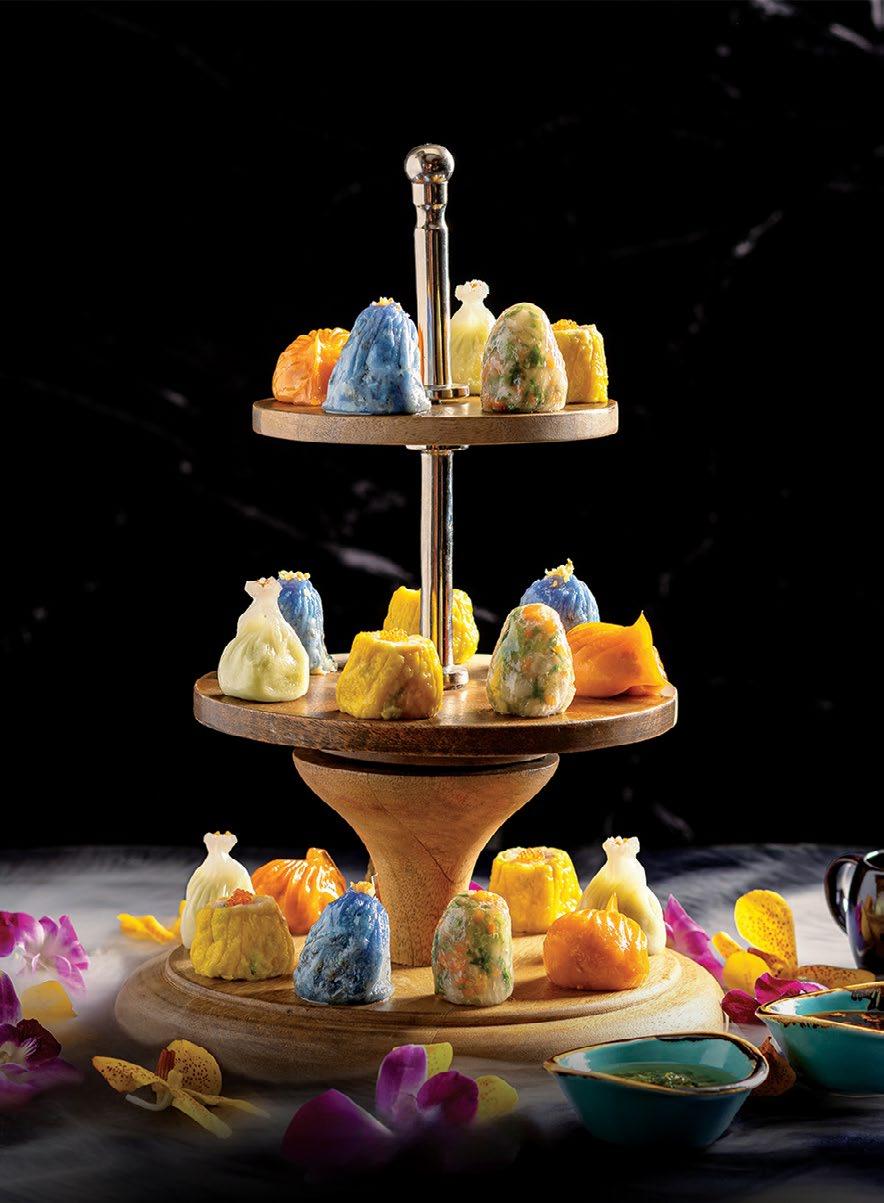

Black rice and robatayaki
For the black rice, once reserved for Chinese emperors, he uses Manipur’s short-grain variety. Stir-fried with garlic and Korean chili, it’s chewy, slightly sweet, and satisfying. Robatayaki dishes, like charcoal-grilled sweet potato dusted with Togarashi and paired with yuzu cream, showcase starch, spice, and citrus in one bite.
Balancing familiar and new
“When we first opened, 85–90% of the menu was experimental. Guests hesitated. Now it’s fiftyfifty—half familiar, half unusual,” says Chef Sadiq. Misconceptions about Japanese food persist; Kyoto’s vegetarian temple cuisine is overshadowed by sashimi perceptions. White Fish Carpaccio—a dish born in Venice in the 1950s—is prepared at Goma with sashimi-grade red snapper, yuzu soy, sesame-infused olive oil, and soy–yuzu sauce.

TOP: Goma features a variety of dim sums, reimagined with a twist.
ABOVE: The bar at the restaurant dispenses an array of drinks following the farm-to-glass approach.

Sushi etiquette is carefully taught: vinegared rice can be rolled with vegetables, egg, or seafood— raw, cured, or cooked. Nigiri, rolls, maki—they’re all sushi. Soy should touch lightly; wasabi is tasted separately, and gari cleanses the palate. Sushi can be eaten with fingers, the way it is done in Japan.
Dim sums with a twist
Black garlic and poached-water dim sums showcase precision and story. Black garlic, aged under high humidity, turns glossy and sweet, and is paired with ginger–onion sauce. Poached-water dim sums, with mushrooms, cheese, and vegetables, are timed carefully for perfect texture. “Every food has

a story,” says the chef, noting that storytelling connects dishes to their history.
The storyteller’s passion
Chef Sadiq’s passion for cooking began in childhood—his Chinese mother, and grandfather taught him how to make steamed bao. “I woke to the smell of yeast and bread mingling with meat. Breakfast began with fresh bao. That’s where it started,” he recalls.


CLOCKWISE FROM TOP LEFT: Seasonality guides the entire menu; authentic drinks are paired with food rich on story-telling; Goma's offerings balance the familiar and the experimental; vegetarian dishes make up almost half of the menu.

At Goma, ingredients, design, stories, and service converge to create an experience both authentic and approachable. It’s about food, context, and culture. In a hotel where F&B drives revenue, Goma proves that heritage-rooted cuisine, thoughtfully presented, can outshine even the rooms upstairs.


DASTARKHWAN: QISSAS AND RECIPES FROM RAMPUR
TARANA HUSAIN KHAN
A poignant blend of personal anecdotes, oral histories, and cultural narratives from the princely state of Rampur, the book explores how colonial and regional influences shaped Rampuri cusine. Khan weaves political history with everyday culinary stories, making it essential for understanding India's layered food heritage. The book shines as a narrative tapestry, exploring how food reflects identity, politics, and community in a region known for its aromatic biryanis and kebabs.
B OO KS

AMMI’S KITCHEN: HEIRLOOM RECIPES FROM RAMPUR
PERNIA QURESHI
Pernia Qureshi’s cookbook traces its origins to the hearth of her grandmother, Mussharaf-ul-Nissa Begum—affectionately known as Ammi. A resilient young bride from the modest town of Chandausi in Uttar Pradesh married into the opulent world of the princely state of Rampur, Ammi ingeniously fused the hearty, spice-laden home cooking of her youth with the refined, aromatic courtly cuisine of Rampur. These innovations, meticulously documented in handwritten notebooks, evolved, over decades, into the cornerstone of the Qureshi family’s Rampur Kitchen restaurant. The legacy extended further when Pernia’s sister, Sylvia Moin started Ammi’s Kitchen, a home-based food delivery service. Now, in their most cherished incarnation, these heirloom recipes form a collection of over 50 dishes.
BAZAAR BITES: TALES AND TASTES OF INDIA’S STREET FOODS

PRIYA BALA AND JAYANTH NARAYANAN
Across India’s streets and bustling chowks, food is not just sustenance—it is memory, heritage, and survival. Bazaar Bites captures this spirit across 40 cities, from Srinagar’s lotus stem fritters to Kottakal’s avil milk and Davangere’s benne dose, treating street food as a living archive of communities, flavours, and histories. Each chapter spotlights a city’s iconic snacks— jalebi and warm milk in Jodhpur, Hubli’s papdi-chutney, Mumbai’s vada pav—and the hands behind them. Vendors, often keepers of generational recipes, emerge as central characters.
Part travelogue, part cultural chronicle, the book meanders through India’s gullies and beaches, gently reflecting on how street food shapes neighbourhoods and binds local communities.




ON THE HIMALAYAN TRAIL: RECIPES AND STORIES FROM KASHMIR TO LADAKH
ROMY GILL
This vibrant culinary travelogue, written by Romy Gill MBE, a British-Indian chef, food writer, broadcaster, and regular on BBC's Ready Steady Cook and BBC Radio 4's The Food Programme blends personal storytelling, cultural history, and over 80 recipes inspired by the regions of Kashmir and Ladakh. The book transports the readers through the spice-laden markets of Kashmir to high-altitude monasteries, and features local cooks, nomads, and families. The recipes, woven into a narrative, focuses more on the ‘why’ behind the dishes—their ties to local landscapes, traditions, and people— making it a compelling read.




FROM THE KING’S TABLE TO THE STREETS
PUSHPESH PANT
Delhi’s cuisine is inseparable from its turbulent history. In From the King’s Table to Street Food, historian and food critic Pushpesh Pant traces how dynasties— from the Sultanate and Mughals to the British Raj—shaped the city’s palate. While Delhi is now synonymous with butter chicken and biryani, it is equally a melting pot of Kashmiri, Bengali, Bihari, Andhra, Naga, and Indo-Chinese fare. Pant explores royal kitchens that fed thousands, the grandeur of Tughlak courts, Sufi langars, and the city’s early eateries. Rich with detail, his account situates Delhi’s food as both cultural memory and living tradition.
MANGIFERA INDICA: A BIOGRAPHY OF THE MANGO
SOPAN JOSHI
Journalist Sopan Joshi explores India’s beloved fruit through history, ecology, economics, and culture. Woven with personal anecdotes—like his uncle’s playful ‘mango juice!’ refrain—the book traces mango’s role in politics, memory, and daily life. Joshi journeys to orchards, markets, and research farms, uncovering stories of farmers like T. Chandrasekhar Reddy in Andhra Pradesh, who conserves traditional varieties while cultivating commercial Totapuri for pulp. From shy-bearer delicacies like Imam Pasand to humble naati varieties used in pickles, Joshi’s vivid reportage reveals how the mango shapes livelihoods, landscapes, and India’s collective imagination.
GOA’S NEW LUXURY LANDMARK
In Moira’s slow lane, a boutique private member’s club and a restaurant inspired by the Silk Route countries, redefines Goan luxury.
DEEPALI NANDWANI


In the quiet, leafy lanes of Moira —one of Goa’s many susegad villages—time moves slowly. Doors are left unlocked, neighbours chat across balustrades, and on warm nights, people still sleep outside on their balconies. It is this sense of community and unhurried living that inspired the Isprava Group to choose the languid village as the home for Solene Moira, a luxurious members-only club that blends heritage architecture with contemporary design and modern hospitality, and a restaurant, Mister Merchant's.
Housed in the carefully restored 115-year-old de Souza family estate, Solene is the Isprava Group’s first foray into private clubs. Brothers Nibhrant Shah, Managing Director, and Dhimaan Shah, Executive Director, and co-CEOs of Isprava Group believe there couldn’t have been a better debut destination. “Goa has always been known for its sense of community and its slower, more meaningful pace of life. We saw a growing appetite for spaces that
RIGHT: A restored 115-year-old estate, Solene Moira marries heritage grandeur with contemporary luxury.
BELOW: Bar 507 is a mood-lit den for drinks and conversations.
SIP SMART, STAY STYLISH
SAROVAR PORTICO SRIPERUMBUDUR GOES SINGLE USE PLASTIC-FREE
Where sustainability meets next-gen comfort
At Sarovar Portico, Sriperumbudur, sustainability isn’t a buzzword—it’s a lifestyle. This modern haven redefines what it means to travel responsibly, blending cool design with conscious innovation. Here, every detail, from construction to comfort, is built on the promise of a greener tomorrow.
The Star of the show? The hotel’s in-room purified RO water dispensers—a game-changer in eco-luxury. Gone are the days of plastic bottles cluttering your stay. Instead, each room offers crisp, chilled water (at a refreshing 12°C) straight from a 1000 LPH stainlesssteel RO system. With a smart hydro-pneumatic circulation setup, every sip is freshly purified, maintaining perfect balance at 80 ppm TDS and pH 7.2–7.6. It’s hydration that’s as good for you as it is for the plane —pure, seamless, and 100% single use plastic free.
Beyond the glass, the hotel runs on solar energy, reuses greywater for landscaping, crafts biodegradable amenities, and even transforms waste sludge into organic manure. Their zero-waste F&B program reimagines cocktails and dining with creativity and conscience—think mindful meals and zero-waste mixology that taste as good as they feel.
This is hospitality evolved— where innovation, wellness, and sustainability intertwine. For the modern traveller who cares as much about their footprint as their comfort, Sarovar Portico Sriperumbudur is more than a stay. It’s a movement—one refill at a time.
Raise your glass, skip the plastic, and sip the future

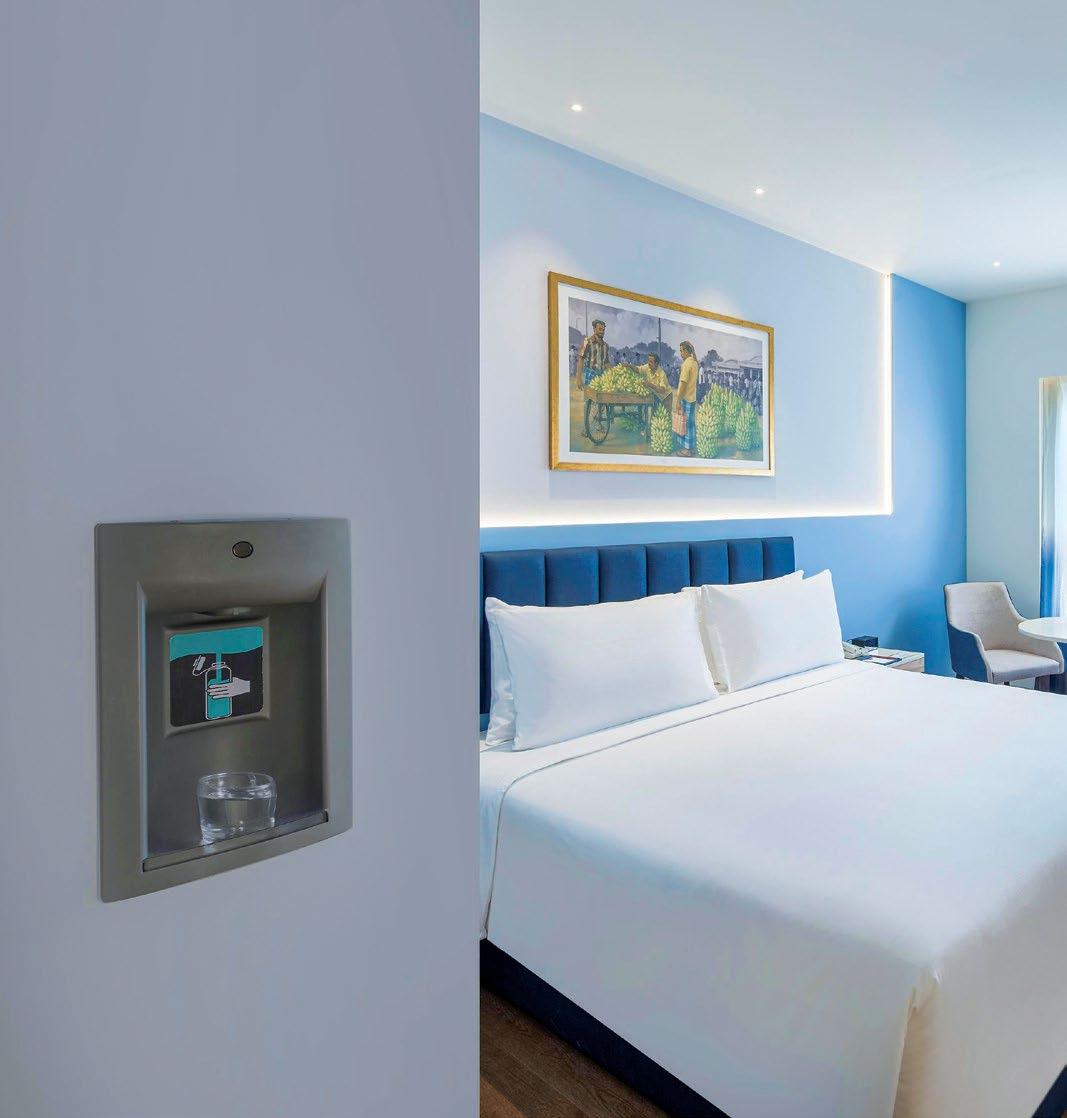

CLOCKWISE FROM ABOVE: Nibhrant and Dhimaan Shah, co-CEOs, Isprava; The Orangerie is a vibrant glasshouse-style restaurant; food at Solene spans familiar fare, while Mister Merchant's serves dishes inspired by countries along the Silk Route.
go beyond hospitality and become communities in themselves.”
A house with a soul
The brothers insist Solene was never about acquiring just any piece of land. They wanted “a space with a soul.” The de Souza estate, with its history and legacy, fit perfectly. “The location is steeped in charm, tied to the de Souza family’s story. Restoring it was as much about honouring the past as it was about creating a new cultural hub,” say the brothers.
The restoration pays homage to the estate’s original grandeur. Deep-polished wood, soaring ceilings, intricate wainscoting, and bold prints are paired with bespoke furnishings and vintage finds. “We layered rich textures and handcrafted details, some sourced from the de Souza family and others from local markets,” the Shahs explain. The result is a space that feels timeless and contemporary—respectful of heritage yet firmly rooted in modern luxury.

A
private sanctuary Solene positions itself as a private sanctuary where community and culture take centerstage. Its ambience is curated yet relaxed, intimate yet cosmopolitan.
“Globally, there’s a new wave of smaller, community-focused clubs that feel like extensions of one’s living room, but carry the energy of a cultural salon,” says Nibhrant. “That’s what we wanted Solene to embody.”
At the heart of the club is Bar 507, a mood-lit den designed for evening drinks and conversations.
The Orangerie, a bright, glasshousestyle restaurant, brings a breezy connection to nature, serving global classics with Goan accents—think chorizo pizza or the playful cocktail O La Do Chorizo. Clementina’s Garden, once a humble cowshed, has been transformed into a lush alfresco venue perfect for long, leisurely meals under the sky.
Beyond dining, Solene offers a wellness centre with a gym, sauna, steam, spa, cold plunge, landscaped
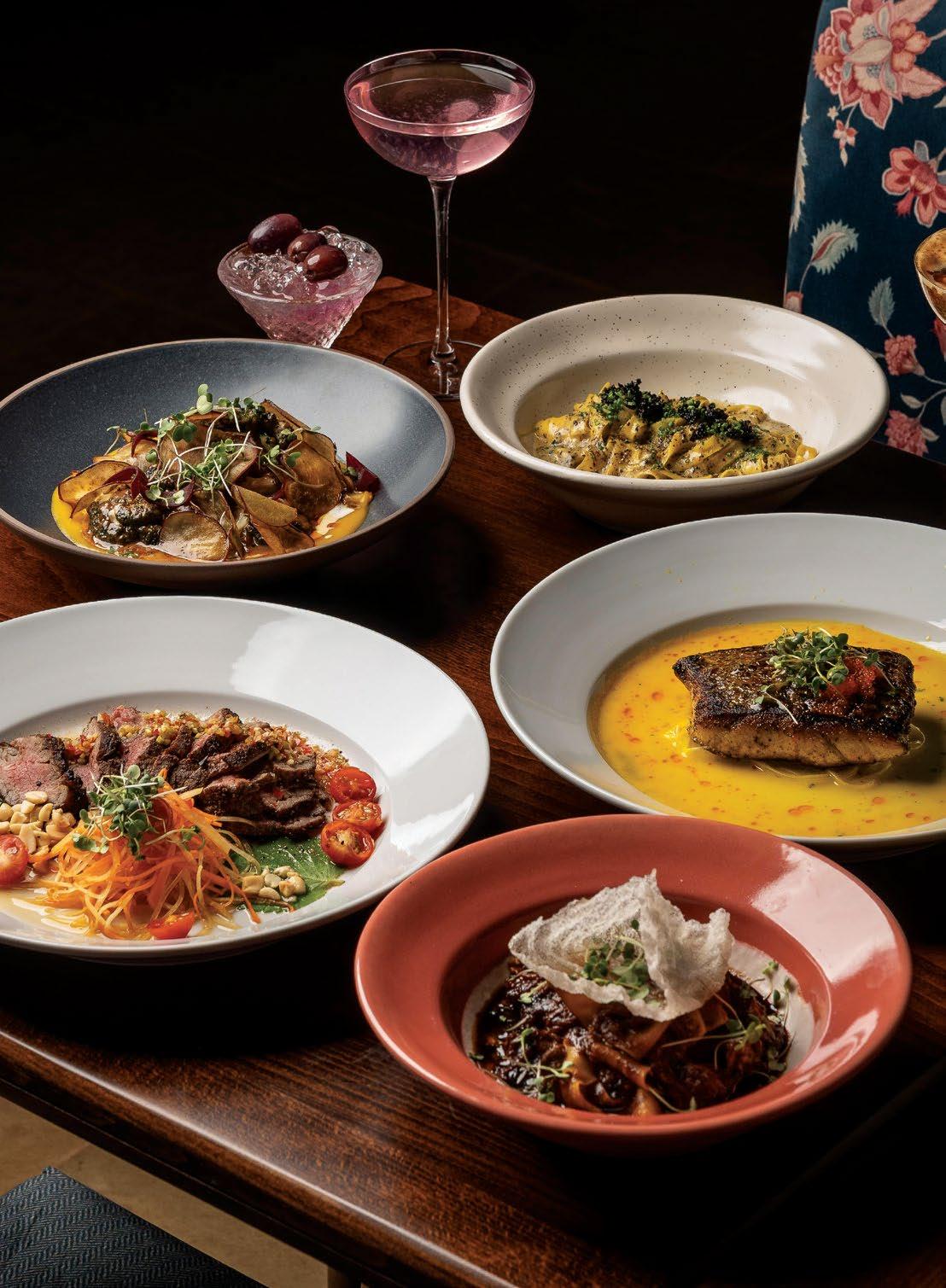





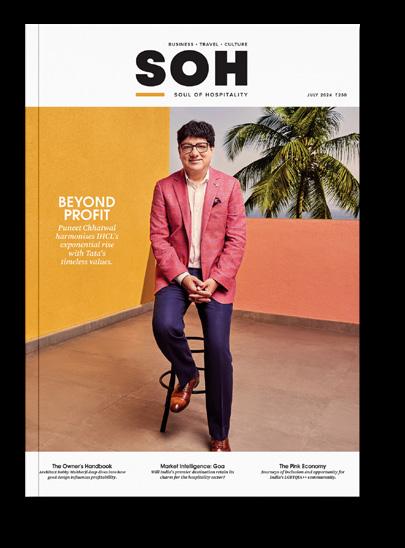

gardens, a toddlers’ outhouse, and an outdoor play area. And in a nod to India’s latest sporting obsession, it even features a dedicated pickleball court to cater to the rage for the game in India’s urban centre.
The real soul of Solene, however, lies in its programming. The club curates events that celebrate the local while connecting to global trends. “Our calendar is hyperlocal and bespoke—chef’s tables with regional produce, intimate performances, wellness residencies, and artist-led workshops,” say the Shahs. Tastemaker sessions introduce members to whisky, agave, mushrooms, and Goa’s native spirit, feni.
Evenings might feature jazz collectives from Goa, vinyl storytelling, or poetry readings. Members can expect film screenings, artisan workshops, chef and bar takeovers, and even

pickleball tournaments. “It’s about creating a rhythm of community that evolves with the seasons.”
Comfort at the club
For members, the all-day club menu offers simple comfort food: Benedicts, truffle pasta, roast chicken, pizzas, burgers, steaks, sandwiches—easy, familiar dishes designed for breakfast, business lunches, or relaxed dinners. “It’s important to keep the club offering approachable, something that works for different times of day,” Chef Rahul 'Picu' Gomes Pereira explains.
Mister Merchant’s: The travellers den
Mister Merchant’s, by contrast, allows him to push boundaries, explore inspirations, and build narratives through food. While the club remains exclusive to members, Pass Code Hospitality’s Mister Merchant’s is open to all. Conceptualised as the den of a


fictional traveller—“who journeys with spices, notebooks, and Rumi in his suitcase”—it offers a bold culinary perspective inspired by the Silk Road.
Chef Pereira views Mister Merchant's as both personal and expansive. “It’s not about recreating Middle Eastern clichés. The menu draws from the vast regions of Central Asia, North Africa, and the old trade routes, capturing their diversity and depth.”
While the club's all-day café-style menu features simple comfort food, Mister Merchant's could be Pereira's fictional avatar as it is inspired by the chef's own travels. “I can imagine Mister Merchant holidaying in Kenya, so I would introduce flavours from there. The idea is not to be restricted, but to be inspired— by travel, ingredients, and flavour profiles. We aim for clean, simple yet distinctive Middle Eastern, North African, and Egyptian dishes.”
Here, the menu is a map: punchy mezze, smoky dips,
CLOCKWISE FROM ABOVE: Solene's well-appointed wellness centre includes a yoga programme and a pickleball court; Chef Rahul 'Picu' Gomes Pereira; Fish Mashwi pays a nod to the various grilled or roasted dishes found throughout the Middle East and North Africa.



grilled meats, pillowy breads, and slow-cooked dishes with soul. At the heart of it all? The Merchant Thal—a lavish, layered feast built for sharing.
Chef Pereira resists the label ‘Middle Eastern.’ “It’s a Westcoined term that reduces a vast, diverse region. Take Georgia, for instance—predominantly Catholic, with pork central to its cuisine. On our menu, we serve Mtsvadi, the Georgian barbecue grill, precisely to challenge those stereotypes.”
Authenticity anchors his approach. Most ingredients— sumac, za’atar, tarragon—are sourced from Dubai for quality. Yet he isn’t afraid of subtle, creative nods. Gunpowder Hummus marries Andhra Pradesh's fiery podi masala with the smoothness of traditional hummus. Among my favourites is Shotis Puri, a soft Georgian flatbread, reimagined with the texture of Goan poi, balancing the familiar with the exotic.
Among the oft-requested dishes are Egyptian Koshary, Za’atar lamb chops, Moroccan lamb
shank, Egyptian rice bowls, and Azerbaijani pilaf. The menu has come together organically, a sharp focus on authenticity rather than fusion, and yet, a chef’s twist that speaks his language. “I’m fine with the occasional nod—like the gunpowder hummus—but building an entire restaurant around fusion feels unnecessary,” he says. Then there is the Egyptian Koshary— “Even my welltravelled chef friends hadn’t tried it. Bringing such dishes here is more exciting than unnecessarily reinventing them.”
And the one dish that had to be reworked or refined? “The

Qutab,” says Chef Pereira. “We first served it as a flatbread, almost like a pizzette, but it was too heavy. People stopped ordering after that. We’ve since reimagined it—it’s now deconstructed, inspired slightly by East Indian fugias (little leavened batter dumplings). You can DIY with meats and toppings, which makes it more engaging.”
Opening in Moira, away from Goa’s tourist-heavy hubs, was a conscious choice. “We knew it wouldn’t be easy,” says Chef Pereira. “But the idea was never about quick wins—it’s about growing slowly, keeping the menu evolving, and staying true to the vision.”
For the Shahs, this vision is equally long-term. “Goa has always had a community-led culture,” says Nibhrant. “Solene is among the first to translate that into a formal members’ club. With a growing base of homeowners, seasonal residents, and globally minded Indians spending time here, we believe the foundation is strong for spaces that are exclusive yet rooted in community.”
In a state celebrated for its beaches and nightlife, Solene is offering something quieter and enduring: a club that feels intimate yet expansive, rooted in the old while shaping the new.
CLOCKWISE FROM ABOVE: The layered spatial narrative blends nostalgia with modern amenities; an agave-based drink, with a garnish of curry leaves; The Merchant Thal.
INDIA’S WELLNESS HERITAGE REIMAGINED FOR DIABETES CARE
At Ananda in the Himalayas, the wisdom of Ayurveda and yoga meets clinical precision to create a pioneering diabetes management programme for today’s global wellness traveller.
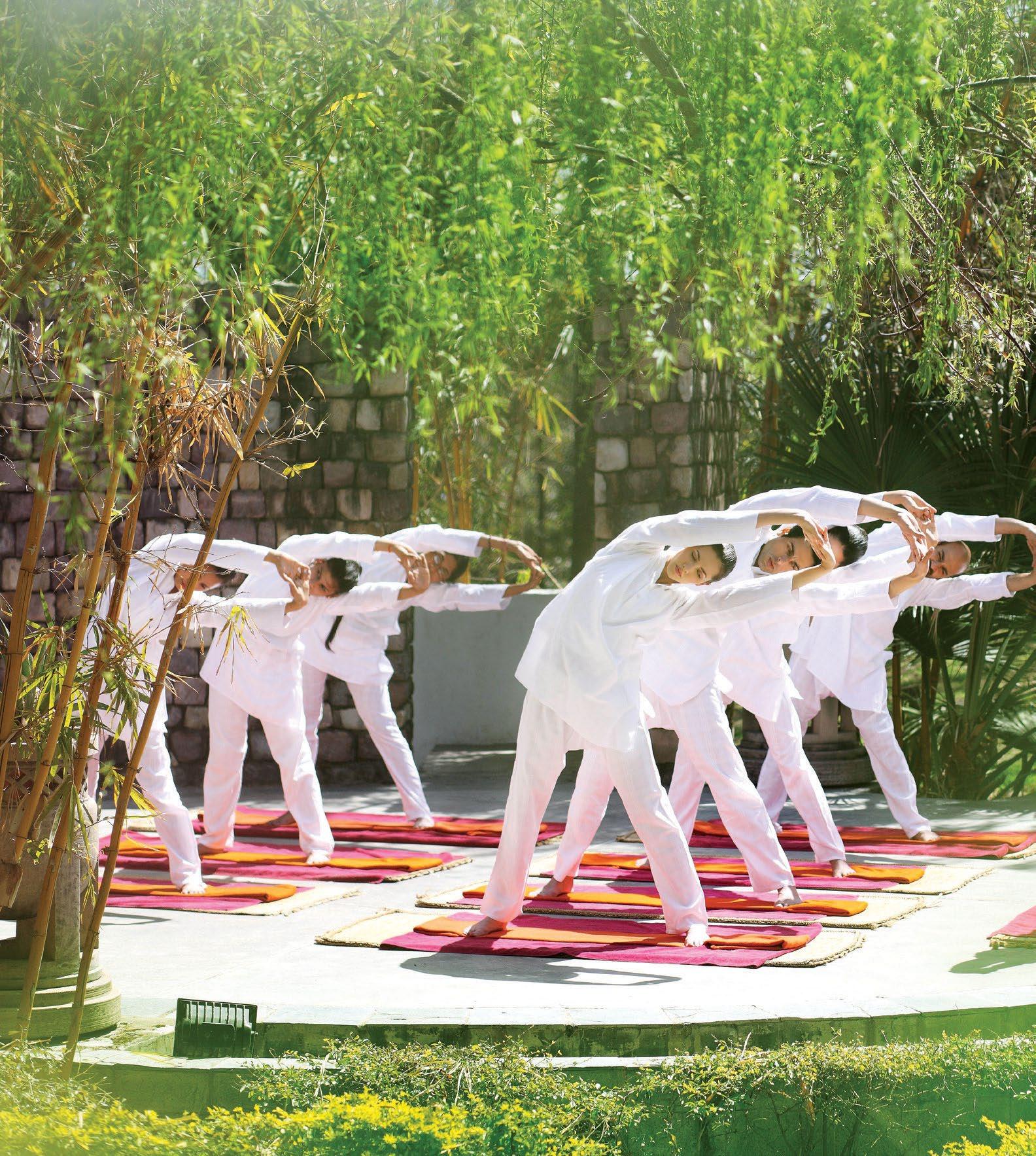



THIS SPREAD: From yoga mats to acupuncture needles, Nadi Pariksha (pulse diagnosis) to hand-pounded herbs—Ananda's intregrative therapies work together to restore balance and vitality.
RUPALI SEBASTIAN


Ananda in the Himalayas has long stood for holistic wellness. Its latest initiative, the Integrated Diabetes Management Programme, is a 14- to 21-night immersion that blends ancient disciplines with modern clinical insight. Diabetes and related metabolic disorders affect hundreds of millions worldwide, with numbers still rising. Conventional care often focuses on managing blood glucose or symptoms. At Ananda, the approach is wider: body, mind, and emotions are treated as inseparable.
Dr. Sreelal Sankar, Head of Ayurveda at Ananda, explains: "At Ananda, we target not
only physiological aspects but focus on the root causes. Our approach brings together the depth of traditional wisdom and the precision of modern health protocols, empowering individuals to transform their health, regain confidence, and sustain meaningful lifestyle change."
Beyond numbers on a chart
The programme integrates Ayurveda, traditional Chinese medicine, yoga, physiotherapy, nutrition, and emotional healing. Guests begin with thorough assessments—blood glucose profiling, organ function tests, risk evaluations—and receive personalised roadmaps for treatment and lifestyle.
Therapies are practical and focused. Cleansing treatments and tailored meals reset metabolism, acupuncture restores balance, yoga and physiotherapy build strength and mobility, while meditation and emotional healing work on stress and fatigue.
Shifting mindsets is often the harder task. "If we view health systems as an ‘alien’ observer, they can all be seen as different languages describing the same reality," says Dr. Sankar. "Allopathy rose to dominance largely through history, promotion, and perception rather than inherent superiority. Its limitation is that it remains an evolving science: what is accepted today may be disproven tomorrow. Increasingly, people are seeking holistic solutions that address root causes rather than symptoms alone. Our approach combines both worlds: modern lab tests interpreted through traditional knowledge, with progress tracked through guest experience and follow-up tests. This dual validation builds trust and lasting loyalty."
Evidence in experience
The results speak clearly. A 48-yearold woman saw her HbA1c drop
from 10.5% to 5.5%, lost 16 kg, and cut medication use by 75%. Others have achieved similar outcomes— lowered glucose levels, weight loss, and reduced dependence on drugs. "These successes were not the result of short-term fixes," notes Dr. Sankar, "but the holistic framework we adopt to empower our guests to make lasting changes and regain control of their health."
A continuum of care
Support continues after the retreat through consultations and followup. "At Ananda, we view health as a lifelong practice, not a quick fix," says Dr. Sankar. "We begin by identifying the root cause that pushes the body into imbalance. Once identified, we repair the damage, strengthen natural healing capacity, and guide guests with personalised diet and daily rhythm recommendations so that balance is maintained even after they leave. This approach ensures transformation does not end with the retreat—it continues into everyday life."
For those accustomed to quick fixes, the Integrated Diabetes Management Programme is a reminder that real change—the kind that rewires health from the inside out—takes time, attention, and a willingness to step beyond the familiar.


TH E
BOUTIQUE
B LUE P RI I N T
PUTTING MANESAR ON THE MAP
Heritage Village Manesar was a game changer in India’s hospitality landscape, launched when urban getaways were a distant dream and all-inclusive resorts for inbound travellers were rare. Three decades later, its charm endures, enhanced by extensive restoration.
SUMAN TARAFDAR

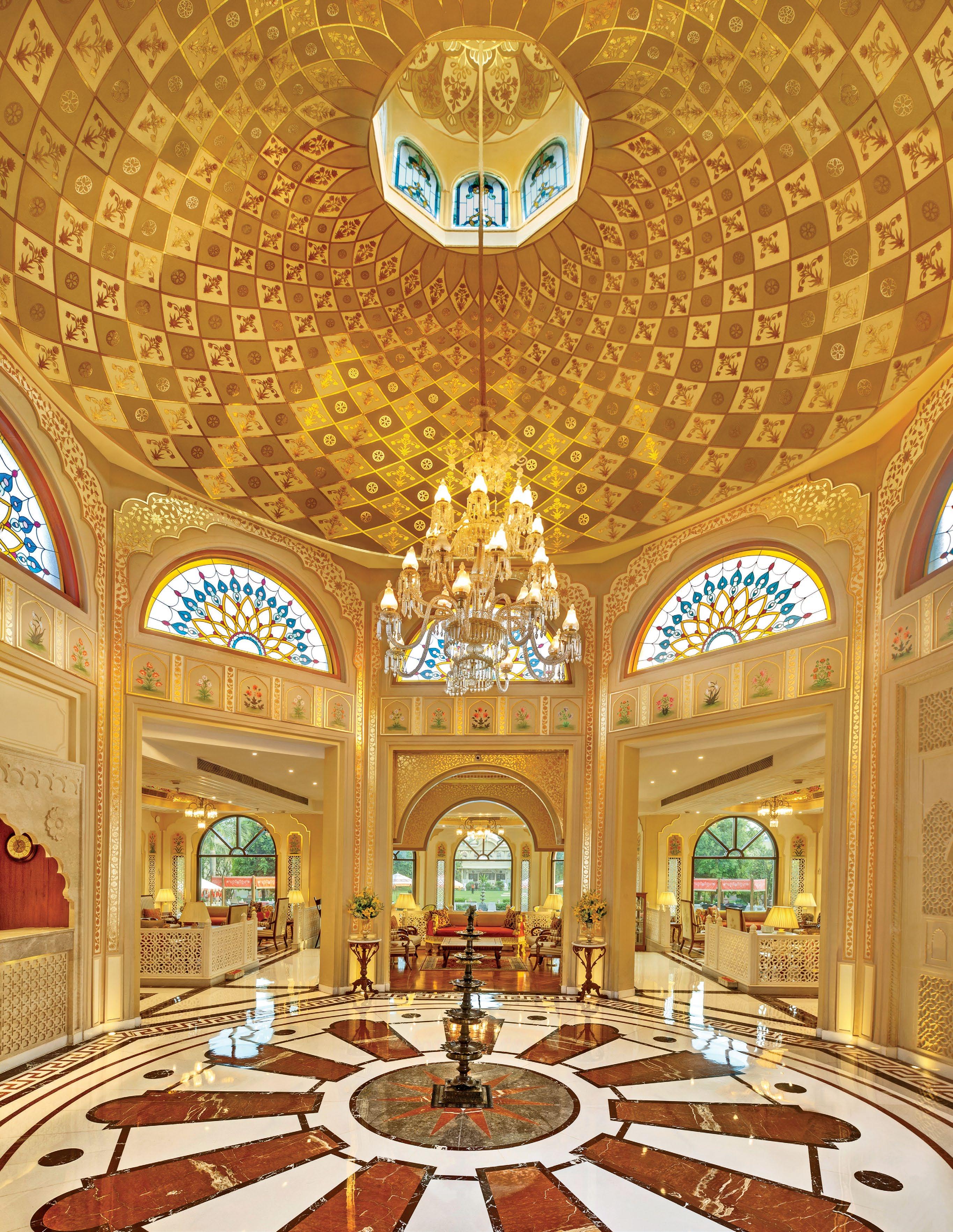
THIS SPREAD: Heritage Village Manesar's Rajasthani havelistyle façade with jharokhas and screens leads to an imposing marble-swathed lobby.



Just three decades ago, Delhi was a different place—physically, economically, socially, and shall we say, mentally. While the city had ‘five-star’ hotels, they were almost exclusively for the inbound—read foreign—guests. Leisure travel for the vast majority of Indians meant visiting maasi’s house or going on pilgrimages. In this post-liberalisation phase full of new possibilities, urban getaways were still a mirage for Delhi. Then, almost magically, here was a resort that was close enough to the city, yet sufficiently distant to be a true ‘getaway’.
Heritage Village Manesar was a game changer for India’s Golden Triangle, the most coveted tourism circuit in India, which, with the addition of the resort, squared. A gorgeous renovation later, the resort remains a favourite getaway within a sprawling megalopolis.
The resort was initially an ‘all-inclusive’ hotel, largely catering to inbound tourists, points out Arjun Sharma, Chairman, Select Group. His desire to bring the experience of Rajasthan closer to Delhi meant the 12-acre property had four blocks of haveli-style accommodation, which proved to be a spectacular hit.
“The Heritage Village Resort at Manesar brings together the formal style of classical Lutyens’ British architecture with the rich traditions of Indian heritage design, particularly from Rajasthan and the Mughal era,"

elaborates Shekhar Sawant, Managing Director & COO, Heritage Village Resort & Spa.
Today, Manesar is a thriving commercial hub, but Heritage Village in its initial period sat in splendid isolation—a veritable oasis on the Delhi-Jaipur highway. Renovated during the COVID era, with room count expanding to 150, its grandeur elicits an instant response from first-time visitors. Entering via a majestic pair of imposing gates reveals the pastel sandstone hues of the
ABOVE: Baradari, the outdoor pavilion, is used for weddings and conferences, particularly to host exclusive dining experiences.
ABOVE RIGHT: A stairway leading to the banquet halls in the Utsav Block.



Gold filigree patterns adorn the striking lattice frames, establishing the Rajasthani connection even more intricately. Art is an intrinsic part of the hotel with marvellous paintings evoking the grandeur of past eras.
The hotel has upgraded its dining options, too. Suvarna Mahal is an all-day diner; Mama Miso offers a Pan Asian menu, and Patisserie serves such a delectable spread that the restaurants are often full of walk-in guests who want to dine here. Especially of note is the subterranean Red Lounge, whose interiors are designed to transport you to the heart of Americana.


façade, interspersed beautifully with balconies, lattice screens, and deep cornices, elements drawn from the language of Rajasthani architecture. The porch stuns in marble of contrasting tones.
The central block is the beating heart of the resort. A majestic marble-clad lobby, softened with marble lotus motifs and floral decorations brushed by hand, with an occasional glint of gold, complements the luxuriously appointed sofas, all topped by an ornately gilded dome.
The resort is exceptionally well-suited for events, including weddings. From sprawling lawns to private terraces, technologically equipped boardrooms and conference halls, there are a plethora of venues to choose from.
Sawant points out that the resort has multiple USPs—right from the convenient location just 40 minutes from Gurgaon on the highway, to the way the rooms are grouped into clusters of rooms, rather like a haveli, which offers guests a lot of private space. “The surrounding landscape is very verdant, and we like to maintain our public grounds, for which there is a dedicated team of horticulturists. We realise our guests come primarily for relaxation, so we create that environment for them.”
Indeed, you would be forgiven for thinking that your good karma has transported you from the hubbub of the surrounding areas to an oasis. It is easy to fall in love with Heritage Village at first glance. The repeat visits are what turn you into a devotee.
THIS PAGE, CLOCKWISE FROM TOP CENTRE: Marble lattice work and gold leafing mark the architectural features of the expansive Aangan Suite; a lamp is lit every evening in a special ceremony; there are multiple conference facilities, including Sabha Hall featured here; the lobby is also adorned with marble lattice work and gold leafing.

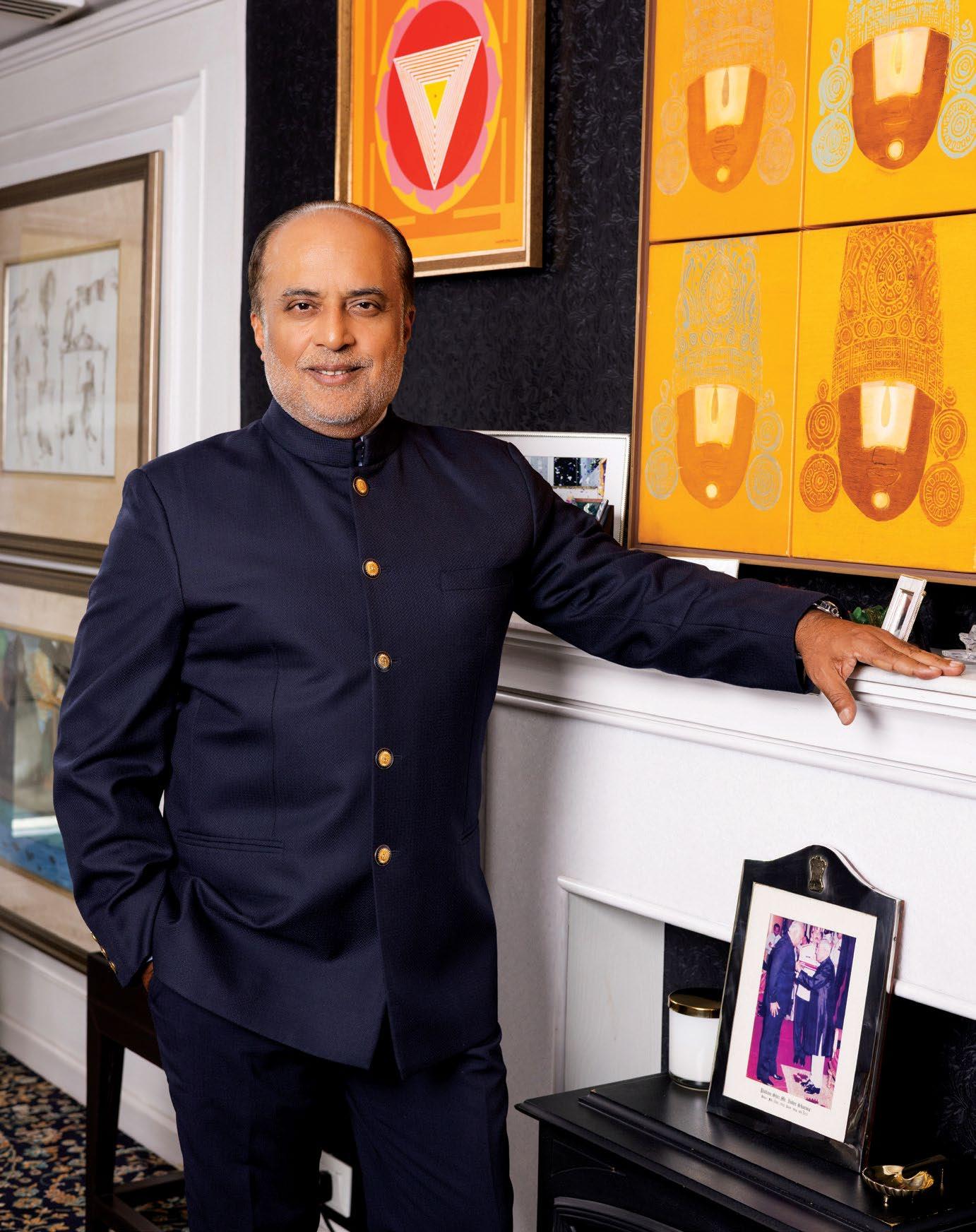
For Delhi folks of a certain vintage, the white and blue SITA World Travel buses were an everyday sight. They were part of north India’s most iconic travel agency, helmed by the legendary Inder Sharma, till it was acquired by Kuoni. A shift in direction by the group saw it veer towards hotels and malls, primarily led by son Arjun Sharma.
The 1990s saw the opening of the first hotels of the newly branded Select Group, followed by Select Citywalk, widely acknowledged as the city’s most successful mall. A partnership with Nexus saw the Nexus Select Trust transforming into India's first publicly listed retail (REIT) with a portfolio of 17 malls across the country. And set to rise rapidly. Meanwhile, the indefatigable leader has also entered the organic farming space with Vardan Agrotech and is exploring the healthcare sector. He shares how the journey into hospitality proved transformative, not just for the group, but for the entire city.
How did the journey of Heritage Village Manesar begin?
My father used to own a travel business called Sita World Travel. I joined as a young management trainee in 1984. Sita was a quintessential travel company, offering inbound tourism, outbound and domestic
Arjun Sharma
CHAIRMAN, SELECT GROUP WITH
He takes us through the family's foray into hospitality and the lessons learnt along this journey.
travel, cargo, and related services. But inbound tourism was its bread and butter. While we were among the top inbound businesses in the country, we didn’t have our own hard product. We were dependent on other service providers such as the Taj, Oberoi, Clarks, and so on for the 'Golden Triangle'—Delhi, Agra, and Jaipur. In the mid-80s, it was mainly Indian homegrown chains for whom inbound business was a crucial part of their model.
We felt that we should try to build an asset somewhere on the triangle, without offending the existing hoteliers. We found this little village called Manesar on the Jaipur-Delhi highway. It is still roughly 30 to 35 minutes from the Indira Gandhi Airport. We felt, at least in those days, that a lot of our clients would go to Delhi, Agra, Jaipur, and then come back to Delhi and stay the night. I did a lot of research at that time to see whether there was a possibility of getting that business without affecting anybody else in the incoming chain. My father gave me a budget of ₹25 lakh, and I bought 12 acres of land.
What were Manesar's prospects at the time? Manesar was just empty land. There were no factories. Subsequently, the Haryana government decided to make an industrial township there. The Japanese were


We felt that we should try to build an asset somewhere on the Golden Triangle, without offending the existing hoteliers. We found this little village called Manesar on the Jaipur-Delhi highway.”
aiming to set up a Japanese township, and they felt that having a good hotel nearby would at least give them a decent place to stay. That’s why they chose this location over Sonipat or Panipat back then—there simply wasn’t a five-star hotel in the area.
How was the initial response to the resort?
It was our first foray into the hospitality industry. We had a very strong partner in Thomson Holidays, which later on became TUI. They were very keen to have an all-inclusive resort. They actually asked me to look at a hotel in Goa for them, and that is how our second resort came up in 1999.
The all-inclusive concept, quite popular globally, hasn’t caught on in India. How was the reaction when you set it up?
We ran this concept for many, many years. In fact, even now, for the charter customers, we still have an all-inclusive package. We have a different package for domestic customers, but it’s a little more complicated to run when you run multiple packages. Because we have done it for 25 years, our teams are wellequipped to deal with it. In winter, 60 to 70% of our occupancy comes from charter traffic. It's not easy to replicate the concept, because charter customers want entertainment in the evenings. It's not just about free food and drinks. They still want to be catered to. It's like a cruise—you can't just give a standard buffet. They want variety, they want changes, they want style—that's really where the market has evolved to. So, it's a little more expensive to offer all-inclusive packages now.
RIGHT: A flautist performs every morning in the lobby.
BELOW: The mesmerising Utsav Terrace is ornamented with frescoes typical of Rajasthan.
Today, technology is one of the biggest enablers, allowing many independent hotels to reach customers directly.” “

How did the resorts evolve? Did you face any particular challenges?
By the time we tied up the land and the permissions to build, we also made our share of mistakes. For instance, when the hotel opened, the architect decided to go the eco-friendly way, using elements such as matkas, sand, and traditional methods instead of proper thermal insulation and waterproofing. But it didn’t hold up. As soon as the first rain came, water started pouring in everywhere, and we had to shut the hotel down for six weeks. On top of that, Haryana had prohibition, so no alcohol could be served at the resort! We had to deal with that for a year and a half.

CLOCKWISE FROM LEFT: A view of the swimming pool, with the resort resplendent in the backdrop; all rooms at the Heritage Villa enjoy views of the landscaped surroundings; the Heritage Villa comes with a private plunge pool.
We started with roughly 80-odd keys. Manesar slowly evolved. We added more rooms. We realised that we didn't want to be dependent only on foreign tourists. It has become a 150-key hotel. It caters to a wide variety of customers—conferences, MICE, weekend travellers, honeymoon travellers, and the wedding segment. It's so close to Delhi that you are out of the city, and yet, if you want to invite guests just to enjoy a dinner without offering them accommodation, you can do that. It offers you that flexibility. Now, of course, other resorts have come up. But we were the trend setters.
How were the resorts impacted during COVID?
My father used to always say to fix the sails when the winds are up, not when the winds are smooth. So, we used the opportunity during the shutdown to start planning. Of course, we couldn't do it in one go. But both hotels took shutdowns. Manesar took a shutdown

two years ago through the summer, and Goa took it last year. Obviously, both Manesar and Goa have had challenges. Goa has a huge monsoon period in the offseason, which makes it very difficult to construct. In Manesar, because of the GRAP restrictions (Gradated Response Action Plan for Delhi-NCR) in the winters, you can't work due to atmospheric pollution. So, the renovation couldn't take place in one go. But I would say we finished about 95% of the renovation over the last three years.
How were the hotels repositioned post the renovations?
The hotels have shown significant and robust growth. We opened two stunning restaurants at our Goa property—one focused on Italian cuisine, the other on Pan Asian. A key metric for us is guest satisfaction scores on Booking.com and TripAdvisor, where we
are probably in the top 5% of hotels. In fact, our allinclusive resort in Goa was even named one of the top 10 all-inclusive resorts in Asia a couple of years ago. And that was before the renovation was even finished.
India, of course, has changed a lot over the last 30 years. What have been some of the biggest changes to impact your hotels?
India has changed tremendously. Today, technology is one of the biggest enablers, allowing many independent hotels to reach customers directly. The cost of doing so is still high, though. If you are a brand, it’s cheaper. In emerging tourism pockets, there are a whole lot of independent hotels. Naturally, the big brands are now acquiring these independents because they realise they can’t compete at that level—there’s a segment of customers who just want smaller, boutique, family-run businesses, not a cookie-cutter style.



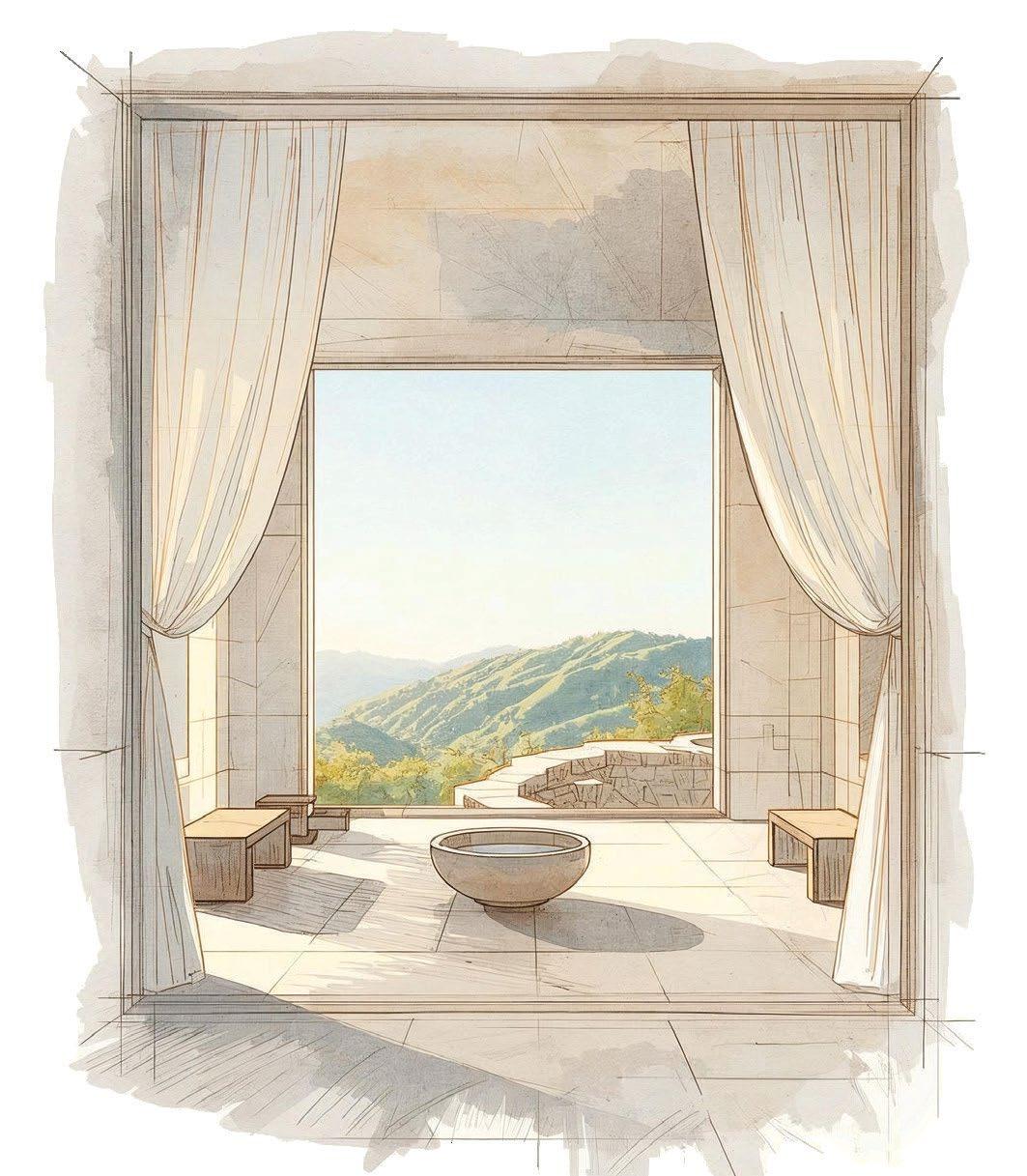
RECHARTED
India’s travel landscape is transforming, with emerging destinations reshaping traveller experiences and hospitality investment.

DEEPALI NANDWANI
COVER STORY
India’s travel map is being redrawn, weaving timeless heritage with bold, modern experiences. Tourism is decentralising from marquee spots to offbeat valleys, secondary cities, and niche pilgrimage and food circuits. Improved infrastructure, rising affluence, campaigns like Dekho Apna Desh, experiential journeys, and remote work are unlocking new frontiers.
“India’s tourism landscape is evolving at an unprecedented pace, with emerging destinations now taking centre-stage,” says Suma Venkatesh, Executive Vice President – Real Estate & Development, IHCL. While metros and leisure staples such as Goa, Kerala, and Rajasthan endure, demand has surged in Tier 2/3 cities (Coimbatore, Ludhiana, Jorhat), spiritual hubs (Vrindavan, Prayagraj, Ujjain, Ayodhya), industrial corridors (Hosur, Sanand, Dholera), and offbeat spots (Sindhudurg, Naldhera, Lataguri, Raichak). IHCL leads with Taj resorts in Lakshadweep’s Suheli and Kadmat islands, besides recent luxury launches in Wayanad, Puri, Gangtok, Patna, and Dehradun. IHCL’s brandscape caters broadly: Taj anchors luxury in Darjeeling and Rajasthan palaces; Tree of Life and amã Stays & Trails offer boutique homestays for curated experiences, says Venkatesh.





CLOCKWISE FROM TOP: Jawai in Rajasthan is quietly becoming one of India’s most distinctive luxury wilderness destinations, where leopards roam freely; Sikkim is India’s only fully organic state and an ecodestination; natural phenomena such as centuries-old coral bridge on Neil Island makes it a traveller’s paradise.
THE LEADERSHIP VOICES

KHUSHNOOMA KAPADIA
VICE PRESIDENT – MARKETING, SOUTH

SUMA VENKATESH
EXECUTIVE VICE PRESIDENT – REAL ESTATE & DEVELOPMENT, IHCL
Emerging markets offer exciting opportunities for hotel development, with significant demand–supply gaps. Early entry offers a first-mover advantage, fuelled by improving infrastructure, strong connectivity, lower entry barriers, and supportive policies, opening doors for hospitality across all segments."
REGIONAL VICE PRESIDENT - COMMERCIAL, INDIA SOUTHWEST ASIA, HYATT INDIA KADAMBINI MITTAL
Emerging destinations allow us to pivot the Indian hospitality landscape in a new direction while creating fresh economic ecosystems generating jobs and uplifting local communities. Hospitality becomes a catalyst for growth, signaling confidence in the market and often accelerating infrastructure development."


With India outpacing global trends and seeing strong growth from a rising high-net-worth base, demand is growing for culturally rich experiences beyond saturated metros. These destinations offer lower entry costs, scalable growth, and the opportunity to create differentiated, wellness- and culture-focused luxury offerings.”
ASIA, MARRIOTT INTERNATIONAL

NIKHIL SHARMA MANAV THADANI
MANAGING DIRECTOR AND COO, RADISSON HOTEL GROUP SOUTH ASIA

Radisson Hotel Group collaborates proactively with local stakeholders and government bodies to streamline processes and co-develop infrastructure. Partnerships with local communities also ensure smoother integration of cultural and environmental elements into projects.”

FOUNDER-CHAIRMAN, HOTELIVATE
Hoteliers will build huband-spoke clusters and pick sites where connectivity is surging—near new highways and regional airports."
AJAY K. BAKAYA
CHAIRMAN, SAROVAR HOTELS AND DIRECTOR, LOUVRE HOTELS INDIA
ANURAAG BHATNAGAR
CHIEF EXECUTIVE OFFICER, THE LEELA PALACES, HOTELS AND RESORTS
The potential for India to emerge as one of the world’s top three luxury travel markets is within reach, but it requires focused collaboration, faster and transparent regulatory approvals, and sharper, globally consistent marketing to showcase its leisure, cultural, and spiritual destinations.”


Opportunities exist in leisure and business destinations. Leisure grows through pilgrimage and experiential travel, while business comes from industrial corridors, new airports, and government economic hubs. In both, the midmarket remains the sweet spot.”
MANDEEP SINGH LAMBA
PRESIDENT & CEO (SOUTH ASIA), HVS ANAROCK

Destination marketing needs sharper focus, as many Tier 2 and 3 destinations remain under the radar. Strategic public-private partnerships can build strong brands and drive sustained demand."

ANIRUDDH KUMAR
VICE PRESIDENT - DEVELOPMENT, INDIA & SOUTH ASIA, ACCOR

JEHANGIR AIBARA
DIRECTOR,
MAHAJAN & AIBARA
Sustainability is crucial, and while private investment is key, longterm destination management often needs organised state intervention. In sensitive regions like the Himalayas, growth must be carefully planned to prevent chaotic, unsustainable expansion."

Many emerging destinations are strategically situated near clusters of smaller but affluent towns that are currently underserved. These markets hold significant potential for weddings and social gatherings.”
MICHAEL DOMINIC
MANAGING DIRECTOR, CGH EARTH EXPERIENCE HOTELS

We don’t open hotels for the sake of opening them—it’s about profitability. We enter less competitive destinations, and every new property sets a brand standard.”


AKANKSHA LAMBA UDIT KUMAR
CO-FOUNDER AND SENIOR VICE PRESIDENT – OPERATIONS, THE POSTCARD HOTEL

Our approach lets the destination shape the hotel, ensuring each The Postcard Hotel is contextual yet aligned with our philosophy of authenticity and thoughtful design. Architecture, materials, cuisine, rituals, and experiences are tailored to reflect the surroundings.”

CO-FOUNDER, BRIJ HOTELS
Modern travellers crave stories, not just rooms. Emerging destinations give hoteliers the freedom to experiment with design, cuisine, and community engagement in a way that feels organic and authentic."
GILES KNAPTON
FOUNDER, COCO SHAMBHALA, SINDHUDURG
The biggest challenge has been balancing infrastructure gaps with operational consistency, as many destinations still face limited connectivity, supply chains, and trained manpower. ”
SARBENDRA SARKAR
MANAGING DIRECTOR & FOUNDER, CYGNETT
HOTELS & RESORTS


India’s depth of experiences is unmatched, and travellers are no longer chasing only the obvious hotspots. For leisure, the coastal belts of Sindhudurg and the Konkan are rising as authentic alternatives to Goa. Parts of Karnataka is gaining attention for retreats rooted in nature and traditional practices.”
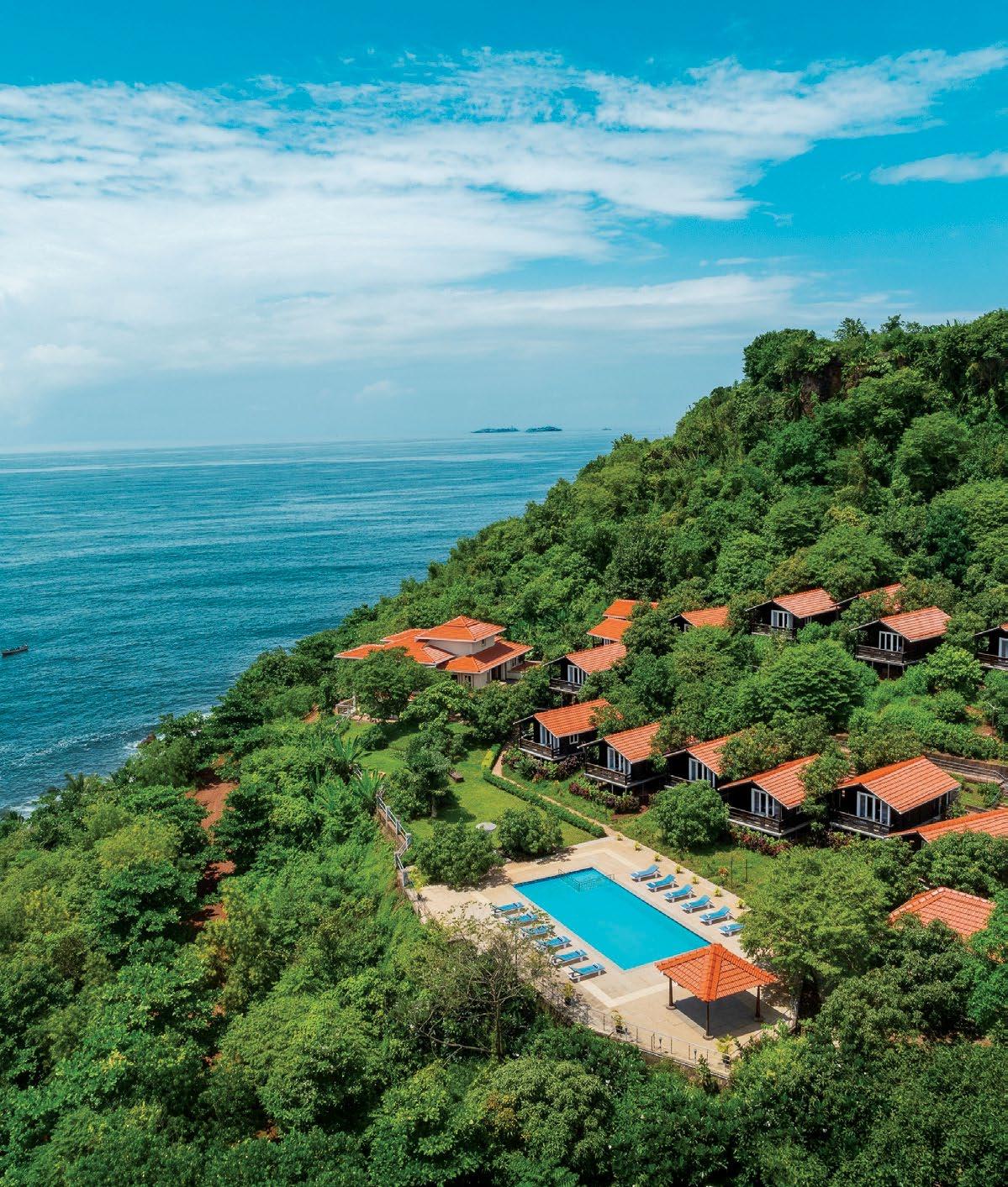
Khushnooma Kapadia, Vice President – Marketing, South Asia, Marriott International, highlights Coorg and Rajasthan/Madhya Pradesh’s heritage cities as alternatives to Jaipur, Udaipur, and Jodhpur. “Marriott’s Series by Marriott partnership adds 100+ midscale/upscale hotels in Tier 2/3 markets,” she says.
Spiritual tourism is the new frontier: Ajay K. Bakaya, Chairman, Sarovar Hotels and Director, Louvre Hotels India, notes growth in Bodhgaya, Varanasi, Ayodhya, and Mathura-Vrindavan. Kadambini Mittal, Regional Vice PresidentCommercial, India Southwest Asia, Hyatt, flags Katra (the gateway to Vaishno Devi) for meaningful experiences. “Leisure spots (Lansdowne, Igatpuri, and Kasauli), urban nodes (Greater Noida, GIFT City) and cultural pockets (Pushkar, Kumbhalgarh, Kochi) offer long-term scalability, distinct brand positioning, and opportunities for meaningful local partnerships, powered by incomes and infrastructure,” she says.
Hyatt is expanding with Destination by Hyatt in Jaipur and Jim Corbett (2026), The Unbound Collection in Bhopal’s Noor-Us-Sabah Palace, and all-inclusive Hyatt Ziva/Zilara resorts.
Nikhil Sharma, MD & COO, Radisson Hotel Group South Asia, talks about offering authentic experiences spotlighting cultural towns, wellness retreats, and coasts. Radisson’s signings include Pawna Lake, Lucknow, Rajkot, Shirdi, Siliguri, Bhuj, Darbhanga, and Prayagraj, with midscale dominating the 2025 signings nationwide. “While luxury properties will
continue to thrive in marquee destinations, the next wave of growth will be powered by mid-scale hotels in high-demand regional markets. Smaller towns with cultural or spiritual identities, wellness-led hill retreats, and coastal regions are gaining centrestage. Business travel is spreading into Tier 2 and 3 cities, reshaping how travellers and investors view India’s tourism future. ”
Anuraag Bhatnagar, CEO, The Leela Palaces, Hotels and Resorts, underscores this evolution unfolding beyond metros and adds, “Luxury travellers seek restoration, discovery, and transformation. Demand is projected to outpace supply, driven by rising affluence, global connectivity, and the shift toward experiential travel.” He notes that leisure and wellness hubs such as Kerala’s backwaters—Ashtamudi and Kovalam—are being rediscovered, while Agra, Sikkim, and Rajasthan’s deeper circuits are being reimagined through luxury hospitality. “Spiritual hubs such as Ayodhya are transforming into experiential centres, and wildlife destinations such as Ranthambore and
The Apatanis’ ingenious, centuries-old system of integrating fish farming with wet rice cultivation has earned Ziro UNESCO recognition as one of India’s most sustainable living landscapes.

Hotels such as Highland Sarovar Portico are tapping into Sindhudurg’s coastal charm and tranquil seclusion to create an immersive getaway experience.
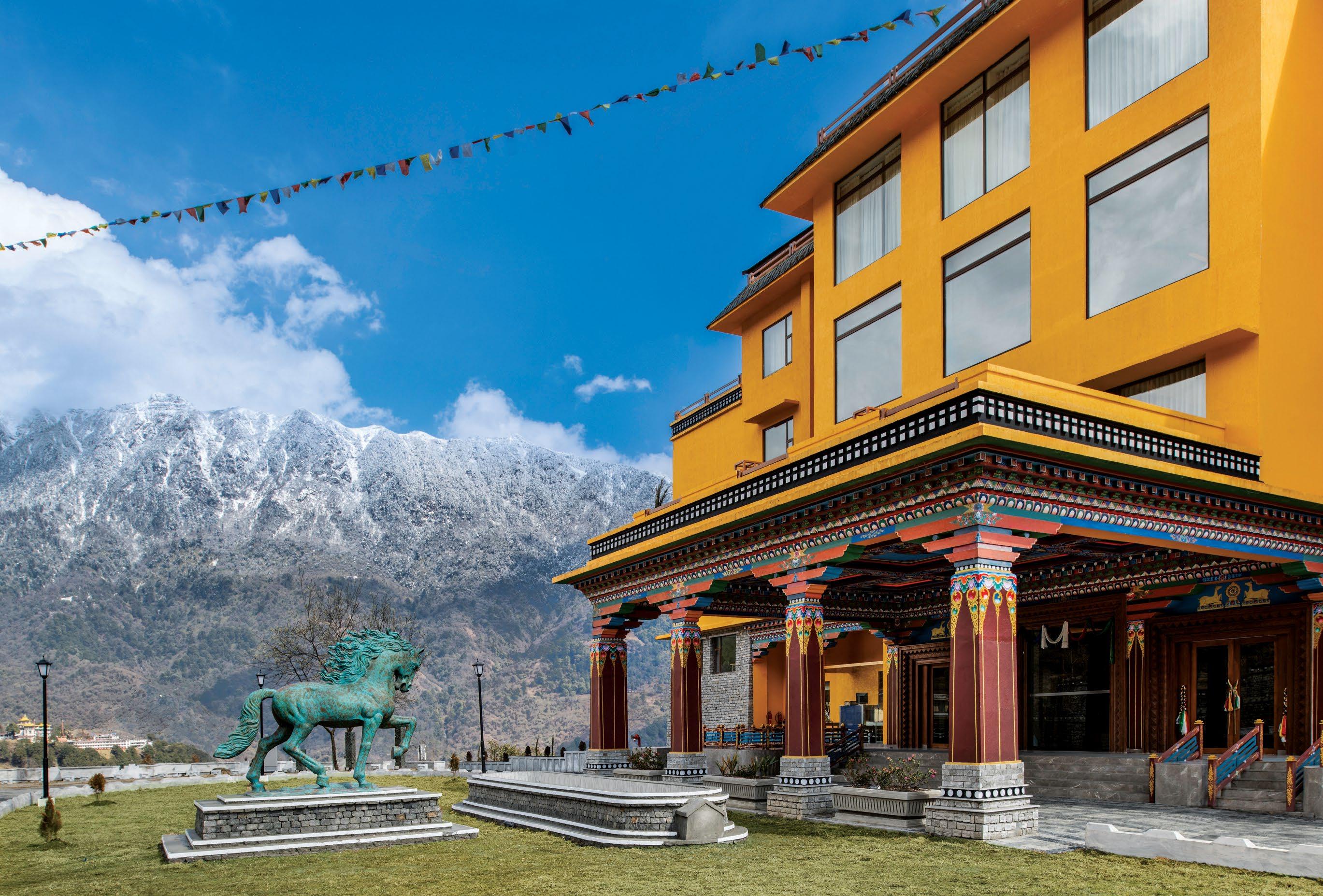
Bandhavgarh are gaining global prominence. Even urban micro-hubs such as Mumbai’s BKC are evolving into lifestyle districts anchored by luxury hotels.”
The Leela’s growth strategy reflects this shift. “We’re building a balanced portfolio across leisure, cultural, spiritual, and business destinations, with upcoming openings in Agra, Sikkim, Ayodhya, Bandhavgarh, and Mumbai BKC. But our focus isn’t merely to open hotels—it’s to shape how these destinations are experienced for years to come.”
A view to which Sarbendra Sarkar, Managing Director & Founder, Cygnett Hotels & Resorts, agrees. He sees Vadodara, Lucknow, Visakhapatnam, Surat, and Indore as business hubs. Aniruddh Kumar, Vice President - Development, India & South Asia at Accor, notes Alibaug, Amritsar, Indore, and Vadodara attract multifaceted travellers, and so do spiritual/cultural spots such as Nashik, Prayagraj, Varanasi, Rishikesh and Haridwar. “These cities are aligning with the evolving preferences of today’s diverse travellers, and our expansion strategy is focused on capitalising on their promise.”
Adding a fresh lens on untapped luxury circuits, Akanksha Lamba, Vice President – Strategy, The Postcard Hotel, says the group focuses on markets such as Chikmagalur, Coonoor (for its coffee culture); Tirupati (modern luxury); and wildlife in Jawai, Kanha, Pench, and Chitwan (Nepal). “Our guests seek depth, meaningful connection, and authenticity.”
Lamba contends that international visitors still view India narrowly—Rajasthan, Kerala, and Agra dominate itineraries—while domestic travellers miss lesser-known regions due to a lack of narrative. “Whether it’s Pasighat’s Siang River, Himachal’s Kangra Valley, or Jawai in Rajasthan, guests expect context-driven, sensorially rich experiences delivered with seamless care.”
Mandeep Lamba, President & CEO (South Asia), HVS Anarock, observes a broadening travel canvas across India. “Leisure and wellness hubs such as Varkala, Chikmagalur, and Rishikesh are gaining traction, while Ayodhya, Bodhgaya, and Vrindavan are reshaping spiritual travel,” he notes. “Heritagerich towns such as Ajmer, Bundi, Hampi, and Majuli
Vivanta Arunachal Pradesh, Tawang is the region’s first premium hotel, perched at around 10,000 feet elevation, combining luxury with local architectural touches.
are drawing attention, even as business hubs such as Noida, GIFT City, and Navi Mumbai expand rapidly.” He adds that the government’s plan to develop 50 tourism circuits underscores India’s shift from checklist tourism to immersive, interest-led exploration.
While destinations such as Lucknow and Haridwar have long featured on India’s travel map, branded hotels are taking greater interest, driven by renewed demand from business, spiritual, and leisure travellers. “Lucknow and Amritsar, in particular, are emerging as culinary hotspots where food rivals heritage as a draw,” says Bakaya. “Millennials and Gen Z are seeking wellness, adventure, and culinary experiences in destinations like Sindhudurg, Udaipur, Bodhgaya, and Dharamshala.”
Experiential and wellness travel major CGH Earth Experience Hotels is working to create the right ambience and environment to nurture new destinations. Managing Director Michael Dominic explains, “These locations must have basic infrastructure like airports or railways. We’re starting a property in Sakleshpur, Karnataka, and exploring the hills of Goa—moving away from beaches into its forested hinterlands. The Odisha government has also invited us to explore opportunities.”
Boutique brands such as The Postcard Hotel and Brij Hotels are similarly expanding into emerging

leisure markets. “We see Bandhavgarh evolving into a design-led wildlife and leisure hub; Bundelkhand’s riverine villages opening up for cultural retreats; and Pali and Kuchaman in Rajasthan drawing heritage travellers who want privacy over crowds,” says Udit Kumar, Co-founder, Brij Hotels. “Ghorakhal near Nainital is quietly becoming a soulful spiritual outpost, while Kerala’s hill country and the Kumaon belt attract guests seeking quiet luxury.”
Improved connectivity has made emerging leisure destinations particularly attractive. The Northeast, particularly Ziro Valley, Tawang, and Pasighat (Arunachal Pradesh), long known but underdeveloped, are gaining traction. In Maharashtra, Alibaug is luring branded hotels, while Nagpur’s Koradi lake has become an eco-magnet. Rishikesh and Mussoorie have benefitted from easy access via Jolly Grant Airport, and are ideal destinations for corporate off-sites, leisure travellers, and MICE events.
Jehangir Aibara, Director, Mahajan & Aibara, notes, “The far north holds immense potential, though infrastructure gaps remain. Destinations such

ABOVE: The Postcard Durrung Tea Estate is set within a 1,400-acre working tea estate in Tezpur.
RIGHT: Marasa Sarovar Premiere, Tirupati is India’s first theme hotel inspired by the Dasavataras (the ten incarnations of Lord Vishnu), combining spiritual aesthetics with five-star luxury.
as Lakshadweep and the Andamans await proper infrastructure and room inventory to realise their promise. Pushkar, meanwhile, has evolved into a wedding destination supported by larger hotels and improved facilities.”
Among newer coastal destinations, Sindhudurg stands out, strongly backed by the Maharashtra government. “It’s emerging as a competitor to Goa,” says Aibara. “Supported by tourism incentives and stunning beaches, key players such as Taj, Sarovar, and Westin are entering the market, even as road connectivity continues to improve. Similarly, Bekal— pioneered by Taj and The LaLit—is seeing new hotels that will boost its social and leisure infrastructure.”
Sindhudurg’s appeal lies in its diversity—from budget stays to high-end luxury. Giles Knapton, Founder, Coco Shambhala, one of India’s most exclusive coastal retreats, says, “India’s depth of experiences is unmatched, and travellers are no longer chasing only the obvious hotspots. Sindhudurg and the Konkan coast are rising as authentic alternatives. In spirituality and wellness, parts of
EMERGING DESTINATIONS THROUGH DATA


Midscale hotels are best positioned to capture the evolving demand— offering consistency, affordability, and scalability where supply continues to lag. HVS Anarock data shows the midscale segment accounted for 55% of signings in H1 2025, maintaining its lead over other categories. Nearly 80% of new property signings have been in Tier 2–4 cities, underscoring developer confidence beyond metros. Luxury hotels, meanwhile, are finding success in select high-growth corridors and leisure destinations catering to travellers seeking bespoke, differentiated experiences.
Karnataka and Uttarakhand are drawing seekers to nature-rooted retreats, while culinary travel is booming as people rediscover regional flavours—from Malvani seafood to millet-based southern fare.”
Pilgrimage circuits are evolving beyond religious tourism to embrace mindful travel and personal renewal. Manav Thadani, Founder-Chairman, Hotelivate, observes, “Parallelly, wellness resorts, nature-based retreats, and integrated spa destinations are thriving, especially in scenic leisure hubs and secondary markets where natural settings and lower costs encourage innovation. These cater to domestic and global guests seeking holistic health and immersive cultural experiences.”
Connectivity is the biggest enabler. “India now has the world’s second-largest road network, with rapid expansion making smaller cities, heritage towns, and scenic locations accessible. What were once ‘offbeat’ destinations are now within easy reach of metros— fuelling leisure and business travel and driving hotel brands to invest beyond traditional markets,” he adds.


OPPORTUNITIES FOR HOTELIERS
CLOCKWISE FROM TOP LEFT: CGH Earth Experience Hotels Tilar Siro, Andamans, named after the Great Andamanese phrase ‘Thi-Lar-Siro’ (‘earth from the sea’), blends seamlessly with the island setting through stilted architecture, reef conservation, and cuisine; Radisson Blu Hotel, Ranchi is situated in the heart of the city with 12,500sq.ft of event space; Grand Mercure Agra is pivoted as a business and events hotel with over 5,000sq.ft of meeting rooms and event space.
Emerging destinations present “a compelling investment landscape defined by first-mover advantage and the ability to shape the future of travel,” says Mittal. With India’s economy outpacing global trends and a growing base of high-net-worth individuals (HNWI), “there is rising demand for exclusive, culturally nuanced experiences beyond saturated metro markets. These destinations offer lower entry costs, scalable growth, and the chance to build differentiated offerings that combine wellness, local culture, and personalised luxury.”
Many of these markets remain under-supplied in quality branded accommodation despite rising demand. “The demand–supply imbalance in such regions is significant, and early inroad allows us firstmover advantage,” says Venkatesh.
Over the past few years, investor focus has shifted steadily toward Tier 2, 3, and 4 cities, satellite towns, and emerging leisure hubs. Mandeep Lamba of HVS Anarock says, “Developers have the opportunity to establish early market leadership and shape the hospitality landscape.”
Leisure-centric towns are increasingly attracting wellness travellers, wedding groups, and spiritual tourists, while business-oriented secondary cities are witnessing steady corporate demand, backed by expanding manufacturing and IT/ITeS hubs. “In these cities, weekdays are dominated by corporate travellers, while weekends see a rise in social MICE and transient business,” Lamba explains.
Kapadia notes that while midscale and premium hotels drive volume growth, luxury and ultra-luxury categories are creating visibility and long-term brand equity in high-value niches. “A balanced portfolio across segments ensures scalability and sustainability,” she says. Early entrants not only secure market presence but also catalyse regional economic development. “Hospitality becomes a driver of growth rather than a by-product,” she adds, pointing to Marriott’s 2025 partnerships with Ventive
Hospitality and Brigade Group to add over 2,400 rooms across India.
For hoteliers, untapped markets with limited branded supply offer the greatest potential.
“Destinations such as Gopalpur or Palampur present viable alternatives to saturated hubs,” says Sharma. “By investing early, brands can shape guest expectations, establish loyalty, and anchor a destination’s evolution.”
Akanksha Lamba of The Postcard Hotel observes that luxury in emerging destinations allows brands to define rather than compete. “By integrating with the landscape, culture, and community, hotels can enhance rather than disrupt their settings—creating iconic properties that shape perceptions and elevate the destination.”
Bakaya adds, “Leisure growth is being driven by pilgrimage and experiential travel, while business demand arises from industrial corridors, new airports, and government-led economic centres. Mid-market in less-developed market remains the sweet spot as aspirational travellers seek quality, affordability, and authenticity over opulence. Our hotels combine consistency and safety with regional touches in design, cuisine, and experiences—appealing to both local and global travellers.”
Tier 2 and 3 cities, with lower entry costs and faster scalability, continue to attract developers.
“Destinations within one to two hours of major


cities—such as Faridabad, Sohna, the ECR corridor near Chennai, and hubs such as Rajkot and Surat—are emerging as attractive micro-markets,” says Aniruddh Kumar of Accor. Hyatt’s Mittal adds, “Our expansion follows where guests are going. We assess connectivity and demand drivers and align the right brand accordingly, whether Hyatt Regency for business hubs or Hyatt Place for fast-growing leisure markets.”
Sarovar’s expansion strategy is similarly datadriven. “We enter markets with long-term tourism or industrial potential, even if under-penetrated today,” says Bakaya. “Early entry allows us to balance risk with strategic presence, while our flexible brand architecture lets us tailor product to market potential.”
Michael Dominic of CGH Earth Exeperience Hotels sees strong luxury potential in new destinations. “Earlier, low ARRs limited returns, but today emerging markets deliver both high occupancy and strong
rates,” he says. “This makes them ripe for investment.”
Brij Hotels’ Udit Kumar adds, “The boutique space thrives on experience-driven resorts under 25 keys. Adaptive reuse of heritage homes or forest estates offers irreplicable charm. While intimate luxury remains our sweet spot, we also see growth in chic mid-market lodges in wildlife and craft clusters.”
Anuraag Bhatnagar, CEO of The Leela Palaces, Hotels and Resorts, highlights the strategic opportunity in defining new luxury markets. “With India’s luxury ARRs still far below those in London, Dubai, or Singapore, there’s enormous headroom for growth,” he says. “The opportunity lies in creating categorydefining icons early—properties that can sustain premium pricing and long-term RevPAR leadership.”
He notes that The Leela consistently delivers 1.3x ARR and 1.2x RevPAR versus peers, “validating the power of investing in distinctive destinations”.
Kangra Valley in Himachal Pradesh offers a unique blend of rich history, spiritual significance, and natural beauty, making it a captivating destination for travellers.
Diversification through ARQ (its private members’ club) and The Leela Luxury Residences extends engagement beyond a single stay. “India’s luxury story is being rewritten in destinations that offer immersion, transformation, and storytelling,” he adds. “We aim not just to participate in emerging destinations, but to shape their global narrative.”
Several factors are drawing hotel brands to these new destinations. “Groups like IHCL and Marriott are leveraging sub-brands to tap into second-tier cities,” says Aibara. “Success often hinges on partnering with first-time owners who understand local dynamics.” He, however, cautions that not all emerging markets can sustain upper-upscale hotels. “Amravati in Maharashtra, for instance, has limited business travel but surging wedding demand—illustrating both the risks and opportunities of niche markets.” Among the factors behind the foray into uncharted territories, Bhatnagar mentions a “white space in luxury supply. With luxury hotels forming just 17% of branded stock, first movers can sustain pricing power.
India’s emerging destinations present opportunities across both leisure and business travel, calling for a balanced portfolio strategy. Hyatt’s Mittal views this through a dual lens—serving discerning domestic travellers seeking exclusivity while attracting international guests drawn to India’s spiritual and wellness heritage. “From sound healing at Grand Hyatt Kochi Bolgatty to Tibetan rituals at Hyatt Regency Dharamshala, our offerings are designed to foster loyalty and advocacy,” she says.
Leisure hubs are being shaped by demand for wellness and lifestyle-led stays, where travellers seek experiences that marry comfort with culture and nature. “These destinations are ideal for brands that can integrate local storytelling, culinary traditions, and wellness into the guest journey,” Mittal adds.
The challenge lies in balancing growth across leisure and business markets. “Both segments present significant opportunities—albeit for very different reasons,” notes Kapadia. Leisure travel thrives on domestic exploration and cultural immersion, while business destinations benefit from regional development, government incentives, and expanding infrastructure.
Sharma adds, “The larger opportunities in the near term are concentrated in leisure and spiritual destinations, where experiential travel is driving post-pandemic demand, while business travel remains resilient in second-tier markets.”
With performance metrics pointing to steady growth in leisure-driven markets and sustained resilience in top-tier cities, Thadani underscores what he calls India’s transition into a ‘leisure era’. “Domestic tourism has boosted performance metrics across multiple leisure destinations. Yet the top four or five urban markets continue to show strong year-on-year RevPAR growth, even as barriers like limited space restrict new projects. Opportunities exist across segments, but factors such as location, type of development, and branding ultimately define positioning.”

Brij Sone Bagh on the edge of the Bandhavgarh Tiger Reserve offers guests a front-row seat to a pristine tiger habitat, ancient forts, and timeless tribal culture.
WHAT TRAVELLERS WANT
Emerging destinations are attracting audacious, experience-driven travellers, particularly in the leisure segment. “They tend to be younger, digitally savvy, adventurous, and deeply experience-driven,” says Khushnooma Kapadia, Vice President – Marketing, South Asia, Marriott International. “They prioritise discovery and connection. They want to immerse themselves in local cultures, sample regional cuisines, and engage in wellness or outdoor pursuits that align with their values.”
Many are urban professionals seeking originality and provenance over traditional luxury. “They prefer boutique stays, cultural engagement, and sustainable practices to conventional sightseeing,” says Sarbendra Sarkar, Managing Director & Founder, Cygnett Hotels & Resorts.
Anuraag Bhatnagar, CEO, The Leela Palaces, Hotels & Resorts, notes: “The rise of the experience-native traveller is unmistakable. Transformational

travel drives high-net-worth families, younger luxury cohorts seeking cultural authenticity and design-forward spaces, and global Indians reconnecting with India through elevated cultural and spiritual journeys. Unlike traditional luxury markets, these travellers expect cultural depth, wellness, sustainability, and experiences that feel personal, intimate, and transformative.”
Aniruddh Kumar, Vice President –Development, India & South Asia, Accor, adds: “New-age explorers, young professionals, spiritual seekers, and experience-focused international visitors seek deep cultural and historical immersion alongside modern comforts—reliable service, curated local experiences, food trails, heritage walks, wine tours, or access to spiritual sites.”
Nikhil Sharma, MD & COO, Radisson Hotel Group South Asia, notes that social media influence and storytelling are key motivators for first-time visitors. “They expect curated experiences, boutique-style hospitality, and personalised services that reflect local flavour rather than standardised offerings. Wellness tourists gravitate
Like all Ananta properties, the Ajabgarh one is set in a destination rich in cultural and built heritage.
to Palampur’s natural retreats, while pilgrims in Prayagraj, Katra, or Shirdi seek convenient, accessible stays.”
In coastal towns such as Pondicherry, seafood-led dining and water-based activities are curated for guests. Pilgrimage hubs such as Ayodhya see demand for functional yet comfortable stays with vegetarian dining and wellness facilities. According to Mandeep Lamba of HVS Anarock, India’s emerging destinations will increasingly attract domestic travellers seeking short-haul leisure breaks, staycations, and spiritual or wellness-led stays.
Unlike metros, where weekday demand is largely corporate, these markets see weddings, reunions, pilgrimages, and corporate travellers extending trips into leisure.
Hotels respond with tailored offerings, integrating local culture and storytelling into design, and service without compromising comfort—introducing curated food trails, heritage walks, vineyard tours, wellness retreats, and spiritual immersions alongside MICE and leisure facilities.
Wellness, yoga, outdoor recreation, and family-friendly activities are growing priorities in leisure-led markets, while business towns expand flexible banquet and meeting facilities. Technology— contactless check-in, mobile F&B ordering, digital concierge—enhances convenience. Successful brands

balance standardisation with local relevance, maintaining quality while meeting evolving guest expectations.
Ajay K. Bakaya, Chairman, Sarovar Hotels, explains, “Unlike established markets, emerging destinations are about discovery, so hotels need to balance global standards with a strong local flavour.” Kapadia observes, “Travellers value both heritage and convenience,” evident in architecture redolent with references of local design language, farm-to-table dining, and curated cultural experiences.
Udit Kumar, Co-founder, Brij Hotels, highlights the rise of remote-working travellers and multi-generational families seeking meaningful activities. “Travellers expect design that blends with the landscape, sustainability that feels effortless, and service that is personal yet discreet.” Pilgrimage hubs focus on efficient check-ins and group amenities, while leisure destinations prioritise local cuisine and cultural immersion. Business cities emphasise modern meeting spaces, seamless connectivity, and efficient service.
Located on NH-27 in Chapaguri, Bongaigaon, Cygnett Park Meghna is positioned perfectly for business travellers.
HALLENGES INHERENT IN EMERGING DESTINATIONS C

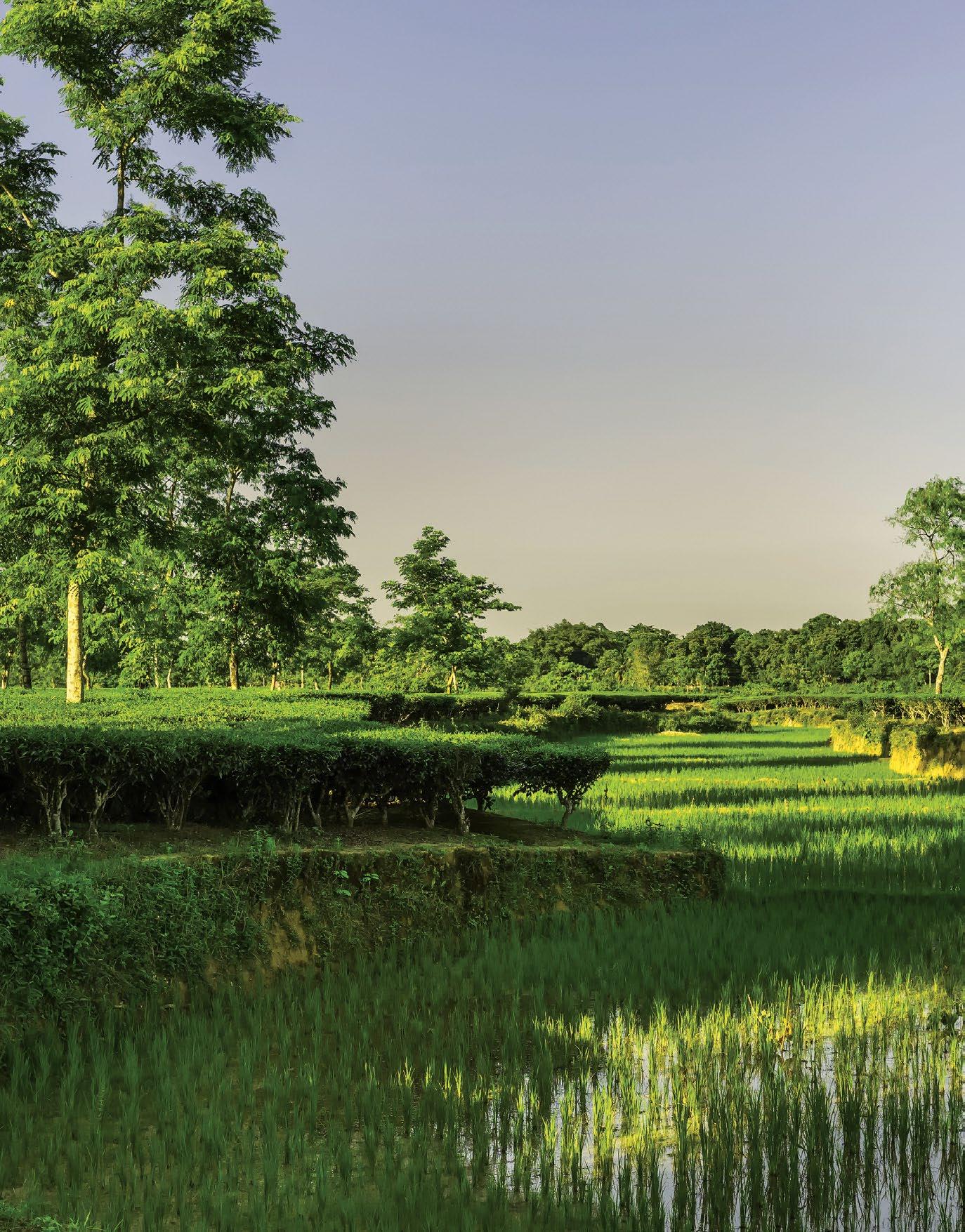
Infrastructure remains the single biggest hurdle— ranging from limited airports and last-mile connectivity to trained manpower and complex regulations. Bakaya notes, “We address this by partnering closely with local stakeholders and upskilling local talent.” Hyatt’s Mittal underscores the need for “continued investment in physical infrastructure—better roads and airports—as well as digital connectivity to create a sustainable hospitality ecosystem.”
Accessibility and connectivity remain major constraints. “We exercise great care in selecting the right micro-markets within these cities to ensure longterm viability,” says Accor’s Aniruddh Kumar. “We collaborate closely with experienced consultants and contractors who understand local nuances, ensuring quality aren’t compromised despite inherent risks.”
Regulatory complexity adds another layer of difficulty. “Each state has its own by-laws, which can cause development delays,” Kumar explains. “Through thorough evaluation and on-ground expertise, we navigate these challenges to keep projects on track.” He adds that property owners often
Chikmagalur, often referred to as the birthplace of coffee in India, offers a unique and immersive experience for coffee enthusiasts.


need guidance to align with branded hotel standards— “from global compliance to brand positioning”—a gap Accor bridges through structured advisory support.
Connectivity challenges are especially acute in experiential destinations. HVS Anarock’s Lamba observes, “Flights, road quality, and travel time affect feasibility for luxury travellers. Secondary challenges include construction logistics, supply chains, and state-specific regulations. Overcoming these operational and logistical issues is part of creating meaningful luxury experiences.”
Systemic reforms are needed. “Policy harmonisation is a key gap,” Lamba of HVS Anarock emphasises. “Although several states now recognise tourism as an industry, approval processes remain fragmented. A unified national approach to licensing, taxation, and clearances would significantly improve ease of doing business.”
For emerging destinations to reach full potential, he adds, “developing robust partner networks—local suppliers, culinary experts, and experience providers—is equally important. Addressing these gaps requires coordinated effort
among industry stakeholders, state governments, and private players”.
Hoteliers are already finding workarounds. “Some are investing in solar power and water recycling to reduce dependence on public utilities, while others are partnering with state tourism departments to streamline approvals,” Lamba explains.
Brij Hotels’ Udit Kumar cites their Bundelkhand project, Brij Sone Bagh as an example: “Challenges were inevitable—last-mile access and reliable power. We addressed them by investing in solar infrastructure and working closely with state tourism and forest officials.” Manpower shortages compound the problem, which, is solved by “hiring people with no prior hospitality experience and training them to meet industry standards,” says CGH Earth Experience Hotel’s MD, Michael Dominic.
Patience and partnership, Udit Kumar contends, are key. “We look at development as a dialogue, not an imposition,” he says, calling for regional airstrips, simplified licensing for boutique hotels, and vocational training to unlock smaller destinations. His view is echoed by Sarkar, who notes they are
LEFT: Jorhat sits in the midst of Assam’s famed tea-growing belt, surrounded by sprawling tea gardens that stretch as far as the eye can see. RIGHT: Hoteliers are looking for unexplored destinations such as Dudhsagar Waterfalls.
PRICING DYNAMICS IN SMALLER CITIES HAVE
ALSO SHIFTED
“Previously, a midscale hotel charged around ₹3,500, while luxury properties hovered near ₹5,000,” says Jehangir Aibara, Director, Mahajan & Aibara.
“Today, luxury hotels command rates of ₹15,000, expanding the pricing bandwidth for midscale offerings.”
From a financial lens, Aibara notes, “RevPAR in Tier 2 and 3 cities is typically 20–40% lower than in mature business destinations like Pune or Ahmedabad. However, leisure markets show greater flexibility depending on inventory scarcity.” He adds that mid-market hotels remain especially promising as metros approach saturation.
Manav Thadani, Founder-Chairman of Hotelivate, adds his perspective: “RevPAR has been rising across all markets, though at varying paces. Tier 1 cities grew from ₹6,807 to ₹7,426—a 9.1% year-on-year increase—while Tier 2 and 3 cities rose from ₹4,194 to ₹4,356, a modest 3.8%. Growth in Tier 2 markets remains measured due to rapid branded supply expansion—13.3% yearon-year versus just 4.1% in Tier 1.”
“investing in training programs for local youth and creating flexible sourcing models”.
At The Leela, Bhatnagar notes that operational efficiencies are helping offset these challenges. “Our cost structure—with employee and power costs consistently below industry averages—gives us operating headroom. Initiatives such as our Aujasya by The Leela water bottling plant, EV boats at The Leela Palace Udaipur, charging stations, and renewable energy adoption strengthen resilience,” he says.
Bhatnagar sees collaboration as key: “India has the potential to be among the world’s top three luxury travel markets, but this requires faster regulatory approvals, globally consistent destination marketing, and scaled-up skill development.” Public–private collaboration must co-create the future of these destinations so growth remains inclusive, sustainable, and sensitive to local culture and ecology. He adds, “At The Leela, initiatives like Leela Ke Phool upcycling floral waste, Aujasya water plants, EV boats, and renewable energy adoption are our way of walking the talk—but this must become an industrywide priority if India is to lead the next decade of luxury hospitality.”

RIGHT: Varanasi may not be a new destination but is increasingly attracting branded luxury hotels and resorts as travellers explore facets beyond temples and the ghats.
FAR RIGHT: GIFT City is India's first operational International Financial Services Centre, strategically located between Ahmedabad and Gandhinagar in Gujarat.

BALANCING RISK AND EMPOWERING LOCAL COMMUNITIES


Emerging destinations in India offer significant opportunities, but mitigating risk is critical. Accor develops hotels to serve multiple demand segments. “Our design and product mix are thoughtfully crafted to ensure these segments complement each other seamlessly. This multi-dimensional strategy enables us to minimise risk, maximise revenue, and build a sustainable growth model,” says Aniruddh Kumar. “We carefully assess demand drivers alongside the trajectory of future infrastructure development. Connectivity to major markets is a key factor, as it determines both accessibility and longterm viability.”
Brij Hotels approaches risk by combining gut instinct with data. “We balance risk by taking longterm contracts and exploring markets with stronger potential. Many destinations are stunning, but without meaningful traveller movement they remain unsustainable. This clarity helps us invest wisely without eroding the soul of a place,” says Udit Kumar.
Feasibility studies typically consider demand potential, connectivity, competitive landscape, and infrastructure. Nikhil Sharma of Radisson Hotel Group South Asia, adds, “Destinations offering multiple demand drivers are especially attractive, as they help mitigate seasonality and stabilise revenue streams.”
Sarkar says they prioritise locations “where domestic and regional travel demand is growing but branded supply is limited”.
Investment decisions also weigh regulatory environment, land cost, competition, and the strength of local partnerships. “Balancing risk and opportunity requires phased development strategies, flexible brand positioning to match market maturity, and robust financial modelling to anticipate downside

scenarios. Integrating data-driven insights with adaptable operational models enables early-mover advantages, financial prudence, and long-term value creation,” says Sharma.
Hyatt integrates local sourcing, crafts, and cultural elements to create shared value. “It’s not expansion for the sake of footprint—it’s about going where the customer is and creating value in markets where demand is evolving faster than supply,” says Mittal.
Marriott focuses on sustainable partnerships with local governments, developers, and communities.
“Project Pranita trains and employs women from underserved backgrounds in hospitality management,” says Kapadia. “Over 200 women have already been enrolled, creating a sustainable talent pipeline while empowering communities.” Adapting brand identity to regional nuances is central to Marriott’s India strategy. “Travellers value both authenticity and convenience. This is reflected in design—from architecture inspired by local heritage to farm-to-table dining and curated experiences like heritage walks, culinary trails, and wellness retreats. When Marriott enters an emerging destination, we’re

TOP: Nestled on the serene Bolgatty Island, Grand Hyatt Kochi Bolgatty is a luxury waterfront resort that blends contemporary design with cultural influences.
RIGHT: The Leela Ashtamudi is built in the traditional Nalukettu style, characterised by red-tiled roofs and breezy verandahs.


not just opening a hotel; we’re laying the foundation for sustained growth and integration into the broader travel ecosystem,” she adds.
The Postcard Hotel takes a similar approach, conducting detailed studies of local history, architecture, materials, traditions, and artisanal skills. “These insights shape design, operations, and guest experiences, ensuring each property is an extension of its surroundings,” says Lamba. “Architecture, materials, construction methods, and interiors are all regionally influenced—essential to ensuring the hotel truly belongs to the destination.”

LEFT: Bandhavgarh National Park has one of the highest tiger densities in the world, allowing visitors a higher probability of spotting these majestic cats in the wild.
Community engagement is embedded in operations. At The Postcard Gir, Maldhari community members share knowledge of the forest and wildlife.
At The Postcard Durrung Tea Estate in Assam, a resident tea sommelier guides guests through gardens, factory, and tastings. “We hire extensively from surrounding communities and provide structured training to support career growth across operational roles. This not only creates jobs but preserves skills and traditions, keeping economic benefits within the community,” she elucidates.
India’s emerging destinations offer a rare confluence of opportunity and responsibility. For hoteliers and investors, success lies not merely in opening hotels but in shaping immersive experiences that honour local culture, ecology, and heritage. With strategic foresight, collaboration, and sustainable practices, India is poised to redefine the global luxury and experiential travel landscape—turning offbeat corners into the marquee destinations of tomorrow.
TOP: Tea cultivation in Coonoor began in the 19th century under British planters, making it one of India’s oldest teagrowing regions.

GLOBETROTTER IN HEELS

Actor, fitness advocate and entrepreneur Malaika Arora has travelled to the top of her game at the speed of lightning, yet she remains grounded— unapologetically herself and supremely comfortable in her own skin. Today, she is a jetsetting fashion and fitness icon who has launched two Scarlett Houses in Mumbai within a year.
AS TOLD TO MARIA LOUIS
Arora admires the quaintness of Italy's Tuscan countryside.
Travel is both an escape and a discovery for me... it’s where I can hit pause on routine and step into something that’s fresh and new. When I travel, it gives me perspective, fresh energy, and a sense of liberation that’s difficult for me to find anywhere else. I know for a fact that travel constantly inspires me— whether it’s in my fashion sense, my wellness goals, or even how I like to decorate (and re-decorate) my home.
Every place teaches me something, and I come back with ideas that—consciously or unconsciously—seep into my lifestyle and work. It’s amazing how I draw so much from my travels...it could be the fitness trends that I bring back home or the aesthetics that I use during my shoots. And, of course, my sense of fashion has been influenced and shaped by celebrated cities like Paris and Milan, which opened my mind to global style.

I love the freedom that travel offers me. When I travel, it instantly lifts my spirits and reminds me about how vast and beautiful the world is! I also love the people I meet along the way, and their stories stay with me.
What I hate the most about travel is packing and airports. I love the journey, but I dislike the logistics. The waiting, the queues, the baggage drama… I would happily skip all of that and just arrive at my destination.
As a child, road trips with my family are some of my fondest memories. Growing up, we would often drive from Mumbai to Goa, Lonavala or Panchgani. Those trips were filled with loud Bollywood music, endless snacks packed by my mom [Joyce], silly arguments with my sister Amu [Amrita], and so much laughter. The chaos, the pit stops for vada pav—all of it made those early journeys as memorable as the destinations.
Later, my solo holidays gave me confidence, independence, and the thrill of exploring places on my
“
Travel instantly lifts my spirits and reminds me about how vast and beautiful the world is.”

ABOVE:
LEFT: The Tribuna of the Uffizi, Florence. The actor loves the vibrance of the Italian city.
Arora recommends Milan's 10 Corso Como for the fashion-conscious traveller.

ABOVE: Arora's most indulgent travel experience has been a Maldivian escape with ocean views, yoga, and spa rituals.
BELOW: Travel, she says, gives her perspective, fresh energy, and a sense of freedom unlike anything else.
FAVOURITES… A FEW OF MY

For the fashion addict
Dover Street Market (London); 10 Corso Como (Milan); and Paris flea markets for vintage finds.

For the art lover


own terms. My first solo trip was to Thailand, and I will never forget it. I was so nervous at the airport, worried about my luggage being overweight—but the moment I landed, I felt this incredible sense of freedom. Exploring the streets of Bangkok, trying out the delicious street food on my own, navigating without anyone to fall back on—all this gave me the confidence and independence that has stayed with me.
I would say I am a mix of a spontaneous traveller and a meticulous planner. I do like some structure, but I also enjoy leaving enough room for surprises. Some of my best experiences have been unplanned—for instance, stumbling upon a local market or some hidden café.

Tate Modern (London); Palais de Tokyo or Musee du Louvre (Paris); and quaint galleries in Florence that showcase emerging talent. I discovered these on my recent trip to Florence with my son.

For the culture cognoscenti
Paris Fashion Week is always inspiring; La Merce festival in Barcelona with its vibrant street traditions; Eastern Santorini (Greece).

For the foodie
Nobu (Malibu) for Japanese fusion; 11 Madison Park (NYC); Cecconi’s (London) for Italian classics; China Crown (Marbella).

Japan
BELOW: In Port Douglas, Australia, Arora watched the sun dip over the Coral Sea.
I enjoy both, travel for work and for leisure. Work travel keeps me on my toes and takes me to exciting places that I might not have picked myself. Leisure lets me slow down, soak it all in, and truly connect.
Boutique hotels with character are my favourite places to stay. I enjoy living in spaces that feel personal and are not cookie-cutter. Such hotels usually tell a story in the way they are designed, decorated and run—and I think that is what makes the stay memorable for me.
My idea of a perfect vacation is to travel with my family, because that’s when I’m happiest and the most relaxed. But I also love quick girls’ trips, where the vibe is more spontaneous and fun.
Travel with Malaika
London is my favourite city in the world, and it has become very much like a second home. It feels familiar, yet exciting—every single time! I love its mix of cultures, food and fashion. Over the years, this buzzing city has become almost like a comfort zone.
Melbourne has always held a special place in my heart. It’s a city that effortlessly blends culture, fashion
AUSTRALIAN ADVENTURE
WHEN WORK IS PLEASURE
When I visited Cairns in the Australian state of Queensland for an adventure issue cover shoot of a travel magazine, it was a fabulous opportunity to explore the natural landscapes of the region as part of the assignment. The Cairns Esplanade with its lagoon, the promenade dotted with cafés, restaurants and boutique shops, the bustling local markets, and the mix of immigrants and indigenous Australians are wonderful memories that will stay with me for a long time.
Cairns is close to the Coral Sea, so I was able to sample the freshest seafood… delicious grilled barramundi and prawns at Dundee’s, which is high on the locals’ list of must-visit seafood restaurants. I also visited Port Douglas, a charmingly quaint port town. From here, you can sail to stunning coral cays and islands of the Great Barrier Reef. I enjoyed the magnificent tropical sunset over the Coral Sea while on a two-hour evening cruise.
The ancient Daintree Rainforest at our luxury lodge Silky Oaks in nearby Mossman took my breath away. I didn’t expect this rainforest to be so beautiful and surreal. The scenic drive to the lodge and waking up in the morning to the little brook in front of my room was the most calming and serene experience one could have.
It was all so fantastic—the food, spending an entire day on a boat in Port Douglas, and the drive to Silky Oaks. Being in Queensland was truly beautiful and eye-opening!


ABOVE:
remains on the fashionista's bucket list for its culture, food, and quiet discipline.
and food, all wrapped up in a warm, creative energy. I visit this Australian city every year for the Indian Film Festival of Melbourne (IFFM), which has become a tradition I deeply cherish. My dear friend Mitu Bhowmick Lange, the festival director, invites me each year; and being a part of such a prestigious celebration of cinema is always a joy. Melbourne strikes the perfect balance between urban edge and laidback charm, making every visit unforgettable.
A wellness retreat in the Maldives was the most luxurious travel experience I have had so far—pure indulgence for the body and mind. Waking up to the sights and sounds of the ocean, doing yoga by the beach, and ending the day with spa rituals felt like heaven. The most unforgettable meal I have had while travelling is a truffle pasta in Italy—simple yet unforgettable because of the freshness and atmosphere. Sitting in a tiny family-run trattoria, it felt like love on a plate.
My amazing summer trip to Italy with my son [Arhaan], has been my most recent travel experience. The quaint charm of the Tuscan villages, the hustle and bustle of Florence, the mix of fashion and culture, nature and architecture, food and wine—it was beyond perfect.

“
What I eat while travelling connects me instantly to the place and its culture.”

Food is very important in shaping my travel experience, and I often choose destinations for their cuisine. What I eat while travelling connects me instantly to the place and its culture, and I love discovering local flavours.


Travel has coloured my decision to start a restaurant of my own. Experiencing global cuisines made me want to create a space that reflects my love for food. It showed me how food is not just about eating… it’s also about creating a community and sharing an experience.
Running Scarlett House has changed the way I perceive food while travelling. Now I look at menus, design and service with a keener eye. I notice the smallest details, and often take inspiration back for my own ventures.
I’m always looking forward to the next travel destination, even while I’m already on a trip. I simply love travel—from planning a trip to boarding a flight… and then exploring a destination. Of course, there’s a sense of comfort I feel in returning to the same place; but I also enjoy discovering new places, trying out new cuisines, and exploring new markets and museums. You can sign me up for all kinds of adventures!
Still on my bucket list are Japan for its culture, food and discipline that I deeply admire, and South America for its vibrancy, music and energy. Now, that feels like an adventure waiting to happen…
LEFT: The actor’s most unforgettable meal was a truffle pasta in Italy.
BELOW: Arora's travels have inspired the idea of opening a restaurant of her own.
Eastern Santorini is the actor's Grecian recommendation for the culturally inclined. Seen here is an aerial photograph of the popular black sand Perissa beach on Santorini's southeastern coast.
FROM THRESHOLD TO THEATRE
Atriums that astonish, rituals that endure, and spaces that work harder than ever—hotel lobbies are evolving into theatres of identity and experience.
RUPALI SEBASTIAN



At Taj Guras Kutir, Sikkim, Studio Lotus shapes the lobby with warm timber panelling, Himalayan crafts, and a bold scarlet chandelier.
EXPERT VOICES TRACE THE EVOLVING IDENTITY OF THE HOTEL LOBBY

BOBBY MUKHERJI
FOUNDER, BOBBY MUKHERRJI ARCHITECTS
"The entrance lobby is no longer just a waiting area— it is multipurpose, designed to delight and generate revenue alike."
CHRISTIAN LUNDWALL
FOUNDER,
STUDIO KIN
"A lobby has gone from coat rack to main character—today it is expected to perform with personality and theatre."



ANKUR CHOKSI
CO-FOUNDER, STUDIO LOTUS
"The lobby has shifted from threshold to stage, a cultural condenser welcoming locals and guests while shaping a hotel’s identity."
YANN LEROY CHIEF DESIGN DIRECTOR, AXS DESIGN
"In luxury hotels, lobbies hold aspiration and cultural depth—the welcome cannot be altered too quickly without losing meaning."


Husky 120Pro
Transform Spaces with the Ultimate Sliding Door System

High per forming sliding door system for wooden or metal door weighting up to 120kg






Once upon a time, the hotel lobby was a threshold, a pause between the world outside and the world within. In India, that story began with the Taj Mahal Palace, Mumbai, the country’s first five-star hotel. Its vaulted ceilings, Corinthian pillars, and glittering chandeliers made the lobby an emblem of grandeur and set the stage for how the nation would experience luxury.


By the early 2000s, spectacle entered the picture. Sahara Star, Mumbai, which opened in 2004, enclosed an entire tropical garden under a glazed dome. Bridges, waterfalls, and mature palms created an atrium that was less lobby and more immersive landscape. A year later, The LaLiT Mumbai redefined scale with its seven-storey atrium, Asia’s largest, rising 96 feet high under 18 grand sunroofs. Within this vast volume, the lobby became a cultural stage: 'Tripathga', a 50-foot handcrafted ceramic mural by Manmohan Bhaskar, and 'Ashwamedha Turang', a bronze horse by Satish Gujral symbolising sovereignty and triumph, dominate the space. Live music by Zoheb Khan of the Banaras Gharana underscores the grandeur, turning arrival into a performance as much as a passage. With more than 3,000sq.mtrs. of vertical drama, it was not just an entry point but a civic-scale gathering place. These milestones proved that the Indian lobby was no longer a corridor but an event. The Taj Mahal
THIS PAGE, CLOCKWISE FROM TOP LEFT: At Mainz's Brunfels Hotel (from The Unbound Collection by Hyatt), Studio Kin positions the bar as an extension of the lobby; The LaLiT Mumbai's lobby transforms arrival into a spectacle of art and light; Yann Leroy’s architecture frames a lobby that unfolds like a Parisian living room at Sofitel New York.










Global Icons of the Lobby
If India’s lobbies are rewriting their own story, global counterparts continue to set benchmarks for scale, drama, and invention.
Together, these spaces reveal how the lobby is as much a brand statement as a place of passage—whether serene, spectacular, or subversive.
BURJ AL ARAB
Dubai
A soaring 180-metre atrium framed in gold leaf and mosaic. Often called the world’s tallest lobby, it is theatre by sheer verticality.

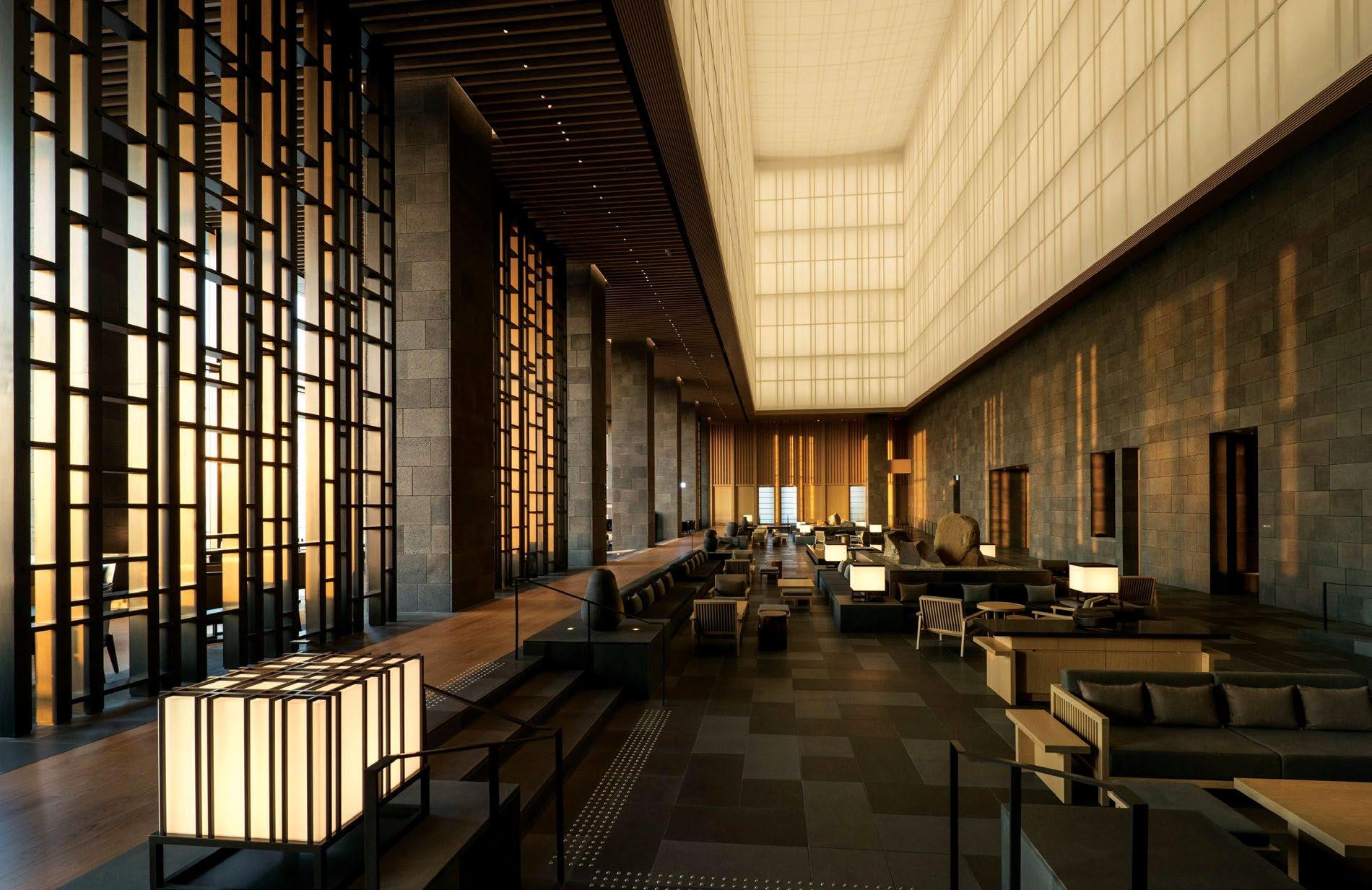
A minimalist volume where paper lanterns and timber grids create a meditative calm. Proof that spectacle can be quiet.
AMAN TOKYO
Japan



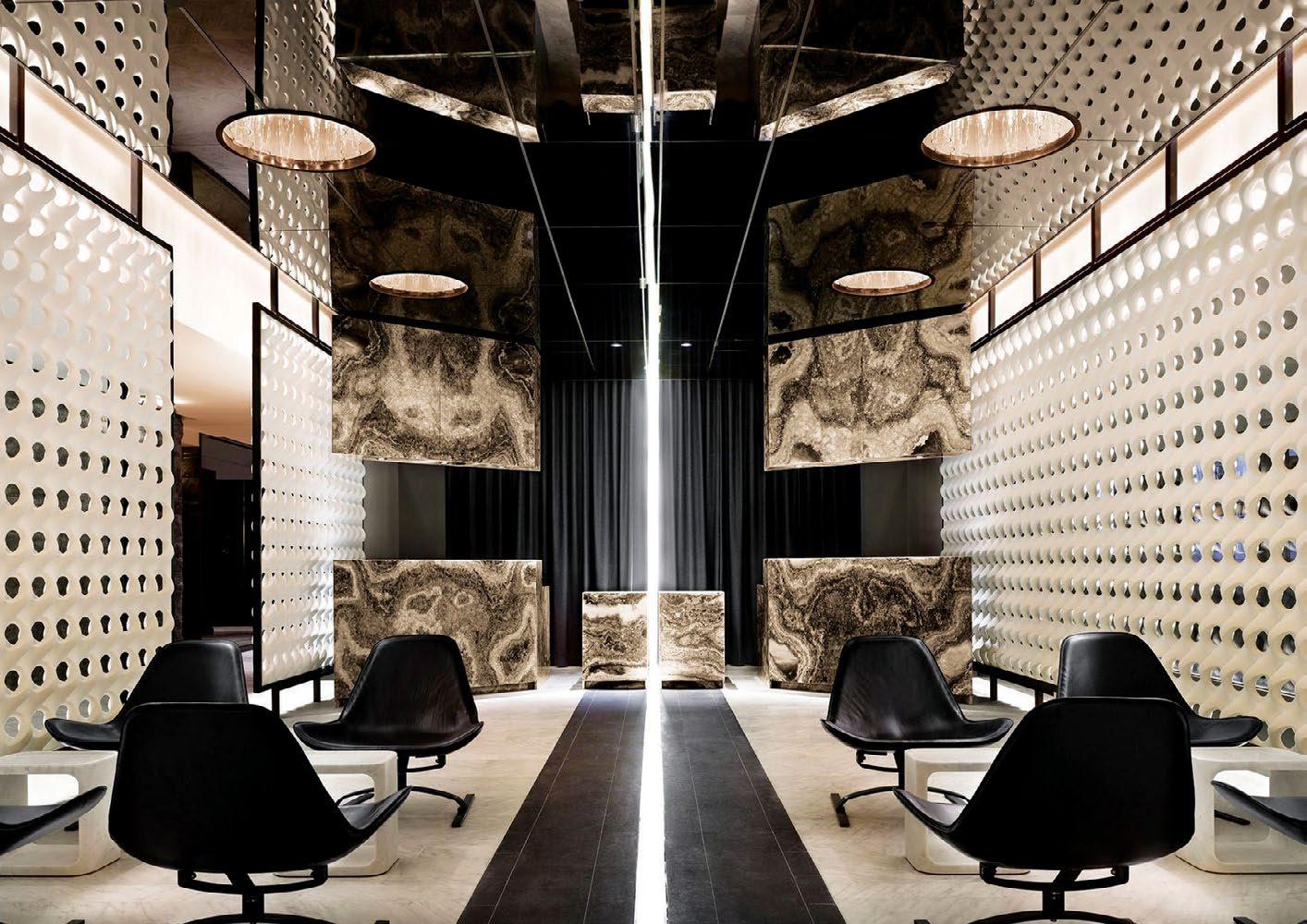
Singapore
Designed as an urban connector, its vast atrium doubles as a thoroughfare, dissolving the line between hotel and city.
New York
A lobby-as-nightlife-hub, where art, music, and culture flow as freely as cocktails.
MARINA BAY SANDS
THE STANDARD

Over a
century
of welcome
As India’s first five-star hotel, opened in 1903, the Taj Mahal Palace, Mumbai set the template for grandeur and welcome. Its lobby is more than an entrance—it is where Indian luxury hospitality first found architectural expression, and why it deserves a spotlight in this story of evolution.
Step through the teak doors and the Florentine-style hall unfolds with polished Italian marble floors, Corinthian pillars, and Murano chandeliers. The reception counters, once tucked along the side walls, became fashionable rendezvous points in the 1930s and 40s, when the Metro and New Empire theatres drew cinephiles nearby. Over the decades, these desks have witnessed arrivals that defined an era—from maharajas and heads of state to George Harrison and John Lennon.
The lobby also carries layers of memory. A remarkable canvas created in 2006 by Ratan N. Tata with artist Laxman Shreshtha speaks to the family’s bond with the hotel. Nearby, works by modern masters such as V.S. Gaitonde affirm the Palace’s role as a living gallery. The journey naturally flows to the cantilevered Grand Staircase beneath the 240-foot dome, where Mahatma Gandhi, Queen Elizabeth, and Lord Mountbatten once descended, and where a white horse famously climbed during the Animal Ball of the 1950s.
Even today, guests pause to admire masterpieces by Indian greats, proving that the Taj’s welcome is as much cultural as architectural—timeless, elegant, and deeply personal.

Palace, Sahara Star, and The LaLiT Mumbai remain touchstones of design, admired for their grandeur and theatre even today. Yet the conversation has shifted once more. Social media’s appetite for backdrops, technology’s erosion of the front desk, globalisation’s search for authenticity, and the economics of revenue generation are reshaping lobbies into stages, salons, and social condensers. From heritage to hybridity, the hotel lobby has become the heartbeat of hospitality.
The social stage: personality and performance
If the lobbies of the early 2000s impressed with spectacle, today they are asked to perform with personality. As Christian Lundwall, founder of Studio Kin—which he co-helms with creative head of design and partner Emma Nora Hedberg, and whose hospitality portfolio spans the US, India, Dubai and Europe—puts it, "A lobby isn’t just a place to sit and wait anymore, it’s a backdrop for selfies and stories. It’s like they’ve gone from being a coat rack to being a main character."
That sense of performance explains why younger brands have redefined the lobby as their stage. At
Moxy hotels worldwide—including the new Moxy Bengaluru Airport Prestige Tech Cloud—and across the ibis brand with properties such as ibis Mumbai BKC, the design DNA centres on communal lobbies where the bar doubles as check-in, laptops perch on long tables, and social energy is the real amenity.
Lundwall believes this reinvention has filled the void left by the shrinking front desk. "Without the reception counter, you must create other reasons for people to pause—bring the bar or café into the lobby, layer in music, art, flexible seating. Replace that lost ritual with new rituals: a coffee, a conversation, a moment of discovery."
Globally, The Hoxton, CitizenM, 25hours, and Ace Hotels showed how the lobby could become a brand’s living room. At The Hoxton, Sharan Pasricha—founder of Ennismore, now Accor’s joint venture in lifestyle and leisure hospitality—rewrote the rulebook. While others chased numbers, Pasricha chased connection, reimagining the Hoxton lobby as a cultural commons where guests and locals naturally converged. India’s newer properties are now picking up that rhythm, appealing to a generation that values connection as much as convenience.
The lobby of Hilton Gurugram Baani City Centre. Bobby Mukherji plays with light and scale. Olive trees anchor serene gathering zones.
Designing for flow and pause
From social stage to circulation hub, today’s lobbies must do more than dazzle: they must choreograph movement and stillness in the same breath. "A good lobby must move people through it carefully and tempt them to stay," says Lundwall. "If you treat light, acoustics, and furniture as signals—bright and open for flow, warm and tactile for linger—the space naturally choreographs different tempos."
Ankur Choksi, co-founder of Delhi-based Studio Lotus, known for hospitality projects such as RAAS Chhatrasagar, RAAS Devigarh, and Taj Theog Resort & Spa, Shimla, agrees. For him, the lobby’s dual role is best achieved through layered spatial experiences, intuitive navigation, and clusters of seating. "When done well, circulation is intuitive, yet there are always pauses along the way. The idea is to let people find their own rhythm—whether it is a guest rushing to the lift, a business traveller catching a quick coffee, or locals dropping in for an event."
He sees this evolution as tied to inclusivity. "Increasingly, the lobby is doubling as a cultural condenser—welcoming locals as well as guests. In urban contexts, it becomes porous and active, blurring the lines between the hotel and the city. In resorts, it takes on the role of the social watering hole, where stories are exchanged as naturally as drinks or meals." Choksi points to RAAS Chhatrasagar, Rajasthan, where the lobby merges with the all-day

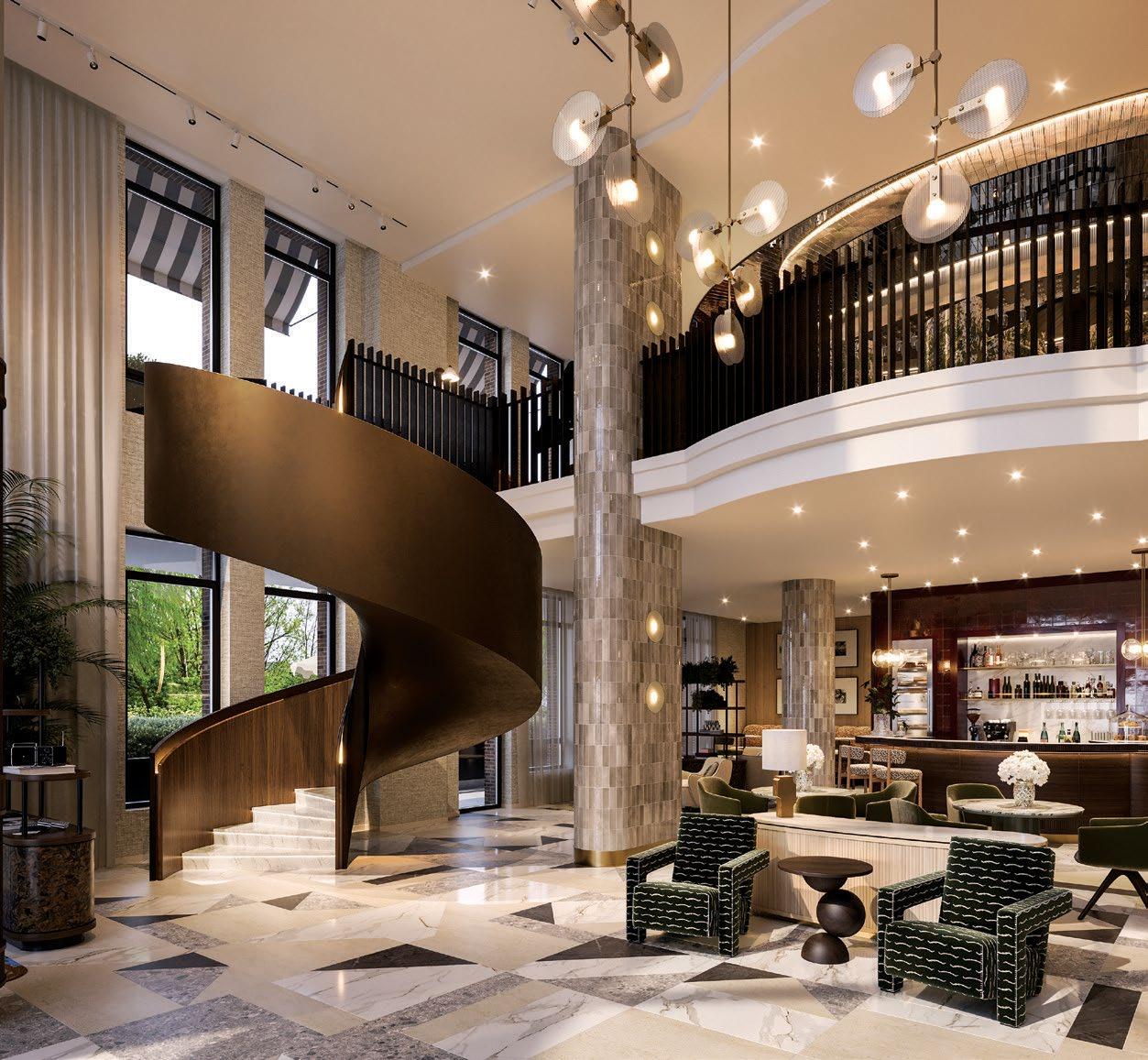
dining pavilion overlooking the lake, and Aloft New Delhi Aerocity, where a central courtyard shapes the experience. In both cases, the lobby is the communal stage, framing atmosphere, identity, and interaction. "I strongly believe (the lobby) is, and will continue to remain, the hotel’s most powerful communal space."
Cultural condensers
If globalisation has flattened tastes, authenticity has become the new luxury. "Our aim is not to mimic the vernacular but to interpret it," says Choksi. "Regional subcultures, local materials, and craft traditions bring authenticity without slipping into clichés."
Lundwall makes a similar point. "It’s less about hanging a postcard of the skyline on the wall, and more about capturing the rhythm and flavour of the city in subtle ways."
Indian examples illustrate this well. At Gateway Bekal, Kerala, the lobby is alive with storytelling. Carved elephant statues frame the arrival, while sari weaving is demonstrated live in the space, and evenings bring Mohiniattam performances accompanied by high tea. The lobby is not just décor but a cultural proscenium where local craft and tradition unfold daily.
At Grand Mercure Bengaluru at Gopalan Mall, the experience is equally layered. Guests are welcomed with the fragrance of Mysore sandalwood, while a Hoysala wood-carved sculpture anchors the atrium. Art walls curated with contemporary works by Karnataka artists are rotated regularly, making the
In the upcoming Studio Kin-designed Hyatt Regency Hamburg lobby, architecture meets atmosphere, and arrival flows into conviviality.
Grand Mercure Bengaluru at Gopalan Mall's lobby layers fragrance, sculpture, and art to celebrate Karnataka’s cultural heritage.
Typologies at a Glance
India’s lobbies reflect a spectrum of narratives, from heritage grandeur to youthful buzz.
These typologies show that the Indian lobby is not a monolith but a palette—each hotel selecting a hue that best tells its story.

Spectacle
The LaLiT Mumbai and Sahara Star, Mumbai turned the atrium into a stage, redefining scale.

Cultural
Gateway Bekal, Kerala and Grand Mercure Bengaluru at Gopalan Mall transform arrival into an immersion in local craft and tradition.
Youthful/social
ibis Mumbai BKC and Moxy Bengaluru Airport Prestige Tech Cloud channel energy into co-working tables, bars, and community-led buzz.
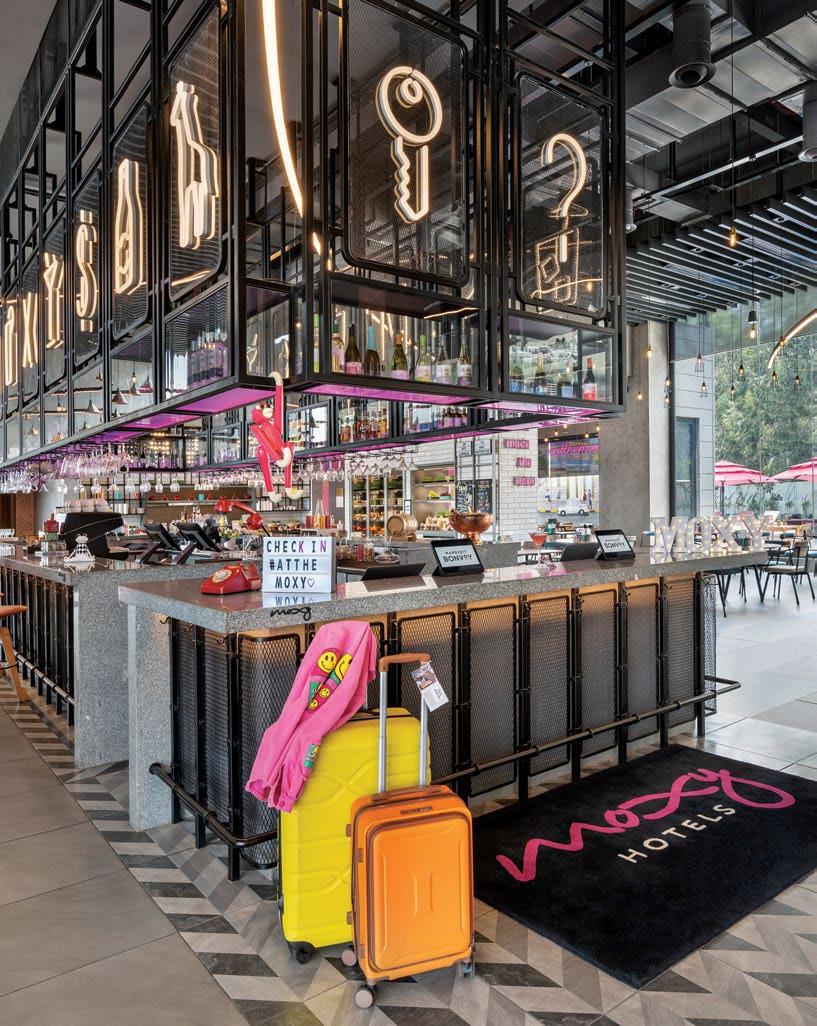
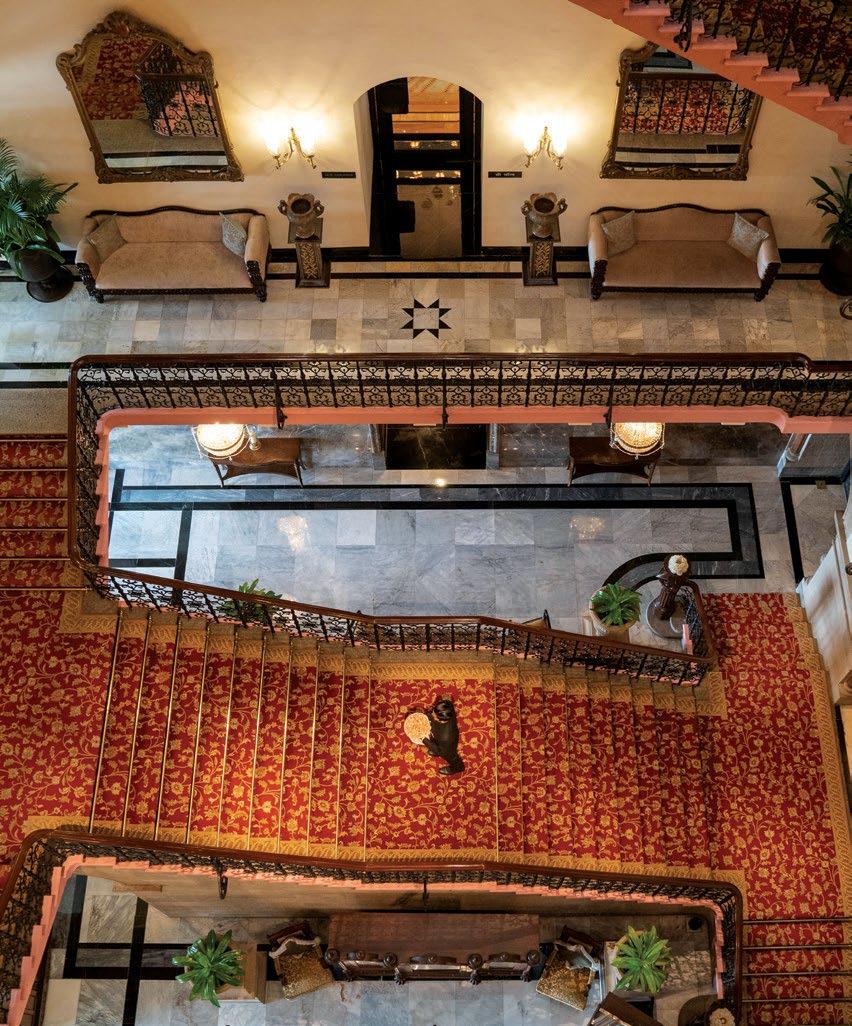
Heritage
Taj Mahal Palace, Mumbai remains the archetype of grandeur, its lobby etched in collective memory.

Ritual
The St. Regis Hotels & Resorts anchors arrivals in daily theatre, from Afternoon Tea to champagne sabrage.
lobby feel like an evolving gallery. Both prove that when lobbies engage directly with living traditions— whether through craft demonstrations, fragrance, or performance—they transcend design to become cultural condensers in the truest sense.
The lobby as a profit centre
From cultural identity to commercial viability, the lobby is increasingly judged by its ability to earn its keep. For Bobby Mukherji, founder of Bobby Mukherrji Architects and designer of several well-received hospitality projects such as the aforementioned Sahara Star, the space must work as hard as the guestrooms. "The entrance lobby has become a huge multipurpose space," he says. "Guests pass through it constantly, so the experience has to be special, and at the same time it has to generate revenue for the hotel beyond the guestrooms."
At Hilton Gurugram Baani City Centre, this thinking translated into a double-height lobby with skylights and seamless F&B. Mukherji describes the dynamic: "You see people on laptops, in meetings, ordering drinks and small bites. That makes the lobby a profit-generating space."
He points to the Lobby Atrium Bar at Taj Lands End, Mumbai as another benchmark. "From morning till midnight it’s always busy— business meetings, film scripts being discussed, tourists dropping in. That kind of buzz conveys the hotel is alive. It leaves a psychological impact on the guest."
For him, atmosphere drives revenue as much as design. "Lighting, acoustics, air quality, fragrance, comfortable furniture, good service—these make people feel good. When you step in from Gurgaon’s pollution into filtered air and soft music (of Hilton Gurugram), you feel the difference immediately."
The Lobby in Film and Pop Culture
Cinema has long recognised what hoteliers and designers know: the lobby is never neutral. It frames drama, sets mood, and becomes the first line of storytelling.


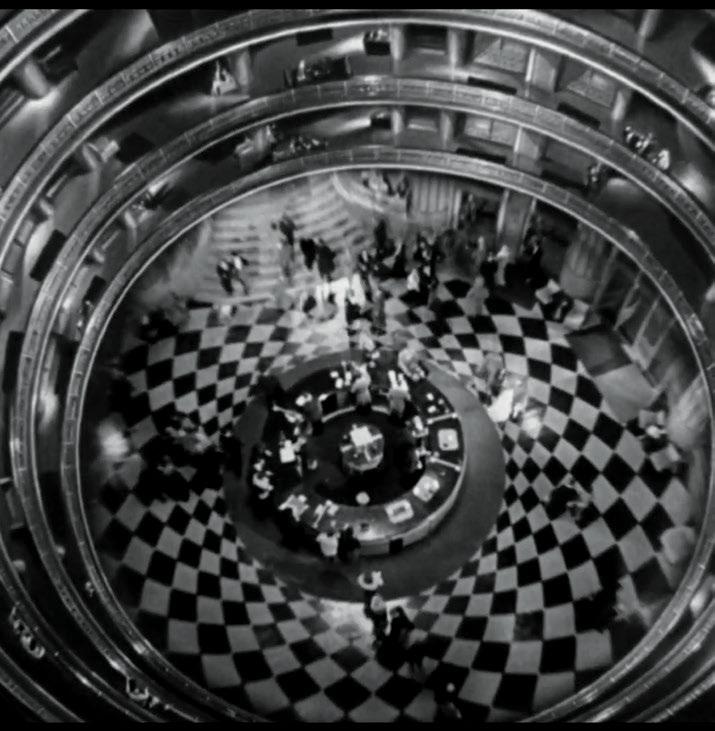
In Stanley Kubrick’s The Shining (1980), the cavernous Overlook Hotel lobby—patterned carpets, timber beams, echoing vastness— became menacing in its scale, as unsettling as any ghost.
In Home Alone 2: Lost in New York (1992), the marbled Plaza Hotel lobby was pure theatre, a stage for comic chases and childhood wish-fulfilment.
In Grand Hotel (1932), the bustling Berlin hotel lobby was a crossroads where the lives of strangers intertwined—a cinematic foreshadowing of the lobby as social stage.
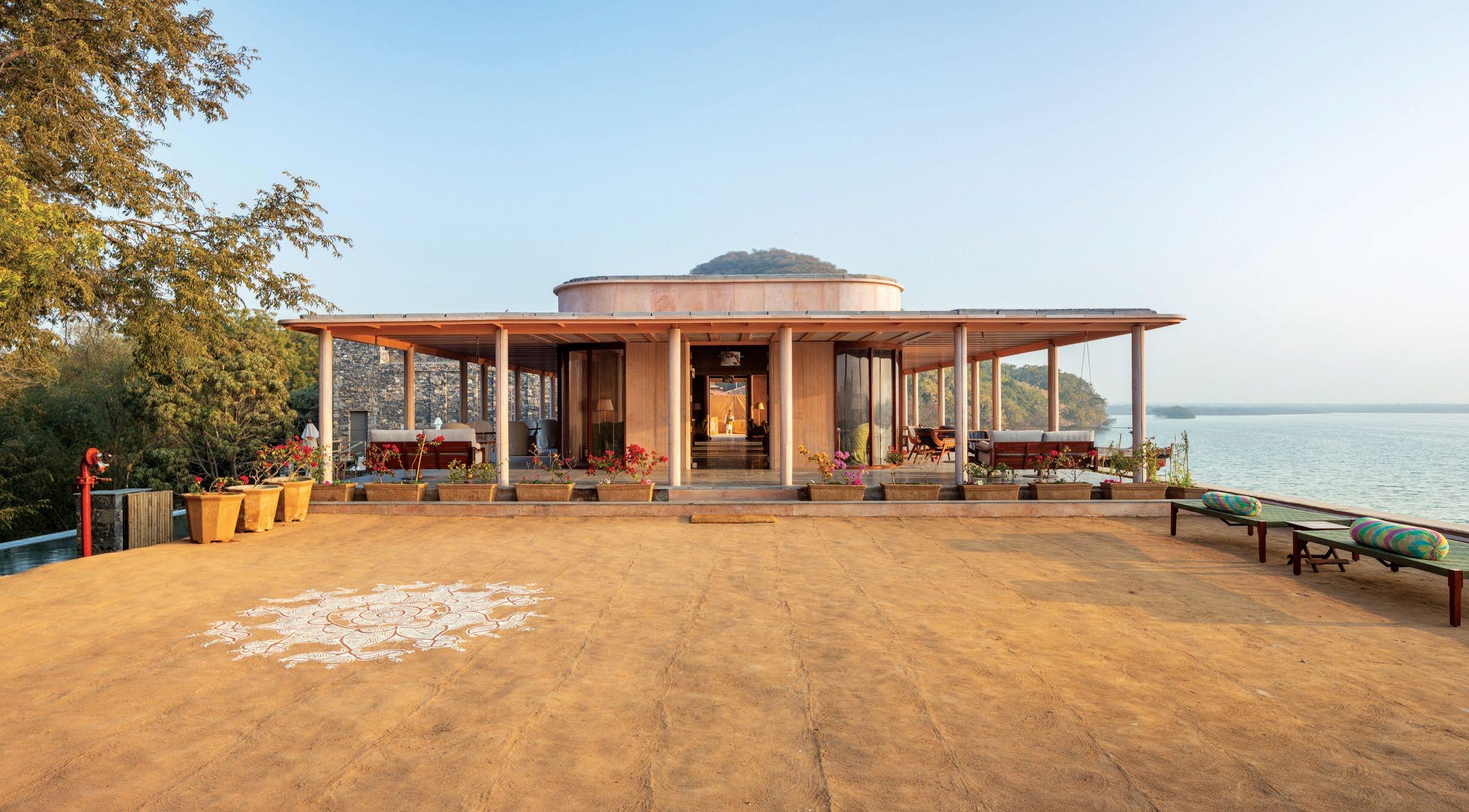
Rituals as anchors
From commerce to culture, lobbies also rely on rhythm. With the front desk shrinking, hotels have turned to ritual to anchor arrivals. At The St. Regis Hotels & Resorts worldwide, for instance, Afternoon Tea is reimagined for the modern guest, while the daily sabrage on the Grand Staircase at six o’clock is a performance of candlelight, sword, and champagne that turns arrival into theatre.
St. Regis is not alone in this. Around the world, hotels use ritual to transform lobbies into stages of anticipation. At Raffles Singapore, the long-standing Singapore Sling ritual is woven into its iconic Long Bar and lobby arrivals. At Aman Tokyo, evenings are marked by lantern-like light changes in the vast lobby, creating a moment of calm transition for guests returning from the city.
These are not services so much as experiences of belonging, repeated at the same time every day, grounding the hotel in rhythm. As luxury evolves, ritual offers a counterpoint to technology’s invisibility: a reminder that while check-ins may vanish into mobile apps, the memory of a shared toast or a daily performance lingers long after checkout.
The living room lobby
If rituals anchor the lobby in memory, atmosphere anchors it in daily life. For Yann Leroy, Chief Design Director at AXS Design with a portfolio spanning Sofitel, Pullman, and Novotel projects worldwide and a presence in Paris, Mumbai and Bangkok, the profound shift lies not in technology but in
experience. "The lobby as a living space, with at the same time coffee shop, reception, bar—that is a much more profound change than any technology," he says. "In new business hotels you see the same space evolve through the day: breakfast in the morning, co-working by afternoon, bar by evening. It is the living room of a younger generation, flexible yet familiar."
Luxury lobbies, however, resist such fluidity. "In the luxury context, people are not only buying a service, they are buying cultural depth. There is aspiration in a five-star environment, and that cannot be changed too quickly. You go to Disneyland for Mickey Mouse. You go to the Taj for the Taj experience."
While heritage itself can be the most powerful welcome, Leroy also finds the lobby of Sofitel New York (whose architecture he has designed) as ideal: "You enter through the leg of a T, and don’t immediately see the front desk. Instead you arrive in what feels like a Parisian living room with eclectic furniture. To find the desk you must go further in."
The hotel lobby has travelled far from its origins as a waiting room. Today it is plaza, gallery, living room, theatre, and marketplace. It is the stage on which hotels declare their identity, whether through spectacle, ritual, or community.
What unites these varied forms is a shared ambition: to create spaces where people want to pause, not just pass through. The desk may shrink, the technology may vanish, but the lobby remains the hotel’s most powerful communal space—alive, evolving, and always ready to surprise.
Studio Lotus anchors the RAAS Chhatrasagar lobby as a lakeside pavilion— welcoming guests with water, sky, and community.

A SPIRITED EVOLUTION


ABOVE LEFT: Banng Mumbai's Raya features vodka, finger root, toasted coconut, mushroom, soy, chili, and makrut leaf.
LEFT: A delectable drink from DPB, Taj Cidade de Goa Horizon.



The amber glow of India’s bars tells a compelling story: cocktail culture is blossoming into a vibrant tapestry of craft, storytelling, and soulful innovation.

DEEPALI NANDWANI
ABOVE: Republica Colombia from House of Paloma, Mumbai. ABOVE RIGHT: Boomerang, from Loqa Cocktail Room.
RIGHT: Cha Do is a warm, tea-based gin cocktail by Siren Cocktail Bar.

Fuelled by desi craft spirits and a nation eager to experiment, cocktails today feature unusual ingredients—smoked cardamom, Himalayan herbs, and local agave. Bartenders craft narratives that merge indigenous produce with chef-like techniques, while adventurous Indians explore drinks that transport them beyond the present, whether in sleek urban lounges or intimate ten-seater speakeasies, in major cities like Mumbai and Bengaluru or emerging metros such as Amritsar and Indore.
The evolution of the cocktail culture
Yangdup Lama, influential bartender and founder of awardwinning bars like Sidecar, named Industry Icon at Asia’s 50 Best Bars 2024, ties the growth of cocktail culture to India’s transformation.
"Urbanisation, rising disposable income, and changing social norms that embrace alcohol consumption among younger generations have

YANGDUP LAMA
BAR ENTREPRENEUR, BARTENDER, INDUSTRY ICON (ASIA’S 50 BEST BAR 2024), AUTHOR
"The rise of craft bars is enriching the drinking experience and highlighting the artistry of cocktails. Education—through workshops, online resources, and staff training—fosters curiosity, experimentation, and a deeper appreciation of diverse flavour profiles."
SHIV KANT VYAS BRAND MANAGER, THE LOVE HOTEL, DELHI
"The benchmark for a great cocktail is now set against the best bars in the world. We are building a culture that is more competitive, and we’re doing more covers than some of those coveted global spots."

Presentation enjoys the same importance as taste in new-age cocktails.
played a huge role," he says. "The rise of trained mixologists and craft cocktail bars has raised the quality and creativity of cocktails. The drivers of the business lead with passion, not just numbers. The focus is on customer experience, preferences, and social connection. Exposure through travel and collaborations has also shaped both consumers and bartenders. Unlike the global scene, where cocktails can feel standardised, India’s bars stand out for their use of regional spices, fruits, and herbs—rooting cocktails in our diverse culinary heritage."
This evolution is palpable at the bar counter. "India’s cocktail culture has moved from fluorescent, sugary cocktails to mixology," says Manoj
Padmanabhan, co-founder of Pandan Club (Chennai) and Cherrypond (Pondicherry). "There is a decisive shift towards spiritforward drinks, conscious ice programs, thoughtful glassware, and deeper ingredient sourcing. Guests now walk in asking why a specific garnish is used, or if we make our bitters in-house, or how we source our ingredients."
Ankush Gamre, Head Mixologist, Masque & Bar Paradox, Mumbai echoes this: "People are looking for a sensory experience— something that tells a story, reflects a place, its ethos, or uses seasonal elements. The cocktail menu cannot look like a bunch of drinks just thrown together anymore; it needs to be cohesive and well thought-out."
Storytelling as the heart of the cocktail
Much like luxury and travel, storytelling now defines India’s cocktail culture—curated experiences shaped by bartenders who are as much storytellers as alchemists. Drinks like ghee-washed gin sparked with charred clove ash or bourbon infused with pink Himalayan salt turn sips into journeys. "What was once dominated by spirit-forward classics has evolved into a space defined by refinement, experimentation, and storytelling," says Jones Elish, Beverage Head at Impresario. "Today’s guests are far more adventurous: they’re not just ordering a drink, they’re seeking balance, craft, and a sense of narrative. There’s a growing demand for thoughtful presentation, seasonal ingredients, and alignment with global cocktail movements."
This curiosity mirrors the wave of spirits sweeping India. "Ten years ago, it was mostly whisky-soda or the odd mojito," says Gresham Fernandes, Chef-Founder of Bandra Born. "Then came the big gin wave, suddenly every bar was doing craft G&Ts with Indian botanicals. Right now, we’re in the middle of the tequila and agave movement. Guests are also waking up to our own Indian spirit, mahua." His commitment is personal: "At Bandra Born we’ve gone all in. Downstairs is the world’s first mahua-dedicated bar, celebrating the spirit in all its forms. Upstairs, we build cocktails rooted in Bandra’s stories and flavours. Guests are on a journey through global trends and India’s own traditions."

GRESHAM FERNANDES
CHEF-PARTNER, BANDRA BORN
"Mahua, a wildflower spirit, has been part of tribal culture in India for centuries, but has never really had its moment in modern bars. Dedicating a whole bar to mahua is about giving it that stage."
ZORAWAR
KALRA FOUNDER AND MANAGING DIRECTOR, MASSIVE RESTAURANTS
"Storytelling is at the heart of what we do. At Mamma Killa, one of our signatures, The Tears of the Moon, is inspired by Andean-Aztec mythology but infused with Indian soul—a way of bridging worlds: ancient civilizations with modern mixology."

WE BELIEVE THAT REAL BEAUT Y LIES IN THE DETAILS and many more.









YATISH BANGERA
BAR MANAGER, BOMBAY DAAK, MUMBAI
"If the drink has depth and a reason behind it, people are choosing that over the usual safe orders. There’s a stronger pull toward drinks that are more personal and rooted."
JONES ELISH BEVERAGE HEAD, IMPRESARIO
"Local ingredients are not only sustainable but also create a true sense of place. A cocktail made with tender coconut water, fresh turmeric, and Indian gin captures nostalgia while also feeling elevated."

This layered approach—where provenance meets presentation— has become the hallmark of India’s new bar culture. "Cocktail bars in India are not just a design or drinks trend—it represents a convergence of refined taste, cultural intrigue, and a growing appetite for artisanal bar experiences," notes Rajib Mukherjee, Head Mixologist at ZLB23, The Leela Bengaluru. "These bars are thriving in metros such as Mumbai, Delhi, and Bengaluru, where discerning guests seek a ritual, a story, and a sensory journey."
The bartender-guest dynamic has also transformed. "Over the past decade, India’s cocktail culture has witnessed a striking metamorphosis—from perfunctory classics to a more evolved, experiential form of mixology," says Ramesh E, Beverage & Bar Manager at Library Blu, The Leela Palace Chennai. "Guests approach cocktails as curated experiences, valuing balance, aesthetics, and narrative. What was once a straightforward request for a gin and tonic has transformed into an articulate
preference for botanical profiles, garnish styles, and even glassware."
At 2:Fifty9 The Bar, JW Marriott Kolkata, this change is evident. "We’ve seen a shift from predictable classics to ingredient-forward cocktails," says the mixologist Laksh Tamang. "Guests are looking for a sense of occasion in every drink."
Cocktail design has also evolved. Anshul Tiwari, Head Mixologist at The Bagh and Tepah, Amritsar, notes: "Bartenders began putting modern twists on timehonoured recipes, experimenting with carbonation, clarification, fermentation, and molecular techniques. Today, menus are no longer generic—they are conceptual, unique to each bar, and often built around a theme or philosophy."
For bar owners, the focus is on the guest as much as the drink. "Our guests are engaged, informed, and genuinely interested in what goes into their glass," says Nitin Wagh, Co-owner, Loulou Cocktail Bar. "They want to know the provenance of ingredients, the



BELOW LEFT: SpicyJams, a collaboration between Frida González and Loya, New Delhi.
BELOW RIGHT: Naruto's Rush, Harajuku Tokyo Café.



story of the spirit, and even the background music. It’s exciting to see this cultural shift where people are moving away from loud, crowded clubs and gravitating toward more intimate, thoughtfully designed bars."
Lama emphasises the role of education: "Education plays a vital role in this shift by empowering consumers through mixology
workshops, online resources, and enhanced training for bar staff. Such initiatives encourage experimentation and curiosity about diverse flavour profiles. Events like cocktail festivals further expose consumers to a variety of styles and techniques, ultimately enriching India’s beverage culture and reflecting broader societal trends."
From neon spectacle to artisanal creations
India’s cocktail culture has shifted from flashy, formulaic drinks to refined, layered experiences. "Ten years ago, bars were about flair shows, neon drinks, and imported bottles lined up just for show," reflects Yatish Bangera, bar manager of Mumbai’s Bombay Daak. "Now, it’s gone from flashy to thoughtful. It’s about how the drink makes someone feel, not just how it looks or tastes. A great cocktail

RAJIB MUKHERJEE
HEAD MIXOLOGIST, ZLB23, THE LEELA PALACE BENGALURU
"A well-crafted narrative and concept-driven drinks elevate a simple cocktail by giving it context and meaning. It allows bartenders to showcase the thought behind each element."
MANOJ PADMANABHAN FOUNDER, PANDAN CLUB AND CHERRYPOND
"We have Gen Z guests experimenting with Cup Noodle (made using a Maggi noodle broth) and older guests enjoying an Amla Spritz. People are drawn to a place that doesn’t feel like ‘just a bar’ but a community space."

The luscious interiors of Banng Mumbai support energetic, cocktail-fuelled nights.
should surprise people in a good way without making them feel out of place. We innovate in quiet ways—new techniques, unfamiliar ingredients—but always keep the experience friendly and intuitive. If someone asks for a Whisky Sour, we might offer a version with tamarind or smoked jaggery, but we’ll never complicate it for the sake of being clever."
Guests care deeply about provenance, asking questions about ingredients and their origins.


Krishna Kumar, Head Mixologist, Loqa Cocktail Room, Hyderabad, observes: "Guests don’t just ask what’s in the drink anymore— they ask why, how, and where it’s from. It helps us push boundaries and share the story behind every drink."
Zorawar Kalra, Founder and Managing Director, Massive Restaurants, calls this a renaissance of craft. "We’ve moved from generic mixes to an appreciation for balance, technique, and narrative."
At Mamma Killa in Delhi, cocktails built on regional ingredients and Indian-made spirits reflect a wider appetite for authenticity.
Akshay Singh, head mixologist at Bengaluru’s Siren Cocktail Bar, channels this demand into culinary-style cocktails inspired by Chinese cuisine. "It’s no longer about ordering a Whisky Sour—it’s about understanding what makes our version unique. This curiosity has made bars more interactive."
Shiva Kant Vyas, Brand Manager at The Love Hotel, Delhi, notes the shift toward intimate spaces: "Storytelling and playful ideas matter, as bars shrink into
10- to 30-seater formats, moving beyond hotels and creating highly interactive experiences. People go to bars not just to drink but to be entertained."
Noel Mendes, Director of F&B, Four Seasons Hotel, Mumbai, emphasises curating experiences: "There’s a visible shift in consumer expectations, from volume to value, from familiarity to discovery. We’ve moved from simply serving drinks to curating experiences where artistry and narrative are central."
International exposure has elevated the scene. Dimi Lezinska, partner at Mumbai’s Miss Margot, says: "Indian bartenders are more skilled than ever, benefiting from competitions, travel, and initiatives such as Cocktail Week and India’s 30 Best Bars. Customers now trust bartenders to craft refined experiences, restaurants design nightlife around cocktails, and consumers are more willing to explore new flavours—even if Picante still reigns as the drink of the moment."
The cocktail experience is audacious yet accessible. Mendes underscores: "A great

FAY ANTOINE BARRETTO
BAR CONSULTANT, HARAJUKU TOKYO CAFÉ AND SCARLETT HOUSE, MUMBAI
"I’ve sourced ingredients from forests and farms—stone fruits with pine; Mahua in varied forms; and even red ant chutney, which I’ve woven into drinks at The Citrus Garden Project in Madhya Pradesh."

ANKUSH GAMRE
HEAD MIXOLOGIST, MASQUE AND BAR PARADOX, MUMBAI
"Sustainability drives us: we ferment fruit scraps, craft zerowaste cordials, and repurpose peels, piths, and kitchen waste to create bar ingredients."
LEFT: Oh My Ghee from JW Marriott Kolkata combines coffee, rum, bourbon and ghee.
RIGHT: Babuna Bliss by Aer, Four Seasons Hotel, Mumbai.
FAR RIGHT: Auntie's Hooch, Dublin - ITC Grand Central, is inspired by home-brewed spirits.


RAMESH E
BEVERAGE & BAR MANAGER, LIBRARY BLU, THE LEELA PALACE CHENNAI
"India’s cocktail culture has witnessed a striking metamorphosis—from perfunctory classics to an evolved form of mixology, from seeking intoxication to seeking stories, craftsmanship, and provenance."

cocktail experience should stimulate the senses and spark conversation, while balancing bold experimentation with approachability. Innovation means nothing if it alienates the guest."
Kalra adds: "At Mamma Killa, we create drinks that are intellectually stimulating yet instantly enjoyable. Surprise should meet satisfaction; curiosity should never come at the cost of comfort."
At The Love Hotel, Vyas explains: "You need great food, you

NOEL MENDES
DIRECTOR, FOOD & BEVERAGE, FOUR SEASONS HOTEL, MUMBAI
"A great cocktail experience is immersive. It stimulates the senses and sparks conversation. Innovation means nothing if it alienates the guest."

THE GLOBAL VIEW
Frida González, co-owner of Aruba—Tijuana’s pioneering Day Drink Bar ranked No.22 on North America’s 50 Best Bars 2025—recently brought her cocktails to Loya at Taj Palace, New Delhi.
"Aruba is our sun-drenched sanctuary, where cocktails, music, and colour create a multisensory experience. Each drink is paired with a Spotify track and a colour to reflect the mood we want guests to feel. It’s storytelling—where the drink isn’t just tasted, but felt," she explains. Fruity Palooza, for example, is a tropical explosion paired with a dance track and coral hue, playful and nostalgic, designed to evoke joy.
Her collaboration with Loya revealed new dimensions for both her and the Indian bartenders. "While North America focuses on technique and innovation, India brings ritual, storytelling, and regional depth. At Loya, cocktails are woven into the meal, part of a larger theatrical narrative— drama in the spices, the techniques, the flavours. That’s what makes it special."


House of Paloma's interiors blend Latin American elements with contemporary design.
need to make guests feel seen (even in the dark, in our case), and you need to build conversation around the drinks. Accessibility has many layers. You want to be sustainable without leaving guests stressed about the bill. Narrative is another. We list volumes, ABV%, and flavour notes to make every drink easy to understand."
Mendes adds a theatrical flourish: "We anchor our cocktails in flavours people recognise but present them in unexpected and theatrical ways. The experience should stimulate the senses and spark conversation. Bold experimentation must always be balanced with approachability."
ZLB23's Mukherjee speaks to the guest dynamic: "People are looking for quality, authenticity, and a sense of discovery. They appreciate thoughtful presentation,

MEGHA BHATIA GENERAL MANAGER, TAJ FORT AGUADA RESORT & SPA, GOA
"Sustainability is central to our approach. Most syrups are made in-house, and many herbs and flowers are grown on-site, ensuring freshness and avoiding artificial additives."
BERWYN JEREMIAH DA SILVA BEVERAGE HEAD AND MIXOLOGIST, DPB, TAJ CIDADE DE GOA HORIZON
"Presentation matters more than ever—from the garnish and glassware to lighting and movement. Elements are designed to be visually compelling and camera-ready."


unique ingredients, and a drink that reflects the bar’s identity or local culture. Some guests are adventurous and want to explore, while others seek something classic and reliable."
Mindful drinking and botanical flavours are on the rise. Chethan M V, Brand Ambassador for Davana Vermouth Indica, points to the
aperitif revival: "Vermouth, once known only behind the bar, is now stepping into the spotlight. Its versatility is unmatched, whether in cocktails, classics such as Negroni and Manhattan, or served chilled, on the rocks, or with tonic. With palates evolving, low ABV drinks are in trend, and vermouth fits perfectly into this shift."

Defining the cocktail experience
Aditya Sharma, Beverage Manager at The Leela Palace Jaipur, describes returning to India as stepping into a cocktail renaissance. "Guests in luxury hospitality seek sophistication without snobbery. A standout drink isn’t just what’s in the glass—it’s the story it tells, the way it looks, and the small surprises along the way. Our menu is designed like a well-curated playlist: a mix of comfort hits—familiar classics with a twist—and a few bold tracks for those ready to explore uncharted sips."
Innovation must remain drinkable, not just Instagram-able. "For me, it’s about making guests feel like they discovered something new but didn’t

ADITYA SHARMA BEVERAGE MANAGER, THE LEELA PALACE JAIPUR
"In luxury hospitality, guests seek cocktails with sophistication—but without snobbery. Today, a standout drink is defined not just by its ingredients, but by the story it tells, its presentation, and the small surprises it delivers."
ANSHUL TIWARI HEAD MIXOLOGIST, THE BAGH AND TEPAH, AMRITSAR
"Our association is firmly committed to a sustainable path so as to contribute, through cuisine and hospitality, to building a more humane and united world."

The layered immersive interiors of Miss Margot are anchored by a handsome bar.
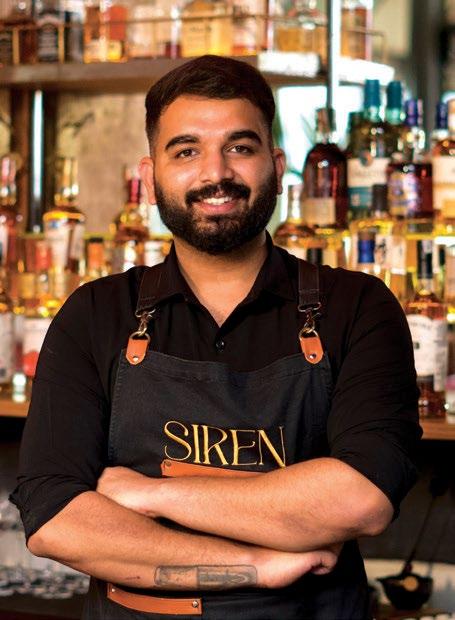
AKSHAY SINGH
HEAD MIXOLOGIST, SIREN COCKTAIL BAR, BENGALURU
"Many guests are interested in the process—whether it’s fat wash or milk clarification. This shift has given us the freedom to showcase creative, conceptdriven drinks."
MANISH KUMAR BEVERAGE MANAGER, THE LEELA PALACE NEW DELHI
"Our cocktail Pablo Picasso, rooted in Indian pickling traditions, blends tequila with a house-made brine of vinegar, olive brine, chilli, and warm spices, offering an elegant, spice-forward sip that’s as bold and abstract as Picasso’s art."

have to work too hard to enjoy it," says Fernandes. "The Wild Flower-ita, for example, is essentially a margarita, but with Mahua, coriander, and lime, it’s accessible, yet opens your eyes to a whole new spirit."
Elish notes: "It’s about the energy at the bar, the presentation, and ultimately how it makes the guest feel. Our approach is to keep flavours intuitive and welcoming while layering in innovation through technique or unexpected pairings. A drink might look avant-garde, but when you take that first sip, it’s instantly relatable."
At Loulou, this philosophy comes to life in every detail—from music to mood, from glassware to garnish. Fay Barretto, bar consultant at Harajuku Tokyo Café and Scarlett House, adds: "Today, cocktails are techniqueforward, with a growing focus on culinary-inspired drinks. Many bars now tie cocktails to meaningful narratives or local communities. At Scarlett House, we serve Wishful Thinking, a gamified drink where guests pick a word from a box of over 10 wishes to determine their cocktail. Another, Marriage, features East Indian wedding rice and a traditional wedding pickle sourced from Sandra, a beloved local on Bazaar Road."
Accessibility and curiosity intertwine. Bars pair adventurous flavours like yuzu, wasabi, or kimchi with approachable profiles. Padmanabhan explains: "A great cocktail experience doesn’t start with the drink; it starts with how the menu feels in your hand, how the story is told, how the glass hits the table, how the garnish lands, and only then, the taste. Balance is everything—not just in the drink but in the entire guest journey." Kumar of Loqa, avers, saying: "It’s a combination of delicious drinks, storytelling, friendly bartenders, the right vibe, and great music—all in equal proportion." Siren Cocktail Bar's Singh draws attention to how the drink is delivered to the guest: "Service is equally vital—we guide guests through the menu to find what excites them."
While this experimention is understandably exciting, some voices advocate for a return to the classics. Vedant Newatia, Founder, Atelier
BELOW LEFT: Pandan Club's Tongue Twister features kaya, pandan, and coconut jam. BELOW RIGHT: Vanilla, tequila and fruit jam come together in Bandra Born's Doppelganger. OPPOSITE: A salty mix of whiskey, pineapple, soy, and burnt butter from The Love Hotel.



V, says: "Bars that master fundamentals—balance, technique, quality ingredients—stand out, even while reinterpreting classics with native spirits like Feni or Mahua. Classics are familiar but crafted with care, they feel fresh. Guests are reaching for Old Fashioned, Whisky Sour, Negroni, or Espresso Martini—not out of nostalgia, but for the beauty of balance and simplicity. Modern cocktails may deliver a moment, but classics keep people coming back."
Vikram Achanta, founder of Tulleeho and co-founder of 30BestBarsIndia, notes: "The formula for a good bar comes down to essentials: skill, story, and accessibility. Spirit-led bars are carving signature sections of their menu dedicated to classics, offering guests both discovery and familiarity."
Three Pillars of India’s Cocktail Renaissance 1
The Art of Storytelling
India’s cocktail renaissance weaves myth, culture, and heritage into every sip, transforming drinks into memorable experiences where memory, emotion, and flavour converge. Storytelling elevates a cocktail from refreshment to a narrative journey.
Kalra sees mythology as central: "Each cocktail is a chapter in a larger mythology, poured from a ritual chalice or revealed in a swirl of smoke, inviting guests to connect." Vyas of The Love Hotel adds: "Every cocktail carries wit and immersive design, blending tempo, scent, and touch to enchant."
Cultural narratives shape menus. Singh’s Chinese-inspired cocktails at Siren evoke dishes or traditions, turning sips into shared journeys, while Mendes’ Yachtside Cocktail Collection at Aer frames drinks as a seafarer’s odyssey, from serene to wild. Kumar from Loqa, insists: "Without a story, a cocktail lacks soul." Bangera of Bombay

LAKSH TAMANG
MIXOLOGIST, 2:FIFTY9 THE BAR, JW MARRIOTT KOLKATA
"A great cocktail is about the story, the setting, and the feeling it leaves behind. We balance innovation with accessibility, crafting playful, layered cocktails anchored by familiar flavours, cultural references, or visual cues."
SHUBHAM SETIA
CO-OWNER, LOULOU COCKTAIL BAR
"Bimbli Spritz—a coastal twist on the classic spritz with pickled bimbli, gin, and ginger ale—reflects Goan terroir, frugality, and the belief that every ingredient deserves a second life."

Daak agrees: "Storytelling builds anticipation, making the drink personal and memorable."
Rajib Mukherjee of ZLB23 notes: "Concept-driven drinks spark curiosity and conversation, leaving lasting emotional impressions."
At Library Blu, Ramesh E sees storytelling as "the soul of our offerings, exploring mythology and folklore through flavour and presentation."
Heritage spirits ground these narratives. Gresham Fernandes of Bandra Born says: "Mahua carries the story of a revived spirit; Zig Zag Nights nods to my skateboarding days." Rupi Chinoy, Director, South Seas Distilleries, calls Six Brothers Mahura "India’s iconic heritage spirit, ready for a global revival."
At DPB, Taj Cidade de Goa Horizon, Da Silva’s cocktails—DPB Signatures, Art & Culture, and Classics Reimagined like Saturday Night Movies—blend nostalgia and local culture.
Anshul Tiwari of The Bagh and Tepah notes: "Storytelling creates
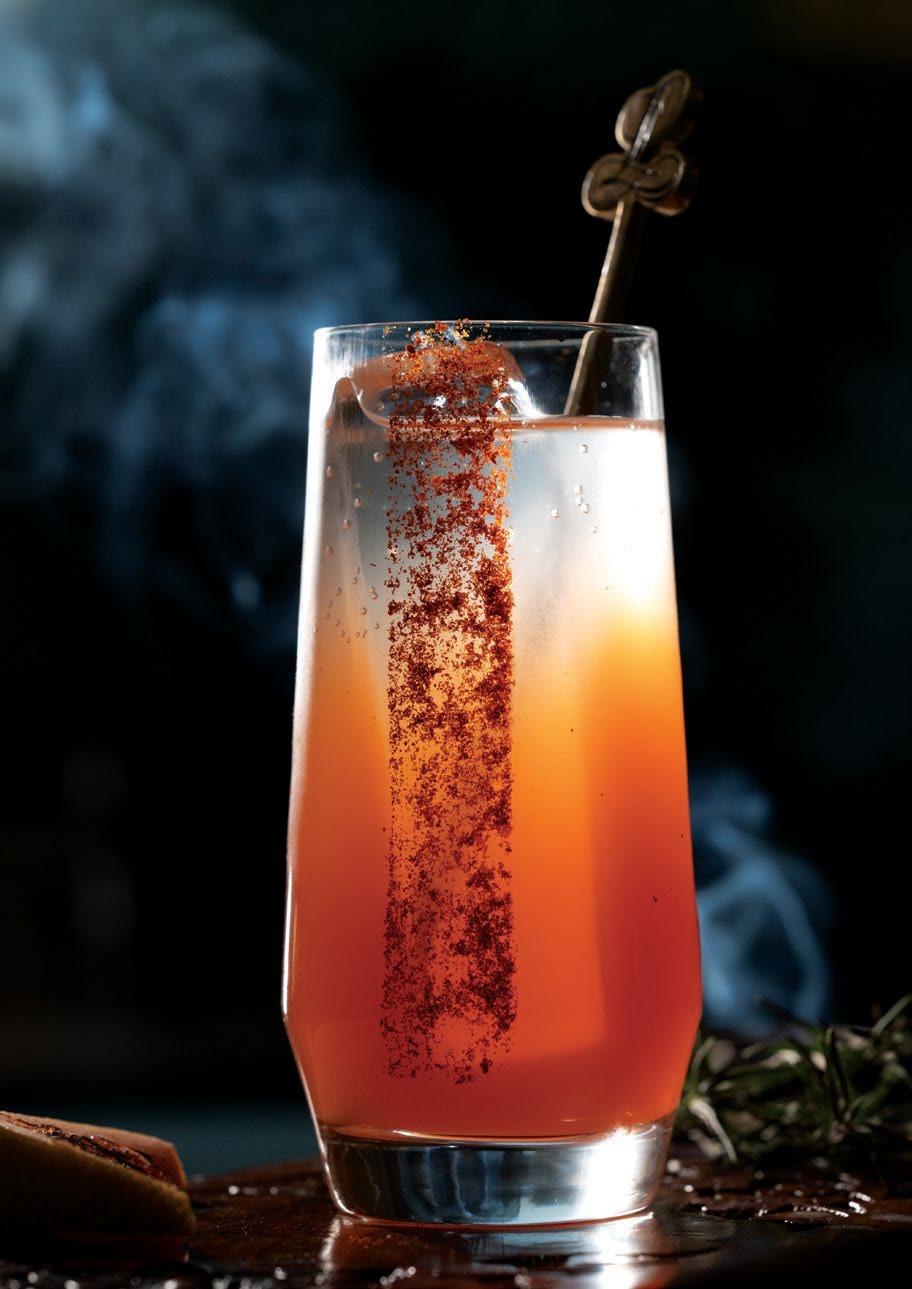
connection, moving beyond ingredient lists to evoke place and feeling." Avanish Chaturvedi, F&B Manager, ITC Grand Central’s Dublin – The Irish Bar, points to Auntie’s Hooch which honours Bombay’s East Indian community, while Megha Bhatia, General Manager, Taj Fort Aguada Resort & Spa, Goa says their High Fidelity and Patrao’s feni add drama and tribute. Laksh Tamang’s RSVP and Taxi Queen at 2:Fifty9 connect emotionally—the former plays on celebration, while the latter channels the energy of a Kolkata cab ride. And Avantika Malik’s Shaazu Sour at Mizu Izakaya carries nostalgia that "elevates the sip".
Aditya Sharma’s Regal Rajasthan menu at The Leela Palace Jaipur and Manish Kumar’s Literary Mixology at The Leela Palace Delhi tie drinks to regional grandeur and novels. "Storytelling is the secret ingredient. Without it, a cocktail is just liquid. With it, you have a memory in a glass," says Sharma.

BELOW LEFT: Jharokha cocktail by The Leela Palace Jaipur.
BELOW RIGHT: Picante from Library Blu, The Leela Palace Chennai.

2
Craft Cocktails and Regional Influences
Bartenders blend craft, heritage, and narrative into immersive drinks rooted in Mahua, coastal Goa, or Chennai-Singapore fusion, sparking curiosity and pride. Indian craft spirits shape global and domestic scenes. Yangdup Lama says: "Brands inspire through training and tastings, diversifying menus and positioning Indian spirits as global players celebrating regional heritage. They engage consumers,
encouraging appreciation of Indian craftsmanship. This evolution diversifies cocktail menus and positions Indian craft spirits as influential players in the global beverage landscape, appealing to environmentally conscious consumers while celebrating regional heritage."
Zorawar Kalra observes: "India’s cocktail scene balances global sophistication with local terroir." Noel Mendes adds: "Guests crave classics infused with Indian ingredients." At DPB, Da Silva uses Goa’s kokum and curry leaf for sensory drinks. Gresham Fernandes’ Mahua Bar offers Tribal Negroni, swapping gin for Mahua, and Yuzuilla, blending tequila with yuzu and jalapeños.
Classics like Negroni and Old Fashioned anchor menus, but local ingredients drive innovation. Jones Elish says: "Indian gins, rums, and mahua reflect cultural identity." Ramesh E notes: "Classics are canvases for local reinterpretations, with guests
BELOW LEFT: A 110-year-old piano stars in Loulou Cocktail Bar's vintage-inspired decor. BELOW RIGHT: Kyoto-inspired speakeasy bar ZLB23 evokes a sense of mystery and intrigue.

intrigued by traceability." Krishna Kumar highlights tequila’s earthy rise.
At Loulou, Mixologist Azavedo Firman draws from European apothecaries and Indian distillates. "Our cocktails celebrate homegrown ingredients and distillates, reflecting how India’s drinking culture is taking pride in its roots." Pandan Club’s Serangoon Smith fuses Tamil Nadu coconut and Singaporean gula melaka.
Fay Barretto’s Tokio Drift at Harajuku Tokyo Café blends tequila, the fiery twist of Sichuan pepper, and the fragrance of hibiscus. Aditya Sharma spotlights Goan gins and Indian rums, while Dimi Lezinska’s Wanderlust’s Old Fashioned uses Otherside Whiskey with saffron. Fernandes adds: "Drinks like Phool Me Twice, pairing mahua with elderflower and tonic, show how light, floral, and versatile the spirit can be."
Bangera notes growing interest in local spirits like feni, balancing classics with rooted innovation.

The Bartender as Chef Indian culinary trends, rich in spices, herbs, and regional ingredients, shape the cocktail landscape. Lama says: "Taking advantage of history, heritage, and diversity, bartenders are incorporating traditional spices to create unique flavours that resonate locally and internationally."
Culinary techniques redefine the bar. Vyas highlights innovations such as rotovaping, sous-vide infusions, miso butters, and charred vegetables: "The rise of savoury cocktails has opened our minds and made us ambitious about cooking flavours behind the bar."
One of The Bagh and Tepah, Amritsar’s signature cocktails, Tikki Amritsar, is inspired by the city’s bold tikka culture—rich, vibrant, and full of flavour. Another favourite, the Lassi Cocktail from Tepah, reimagines a Punjabi ritual of kulcha with lassi. "Traditional lassi can feel heavy, so we lightened it into a boozy cocktail that preserves its familiar flavours while keeping it nostalgic and easy to drink," says Tiwari.
Malik notes: "We’ve seen a big shift toward lower-sugar, more balanced drinks, and a willingness to experiment with savoury, spiced, and umami-forward profiles."
Vaishali Mehta, Founder, Swa Artisanal Syrups adds: "Bartenders are thinking like chefs, drawing from regional flavours and seasonal ingredients. Think kokum-cumin, jaggery, or even jackfruit in your drinks."
Bhatia says: "Guests are more interested in how far flavours can be pushed, embracing techniques from molecular gastronomy and minimalism. Ingredients like kokum and bimbli, paired with native Goan spirits like feni and uraak, are gaining popularity."
Sharma describes the local
pantry as a treasure chest: "Kokum, betel leaf, tamarind, mango, curry leaves—you name it. Palace Nectar with gin, kaffir lime, fresh coriander, and a splash of pineapple explores India’s expansive terroir with every glass."
Ramesh E adds: "Local ingredients lend not only depth of flavour but also emotional resonance. Namma Madras—a cocktail composed of white ruminfused with curry leaf, green chili, coconut water, Kodam Puli, and cinnamon honey—evokes place and memory."
Kalra stresses: "Spices, citrus, herbs, jaggery, kokum, and curry leaves bring a distinct personality. Pizza-Ila is a perfect example of how flavours from the kitchen can be reimagined behind the bar."
Kumar adds: "Local ingredients evoke nostalgia and celebrate regional identity. The Pablo Picasso—tequila infused with Indian aromatics—offers something familiar yet original."
Padmanabhan underscores emotional resonance: "Tebu Tebu, using sugarcane juice and coriander seeds, is a tribute to Chennai’s sugarcane stalls, layered with the finesse of a craft cocktail."



AVANISH CHATURVEDI
F&B MANAGER, ITC GRAND
CENTRAL’S DUBLIN – THE IRISH BAR
"Social media has turned cocktails into a visual art form—guests want drinks that are both Instagram-worthy and flavourful. At Dublin, presentation is as vital as taste."

KRISHNA KUMAR
HEAD MIXOLOGIST, LOQA COCKTAIL ROOM, HYDERABAD
"The cocktail experience is not just about the drinks; it's a combination of delicious drinks, storytelling, friendly bartenders, vibe and music, all in equal proportion."


A broader demographic and cultural challenges
cultural and religious beliefs create a stigma around alcohol consumption. Traditional drinking patterns still favour straight drinks like whiskey and beer over cocktails."


AVANTIKA MALIK HEAD MIXOLOGIST, MIZU IZAKAYA
"Earlier, guests rarely asked beyond ‘what’s in this drink.’ Now, they inquire about the ice style, spirit proof, origin of the bitters, or how the juice was clarified."
India’s cocktail scene has evolved alongside a broadening demographic. Yatish Bangera says: "Today, we see older guests exploring options beyond whiskey and soda. There’s more openness and less predictability, which makes our job a lot more fun." Kalra adds: "Our audience spans generations but is united by mindset. The 25-year-old entrepreneur is just as invested in the ritual as the 50-year-old collector."
Ramesh E highlights the rise of the female connoisseur: "Women guests are exploring spiritforward profiles and mixology events. Expectations have become more layered, and we cater to sensibilities, not stereotypes." Challenges persist. Lama explains: "The growth of cocktail culture in India faces significant hurdles due to regulatory and cultural barriers. Alcohol regulation varies by state, resulting in complex licensing processes and high taxation. Additionally,
And yet, bartenders are leveraging India’s culinary heritage to elevate cocktails. Lama continues: "By incorporating local flavours and ingredients, along with educational initiatives such as tastings and workshops, bartenders are making cocktails more appealing. Targeting metropolitan areas with a more open mindset allows establishments to thrive, while promoting responsible drinking, while cultural sensitivity helps integrate cocktail culture into India’s broader social fabric." Cocktails today are immersive experiences reflecting India’s terroir, heritage, and global techniques. As Vyas says: "The benchmark for a great cocktail is now set against the best bars in the world… In short—we’re drinking bloody well."
ABOVE: Siren offers Chinese-inspired cocktails in a chic, moody setting. LEFT: Patron Perfect Picante, by Taj Fort Aguada Resort & Spa.

DIMI LEZINSKA
PARTNER, MISS MARGOT, MUMBAI
"We craft cocktails with purpose— balanced, intentional, and made to enhance the moment. We honour the classics while embracing creativity, and focus on quality ingredients, smart techniques, and the power of simplicity."


Guardians THE OF GUEST JOY
With a leadership style as layered as a signature kebab platter, Mavela Das of Conrad Pune is bolstering the luxury dining experience—through empowerment, consistency, and the power of human connection.

MAVELA DAS
Restaurant Manager
Coriander Kitchen, Conrad Pune
At Conrad Pune, a Japanese guest once asked about a bookstore carrying Japanese newspapers. The next morning, a freshly printed copy—downloaded and neatly placed with his tea—awaited him at breakfast. The ritual continued through his stay. “Later, he sent a heartfelt email of thanks,” recalls Mavela Das. “That reaffirmed why I love this profession—it’s about gestures that go far beyond a meal.”
Running the show: Das leads two of Conrad Pune’s marquee dining venues— all-day restaurant
Coriander Kitchen and Indian specialty restaurant
Zeera—managing a 30-member team with precision and warmth. “A true leader balances efficiency with empathy—a standard I hold myself and my team to.”
Training with a twist: Daily role-play training has sharpened her confidence and communication, helping Coriander Kitchen climb to #6 among nearly 6,500 restaurants in Pune on TripAdvisor. She credits this to “a culture of accountability and continuous improvement, where the team feels empowered to deliver their best.”
Heart over hustle: What drives her most is human connection. “It sounds simple, but it takes immense effort—streamlining operations, mentoring the team, and creating rituals that define a Conrad experience. When my team feels valued, it reflects in everything we do.”
Chaos into calm: She recalls a night when a cancelled flight brought an influx of diners while a VIP group was booked. “By reallocating the team and repurposing space, we pulled it off. The VIP guests later sent a note of appreciation.”
Her recipe for leadership: If her style were a dish, it would be the Zeera Kebab Platter: “decisive leadership and clear communication as strong flavours, layered with empathy, structured with discipline, and garnished with humour.”
Moments that matter: Her proudest moment?
Hosting a Thanksgiving feast for 20 long-stay American guests. “It wasn’t just about food—it was about creating a sense of home. That joy makes the sacrifices worthwhile.”
The little hello that matters: For now, her focus remains on people. “I always begin with, ‘How are you?’ It seems small, but it makes people feel seen. And that,” she says, “is the essence of hospitality.”
soulofhospitality.com







CLOCKWISE FROM TOP LEFT: Sitara Himalaya offers a space to pause and connect with nature; a breakfast by the pool experience; tea tasting at The Lodge at Wah; a bullock ride at the farm at The Ahilya
Fort Heritage Hotel, Maheshwar.
WHY ‘BITE-SIZED’ VACATION


IS THE NEW BIG IDEA
Long holidays are out; microcations are in. For India’s urban, time-starved generation, short, soulcharging getaways are fast becoming the norm. High on experience, low on logistics—this is travel redefined for the burnout era.
NEETA LAL
Think vacation—but trimmed like a designer blazer. Welcome to the microcation: bite-sized vacations tailormade to today’s fast-paced lives. The short getaway, typically lasting two to four days, trades length for intensity, rest for rush. And it’s not just a long weekend— it’s a re-engineered travel format for the burnout-prone, time-strapped, dopamine-hungry Indian urbanite.


Indeed, the travel industry’s most catalytic shift is happening on weekends. Coined circa the pandemic, the term 'microcation' exploded in popularity after lockdowns, becoming the new go-to for Millennials (aged 29-44) and Gen Z (in their 20s) looking to swap email pings for Himalayan winds—no HR approvals required. Propelled further by the remote work culture, these quick getaways—sometimes within the city or just a few hours away—fit snugly into weekends or long weekends, offering travellers the best of both worlds: a change of scenery and the ability to keep working, if needed.
As Devendra Parulekar, founder of SaffronStays, explains: “The concept of microcations—or as we call it, ‘holiday snacking’—has transformed how we market private villa rentals. Gone are the days when Indian families took long domestic summer vacations. Today, extended breaks are mostly for international travel, leaving 52 weekends and 13 public holidays a year—each a chance for a short, rejuvenating escape.”
Imagine telling your boss you’re off on a vacation—but it’s just for two or three days. Also, no jet lag, no laundry mountain, just a quick escape to refresh your soul and break the monotony. As Akshay Thusoo, Senior Vice President, Commercial, Sarovar Hotels, puts it: “Microcations aren’t a detour—they’re a new travel lane. It’s how India’s new earners and dreamers want to travel: short, soulful, and story-rich.”
Microcations have redefined how people plan and experience time away. With busy schedules, travellers aren’t always seeking
long retreats—they want meaningful pauses, even for a weekend. Varun Nagpal, founder of Vianaar, explains, “This has reshaped not just travel but how the industry communicates. Marketing, once focused on property design or marquee amenities, is now far more experiential. Instead of showcasing architecture alone, brands highlight the little moments these stays enable: an unhurried breakfast under a tree, a glass of wine by the pool at dusk, a quiet morning of reading on the balcony. Through shortform storytelling, even the briefest stay can feel restorative. That immediate joy—squeezing soul and substance into a short span—is what people value most.”

Le Méridien's ‘Do Nothing Staycation’ focuses on quality me-time, a digital detox and slow living.
At Sangam Farms, families can enjoy immersive activities like tractor riding and fruit plucking.
AKSHAY
THUSOO
SENIOR
VICE
PRESIDENT, COMMERCIAL, SAROVAR HOTELS

“Microcations aren’t a detour—they’re a new travel lane. It’s how India’s new earners and dreamers want to travel: short, soulful, and story-rich.”
Privacy is paramount
Families and friends increasingly choose private villas over hotels, drawn to private pools, lawns, and home-style meals. Parulekar notes, “There is also a growing pull towards wellness features such as yoga decks, nature walks, and tranquil surroundings that make even a two-day trip feel restorative.”
For homeowners, especially during short stays, dealing with trivialities is the last thing they want. They don’t want to worry about a gardener not showing up, the pool not being clean, or an appliance failing. Nagpal explains, “Our estate management ensures everything is taken care of—from gardens and pools to housekeeping and preventive maintenance. When an owner steps into their villa, we want them to simply relax. For microcations, that


Taj Exotica Resort & Spa, Andamans, is surrounded by a rainforest and affords scenic views of the Indian Ocean.

ARIHANT JAIN
COO, SANGAM FARMS
“Optimising relaxation and rejuvenation is key to any microcation experience: No rushed itineraries, no packing stress—just immersive, soulful stays that feel like a genuine holiday, not a ticking clock.”
readiness is invaluable—they can arrive late on a Friday and immediately feel at home without thinking about a single detail. That’s become central to how we position our homes today.”
Yet microcations come with high expectations. Homeowners and guests want everything seamless from the moment they arrive, placing immense pressure on estate management. “The solution has been years in the making,” adds Nagpal. “It required investing in top-quality
infrastructure, on-ground maintenance teams, and estate management systems to keep every home guest-ready at all times. Our model is about consistency across hundreds of unique villas—and that’s where our experience really counts.”
Sustainability is another key consideration. Quick getaways can increase travel footprints, so operators embed eco-friendly practices in the homes—from passive cooling and rainwater harvesting to solar power and waste management. “It’s our way of ensuring these homes aren’t just built for today’s traveller, but for generations to come,” says Nagpal.
Guests today aren’t just looking for a place to stay—they want a seamless, well-curated experience. With tighter schedules and a desire for meaningful breaks, microcations have naturally become the preferred way to recharge over weekends or short holidays. “Our marketing strategy reflects this shift,” says Nagpal. “We focus on removing the usual hassles of short getaways, offering thoughtfully designed amenities and services that elevate the experience without overwhelming the guest. From early check-ins and late check-outs to curated breakfasts and local concierge support, a two- or three-day stay can be a true indulgence in convenience and comfort.”
The audience is discerning and mindful of value—they expect transparency and won’t overspend for the sake of luxury. “It’s about striking the right balance between comfort, service, and authenticity,” adds Nagpal, “so a microcation feels special yet sensible.”
This careful balance of operational excellence, sustainability, and thoughtful guest experience allows microcations to deliver maximum impact in minimal time. For homeowners and travellers alike, these short breaks are no longer just an escape—they are moments of genuine

rejuvenation, designed to leave a lasting impression without demanding long leaves or exhaustive planning.
Cultural immersion
According to Nagpal, microcations are a response to how people want to travel in today’s fast-paced world. “Modern travellers are seeking highimpact experiences that don’t demand extensive planning or long leaves. As lives get busier, the need for more frequent, shorter, and meaningful escapes will only intensify. This format will become a core travel behaviour, especially in culturally rich markets like India,” he adds.
In Amritsar, Sarovar Hotels’ guests can savour Amritsari kulchas and explore bazaars on curated walking trails; Goa’s Cloud 9 offers beach breakfasts, fishing community visits, and candlelit, music-fuelled dinners under the stars.
From Le Méridien New Delhi’s tongue-in-cheek ‘The Great Delhi Do Nothing’ package to Udaipur-based Sangam Farms’ curated ‘maximum reset’ stays, the industry is reshaping short breaks as transformative micro-experiences. “Every second, every minute is essentially planned in a manner to maximise the holiday experience without compromising on rejuvenation and relaxation, which are fundamental to a traveller. Every minute counts,” opines Arihant Jain, COO, Sangam Farms, Udaipur, which offers curated, high-end holidays. “You shouldn’t need a vacation after your vacation.” According to Jain, micro-trips are a relevant and new-age way of travel to fully optimise one's time at a premise. “At Sangam Farms, we offer 'maximum refresh, high impact holidays', a rare blend of rustic ambience with indulgent comforts and upscale elegance in harmony with Mother Earth. It’s a holistic experience in a time-sensitive manner."

HOW THE MICROCATION BOOM IS FORCING A REWIRE IN HOSPITALITY STRATEGY
Yield management
Every weekend is now a mini-peak season.
Check-In agility
Early check-outs, midnight arrivals — all welcome.
Itinerary optionality
Come and do nothing. Or everything. Your call.
Experience-first design
Think spice trails, stargazing, 5am hikes, or mango orchard sundowners.
Emotional branding
Hotels are becoming memory merchants, not just room providers.
Niche-led getaways
Foraging trails, craft bootcamps, Ayurvedic vacays.
EXTREME LEFT: Evolve Back, Coorg, offers culturally immersive trips such as a visit to the Tibetan settlement at Bylakuppe and its Namdroling Monastery.
LEFT: A meal with the estate manager at Glenburn Tea Estate, Darjeeling.

SAUMITRA CHATURVEDI
GENERAL MANAGER, NOVOTEL NEW DELHI CITY CENTRE

“Our short-stay experiences are designed to help guests pause without pressing pause on life.”
Vacationers can dig into delicious farm-to-table cuisine—flavour-charged dishes crafted from the freshest ingredients—whilst relaxing in luxurious tents amidst lush surroundings. A dairy farm tour, strawberry plucking, a quintessentially Rajputana experience of one’s choice, a stallion ride, wellness at Amaya spa, as well as a mini tractor and barn camping experience offer bespoke cultural immersion.
Do nothing—or everything!
Meena Bhatia, Vice President and General Manager, Le Méridien New Delhi, puts it wittily: “We created ‘The Great Delhi Do Nothing’—a microcation for the overachieving underachiever. No agendas, no emails, just pasta-making, coffee
Rajasthan is one of India’s leading destinations for a quick getaway. A boat ride on Udaipur’s Lake Pichola is one of its many attractions.


Le Méridien New Delhi ‘The Great Delhi Do Nothing’ package is all about stillness over schedules.
art, sushi crafting, spa and a cocktail or two. It’s about stillness over schedules.”
This playful approach captures the paradox of today’s traveller: craving both connection and disconnection, novelty and comfort. Millennials and Gen Z aren’t waiting for the perfect moment or a long holiday; they’re stealing micro-moments for maximum joy.
Quick getaway
When the trip’s duration is short, optimisation is key. Santosh Kumar, Country Manager - India, Sri Lanka, Maldives and Indonesia at Booking. com, observes: “Indian travel is evolving rapidly, especially among younger generations. Booking.com's 2025 Travel Trends data reveals that 59% of Gen Z and 55% of Millennials in India are prioritising short domestic trips (1-4 days) this year, with 38% of Gen Z and 37% of Millennials also planning quick international getaways. Gen Z is drawn to beach trips, nature excursions and cultural events, while Millennials favour nature trips, beach vacations, and visits to loved ones.”
Kumar elaborates that with 2025 offering several long weekends, Indians are maximising these opportunities with quick getaways. For instance, a Good Friday long weekend saw a surge in accommodation searches for destinations within easy reach of major metros, such as Mahabaleshwar and Lonavala near Mumbai and Pune, and Ooty, Munnar, and Kodaikanal near Bengaluru and Chennai, as well as Rishikesh and Mussoorie from Delhi NCR.
Guests prefer drivable destinations within two to four hours from metros, enabling spontaneous weekend plans. “From Lonavala and Alibaug near Mumbai and Pune, to Jaipur, Himachal, and Uttarakhand for Delhi NCR, proximity drives demand,” says Parulekar.

Living in the moment
Millennials and Gen Z, who make up roughly 34% of India’s 1.4 billion population, are the trend’s biggest fans, say industry experts. These segments prioritise experiences over possessions, crave flexibility, and prefer genuine, local adventures over cookie-cutter luxury. They go for nature, culture, beaches, and meaningful experiences.
MEENA BHATIA
VICE PRESIDENT AND GENERAL MANAGER, LE MÉRIDIEN NEW DELHI
“Travel is less about checking destinations and more about finding small, meaningful moments to pause and reset.”

Microcations are also about living in the moment—eating street food, exploring hidden gems, and making memories that outlast any five-star hotel stay, shares 30-year-old Prateek Lahiri, a Delhi-based computer analyst recently back from a sojourn to Hampi in Karnataka with friends. ”We stayed at an Airbnb, ate at dhabas and mingled with locals to experience the region in all its authenticity.”
According to Saumitra Chaturvedi, General Manager, Novotel New Delhi City Centre, today’s fast-paced lives leave little room for planning elaborate getaways, so people are increasingly looking for ways to pause, recharge, and reconnect quickly and meaningfully.
“Today’s traveller isn’t just looking for a place to sleep—they’re seeking balance, peace, and experiences that stay with them long after they’ve checked out. With hybrid work and evolving lifestyles, short breaks in familiar yet elevated surroundings offer both ease and escape. Our short-stay experiences are designed to help guests pause without pressing pause on life,” adds the hotelier.
The hotel’s central location in Jhandewala is another plus, offering seamless access to Delhi’s rich cultural and heritage landmarks, bridging the soulful charm of Old Delhi with the contemporary rhythm of New Delhi. Guests can explore the city’s vibrant streets, monuments, and stories by day, and return to a peaceful, wellness-focused sanctuary by evening.
To deepen these experiences, the property is collaborating with vendors who specialise in authentic heritage and culinary journeys—from hidden food trails to monument-led storytelling walks. These curated extensions enable guests to add a layer of discovery and local connection to their short urban escapes. “Our microcations allow guests to rediscover their city through a new lens, indulging in luxuries, savouring curated wellness and bespoke dining experiences,” elaborates Chaturvedi.
SaffronStays offers villas designed to meet a clear need. “Our strategy positions villas as the perfect ‘snacking product’ for quick getaways— whether with immediate family, extended family, or friends for reunions and milestone celebrations. By highlighting proximity to major metros and ease of planning, we’ve tapped into the impulse-driven, short-lead bookings that define today’s travel patterns,” says Parulekar.
Why less is more
As flexibility, wellness, and instant gratification reshape travel expectations, hotels and resorts are learning that when done right, less really is more—and more profitable. Pratima Badhwar, Accor’s Head of Commercial - India & South Asia, notes: “We’ve observed a significant rise in drivable, quick getaways post-pandemic. Travellers seek seamless check-ins, convenient locations, and experiences that maximise their limited time. Our properties in Jaipur, Udaipur, Goa, and Mysore offer a perfect blend of comfort and cultural immersion that aligns with this new travel behaviour.”
At first glance, a mini-vacation might sound like less revenue for the travel and hospitality industries. Shorter stays, fewer meals, less spending on extras—how could this be good for business? Surprisingly, microcations are turning out to be a goldmine.
The shift from ‘big vacation once a year’ to ‘frequent little breaks’ means more bookings spread throughout the year, not just during peak seasons. Besides generating year-round demand, these breaks are yielding surprising margins. Hotels that once worried about midweek vacancies now find pockets of high occupancy from city dwellers





SANTOSH KUMAR
COUNTRY MANAGER FOR INDIA, SRI
LANKA, MALDIVES AND INDONESIA, BOOKING.COM
“Gen Z is drawn to beach trips, nature excursions and cultural events, while Millennials favour nature trips, beach vacations, and visits to loved ones.”
SOME MICROTRENDS TO LOOK
FORWARD TO
Camping retreats
Camping offers the taste of living in close contact with nature at a pocket-friendly cost. It is also possible to enjoy camping in glamour and luxury, also known as glamping.
Relaxation retreats
Enjoy a day relaxing in a spa or a spiritual retreat, doing yoga or meditation. Pampering the mind and body can have wonderful effects and can prepare you to face every day with new vigour.
Adventure retreats
Have a power-packed trip with thrilling activities like treks to forts, paragliding, river rafting, deep sea diving, etc. The adrenaline rush from these activities will help you power through stress and its effects.
looking to ‘get away’ without going too far.
Festival retreats


ABOVE: UNESCOawarded Haveli Dharampura offers experiences steeped in culture in the heart of old Delhi.
LEFT: The Bush TV experience at Jehan Numa Retreat, a luxury resort near Van Vihar National Park, Bhopal.
And it’s not just budget travellers. Data from MakeMyTrip reveals that about 20% of microcation bookings are for hotels priced ₹7,000 and above per night, and 10% are at ₹10,000+ per night—signalling that guests are willing to pay a premium for quality, convenience, and curated experiences. This fuels a profitable niche in luxury, boutique, and experiential hospitality.
Moreover, multiple shorter trips keep cash flows steady and broaden market reach, especially among younger, experienceseeking demographics. It’s a win-win for businesses that adapt to this trend, offering bespoke packages, quick check-ins, and local flavour.
Plan holidays around popular festivals and visit iconic locations associated with them. For example, Holi in Vrindavan, the kite festival in Ahmedabad, etc. Holidays can also be planned with the aim of visiting music festivals like Sunburn.
Off-the-grid retreats
Plan to get away and disconnect from the hustle and bustle of life for some time and enjoy quality time with loved ones or yourself by staying in a remote resort or cabin.
DIGITAL MARKETING STRATEGIES
Social media
Instagram and Facebook remain key platforms. Aspirational reels capturing poolside brunches, sunrise yoga, or bonfire nights show how easy it is to “snack” on a holiday.
Influencers
“We invite select lifestyle, travel, and food creators for immersive weekend stays. Their authentic storytelling around reunions, celebrations, and spontaneous getaways resonates deeply with audiences,” says Devendra Parulekar, Founder, SaffronStays.
Targeted ads
Precision campaigns across Google, Meta, and even LinkedIn highlight proximity and ease of planning. “Messaging such as ‘Turn this weekend into a memory’ drives impulse bookings,” he adds.
Short-form content
“Short-form content—moments of joy, the little details of a weekend escape—consistently resonates with audiences. With attention spans shrinking, investing in high-quality, cinematic content that feels human and aspirational is no longer optional,” says Caroline Mulliez, CEO of The Blue Kite, Vianaar's hospitality arm. “For our 15-year anniversary, we created a short film capturing what it truly means to be part of the Vianaar life, beyond just the design of our homes. This approach helps us connect with both homeowners and potential buyers emotionally—it’s about showcasing a lifestyle people want to return to again and again.”
VARUN NAGPAL
FOUNDER, VIANAAR
“Our estate management ensures everything is taken care of. When an owner steps into their villa, we want them to simply relax. For microcations, that readiness is invaluable— they can arrive late and immediately feel at home.”


Goa exemplifies this shift. Bookings surged 105% year-on-year, showing how the destination has evolved from a long-weekend getaway to a frequent choice for quick breaks. “This reflects a broader trend: instead of one long holiday, people now ‘snack’ on multiple shorter breaks, seamlessly fitting them into busy lifestyles,” says Parulekar.


Trips with purpose: Beyond the quick escape Industry experts say microcations aren’t just mini-breaks—they’re meaningful journeys. Ergo, during their sojourns, young travellers aren’t collecting passport stamps; they’re curating story-worthy, social-friendly, soul-filling experiences. And they’re doing it on their terms.

CAROLINE MULLIEZ
CEO, THE BLUE KITE (THE HOSPITALITY ARM OF VIANAAR)
“Experience-led storytelling has become essential. Shortform content consistently resonates with audiences. Investing in high-quality, cinematic content that feels human and aspirational is no longer optional.”
Vianaar's properties look beyond architectural beauty towards memorable moments, making even the briefest of stays feel immensely restorative.
Their experiences may range widely: from adrenaline-fuelled adventure retreats (think trekking, paragliding) to serene wellness retreats with yoga and spa

sessions. Festival retreats allow travellers opportunities to soak in local culture—Holi in Vrindavan or kite festivals in Ahmedabad, anyone? Then there are off-the-grid escapes for those craving a digital detox and deep nature immersion.
There’s also the demand for quick international escapes to nearby visa-friendly hotspots—Dubai, Singapore, Bangkok, and Phuket—all ideal for a long weekend’s dose of luxury and culture.
Quick doesn’t mean cheap: Who’s spending, and where?
Industry veterans say microcations appeal because they fit snugly around careers, relationships, and social calendars without exhausting planning. These escapes recharge without derailing professional schedules. The rise of remote work and hybrid schedules has only turbocharged this trend.
Mumbai-based Wamika Arora, 25, a corporate professional who is just back from a microcation, says the refreshing break helped her unwind and recharge. “I visited a popular vineyard in Maharashtra with my family, and it turned out to be one of the most enjoyable vacations. From
the moment we arrived, the scenic beauty and serene atmosphere of the vineyard set the tone for a relaxing retreat.”
Doing a vineyard tour, learning about the winemaking process and strolling through the picturesque rows of grapevines was therapeutic. “We also did a wine tasting session, where we sampled a variety of signature wines— each with its unique flavour and character. The days were filled with light outdoor activities— cycling through the vineyard trails, playing badminton, and soaking in the peaceful countryside vibe,” adds Arora.


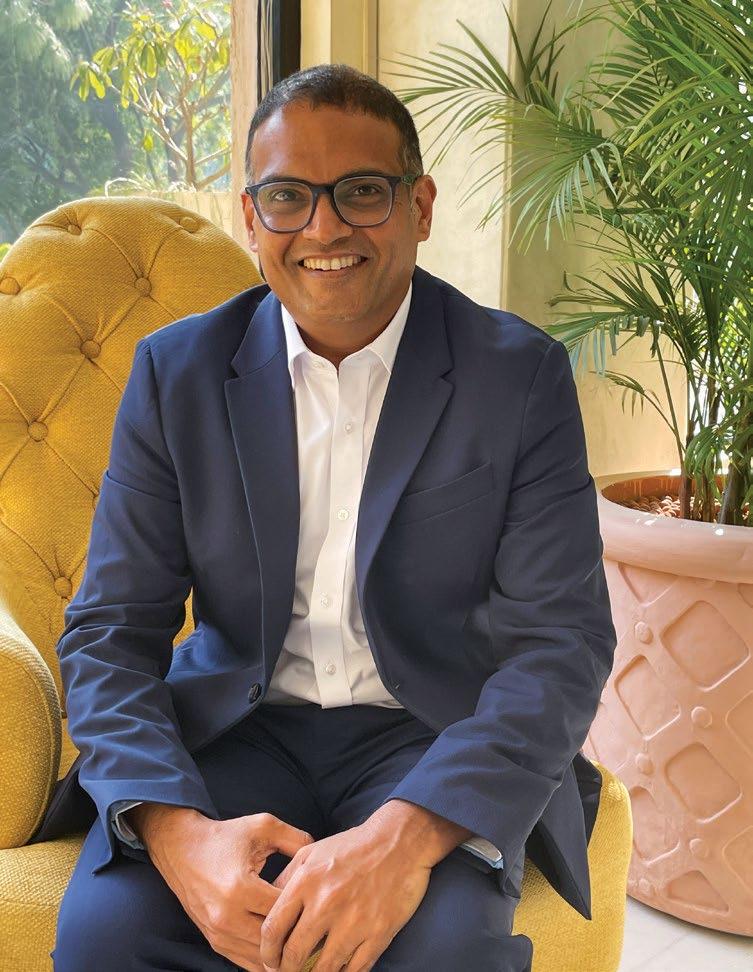
DEVENDRA
PARULEKAR FOUNDER, SAFFRONSTAYS
“Microcations—or ‘holiday snacking’—has transformed how we market private villa rentals. Gone are the days when Indian families took long domestic summer vacations. Today, extended breaks are mostly for international travel, leaving weekends and public holidays for short escapes.”
Microcations and wellness: The soul-filling factor
In a world rife with burnout and screen fatigue, microcations are an antidote, say practitioners. The wellness industry aligns perfectly with this trend—from yoga and meditation retreats to spa and nature therapies. These short trips provide vital “lively recharges” to return to daily life with renewed energy and clarity.
Sangam Farms’ Jain stresses that optimising relaxation and rejuvenation is key to any microcation experience: “No rushed itineraries, no packing stress—just immersive, soulful stays that feel like a genuine holiday, not a ticking clock.”
Le Méridien’s ‘The Great Delhi Do Nothing’ epitomises this shift: “Travel is less about checking destinations and more about finding small, meaningful moments to pause and reset,” elaborates Bhatia.
The business of microcations: Data speaks
MakeMyTrip data shows a 25% increase in people taking more than three trips a year in 2023 compared to 2019—most are micro-trips or weekend getaways. Most bookings are for couples (51%) or groups/
LEFT: SaffronStays offers expansive villa options located in close proximity to cater to impulse-driven, short-lead bookings. metros to
families (20%), highlighting the social dimension of microcations. Urban metro centres—Mumbai, Delhi, Bengaluru—lead the pack in microcation demand.
India Brand Equity Foundation forecasts India’s travel and tourism industry reaching $23.72 billion this year with nearly 10% annual growth, underpinned by evolving travel patterns like microcations.
How businesses are adapting
Microcations are reshaping the entire travel ecosystem— from airlines and hotels to tour operators and local experiences. Le Méridien, Accor, Sarovar Hotels, Sangam Farms, and Novotel have all tweaked offerings to cater to this demand for shorter, experience-driven stays. Personalised packages, flexible check-in/out, curated local experiences, and even no-agenda staycations are the new normal.
“Direct air connectivity and easy access have played a pivotal role in putting domestic/ shorthaul micro-trips firmly on the radar, with affordability—both land and air—serving to sustain the momentum,” says Rajeev Kale, president and country head (holidays), MICE, Visa-Thomas Cook (India).
Booking.com’s Kumar anticipates 2025 will see microcations becoming mainstream travel behaviour, with younger generations leading the charge and redefining what a vacation means. Sangam Farms’ Jain sums it up succinctly: “Microcations represent the future of travel—a balance of authenticity, relaxation, and time efficiency.”
So, where are you heading for your microcation?
WERE YOU AWARE?
BY DEEPALI NANDWANI

The robot making hospitality fun and futuristic
Otonomous Hotel in Las Vegas is a tech-forward property that leverages AI to deliver extraordinary guest experiences. Its multi-lingual humanoid robots have redefined hospitality roles, transforming operations, interactions, and efficiency in real time. Meet Oto— handling check-ins, towel deliveries, and playful banter in the guests’ preferred language. Japanese, anyone? Or do you want it to speak Hindi or Mandarin?
The science of staying young
Luxury hotels are transforming spas into longevity havens, using science-driven biohacking, personalised health data, and immersive environments to extend ‘health span.’ Fairmont Mumbai's program merges modern tech with anti-aging therapies for vitality restoration. Six Senses Ibiza's Longevity Labs feature DNA-based nutrition, cryotherapy pods, and VR meditation adjusting to heart rate. South Korea's Rakkojae Seoul offers minimalist digital detox cells with guided fasting and sleep optimization. Aman's Janu resorts integrate underwater treadmills and IV drips, making aging tantalisingly reversible.
Parisian luxury that inspired Coco and Hemingway
A spot of hotel history: Dubbed the “king of hoteliers,” César Ritz drew on his Savoy experience to create Hôtel Ritz Paris. With Chef Auguste Escoffier and architect Charles Mewès, he opened the hotel on June 1, 1898, at a star-studded gala attended by Marcel Proust. Innovations included Europe’s first en-suite rooms, 24/7 electricity, and pastel Louis XVI-style furnishings. Coco Chanel lived here for 37 years, using her eponymous suite as a creative hub, while Ernest Hemingway was a regular at the bar, now called Bar Hemingway.
Alba’s autumn feast
Autumn is truffle season in Italy, especially in Alba, home to the International White Truffle Fair (8 Oct–5 Dec). The fair showcases truffles, local cheeses, wines like Barolo and Barbaresco, culinary workshops, and seasonal produce, drawing chefs and food lovers worldwide. The White Truffle Market is at its epicentre. Italy’s fame for white truffles stems from its unique climate, soil, and forests, creating the perfect environment for this rare, aromatic delicacy cherished by connoisseurs globally.


Curated women-only day stays at our iconic hotels. Discover moments of pure bliss. Let the day be all about you.
